Table of Contents
- Preface
- Chapter One - A Brief History of Voting Machines, Certifications, Mail-In Voting, and Electronic Poll Pads
- Chapter Two - Beginning to Audit Our Government
- Chapter Three - Preparation
- Chapter Four - Attack
- Chapter Five - Backup Attack
-
Chapter Six - Defense
- Part of Their Plan?
- 700,000 Reported Absentee Voters Not Connected in SVRS
- Minnesota Post Election Review Reveals Missing Ballots
- A Petition to Stop the Certification of Minnesota’s Election
- Where Are the Cast Vote Records?
- Pushing Back Against Tyranny
- Crow Wing County
- Dakota County
- Wright County
- Morrison County
- Stearns County
- Sherburne County
- Anoka County
- Other Counties
-
Chapter Seven - What We Can Do
- What Recent Laws were Added or Amended?
- What Can Towns, Cities, and Counties Do?
- What is the Simplest Legislative Change at the State Level?
- Local Action
- Small Counties with Great Potential
- Objections to Hand Counting
- How Much Do Machine Elections Cost?
- The County Commission Strategy
- Election Judges Don’t Have Much Control
- Use Your Platform
- Do You Have A Few Minutes Per Day?
- Vote in Person
- Conclusion
- Appendix - A Year in Beijing
- Excerpt: Susan Called to Hearing
Preface
“The stories of these times will be told as all stories are told… around the campfire.”
— Nathan
“Be the change you seek.”
— Andrei
In Minnesota, we have paper ballots, yes, but computer scans of those ballots are counted instead of the ballots themselves. There’s no clear path to reviewing or auditing the digital records and therefore, with ballots and records likely not retained from previous elections, it’s becoming difficult to even say, for sure, what happened. All this has led to the people wanting change.
What change? To a process that everyone can understand and verify for themselves. That would be beautiful, wouldn’t it?
Measureable desire for change was already clear on August 9, 2022. My roughly 90-day Minnesota Secretary of State campaign garnered about 36.8% of the vote (nearly 111,000 votes) running as a republican alternative to the MNGOP-endorsed candidate—after being effectively blocked from the endorsement process—but that was only part of the beginning of my education into the system of control that is our election system.
During the brief campaign, input from political consultants was not sought and no campaign donations were accepted. Instead of a traditional campaign, which allows money to be funneled around and messages to be diluted or tailored to the political machine’s liking, the focus was on education and action. Instead of focusing on events, county commissioner meetings were attended with the people. When invited to speak, in one case by a non-party affiliated group, and another time by an endorsed Republican candidate, uniparty operatives tried to influence the organizers, who did not back down to the pressure.
Running on a single issue, to repair elections with a particular focus on the tangled yet sophisticated web of the electronic voting system, was surprisingly simple and welcome. A bulk of the campaign was spent trying to get counties to turn over their cast vote records and ballot images; only one Minnesota county did for 2020 (Fillmore), about a month after I was given the first cast vote record file to my knowledge ever shown to the public, from the Chisago County primary election of August 9, 2022.
At the end of the previous year (2021), Crow Wing County commissioners with great encouragement from the people passed a resolution seeking to audit their county’s 2020 election, a request which Minnesota Secretary of State Steve Simon promptly denied in early January, 2022, keeping the inner workings of the system closed to public viewing.
But even with the above ‘run for office’, I was somewhat late to the game. But there’s no doubt I became fascinated. Maybe my early career work in an IT-adjacent department for a Fortune 100 helped me have just enough understanding about computers to follow the basic plot. Or maybe it was my interest in the tabletop board game Diplomacy, apparently one of JFK’s favorites, where there are no rules against nor to penalize cheating.
My vantage point into the opaque election system had only begun months earlier in an inquisitive way, around summer of 2021, online, through a Telegram group seeking Minnesota’s first true audit. Shortly after joining the online chat channel and volunteering to help out with communications, I was invited to a convention in South Dakota.
I would become one of perhaps only a few dozen people at each of the Cyber Symposium in Sioux Falls, South Dakota in August 2021, The Moment of Truth Summit in Springfield, Missouri, August 2022, and the Election Crime Bureau, Springfield, Missouri, in August 2023. From preparation for, participation in, and reflection on those multi-day events, I learned a great deal and realized how much more there was to learn.
In 2022 I attended a number of county commissioner, city council, and township supervisor meetings in a number of Minnesota counties, such as Dakota, Sherburne, and Wright, as well as various meetings with election officials, county election managers, and clerks included in the normal flow of elections (public accuracy tests in Wright or a canvassing/certification meeting in Hennepin) and sometimes because something had gone wrong (e.g. Dakota’s 2021 school board election).
In late 2022 and into 2023 my focus shifted to the budding group in Anoka County, which later decided to call themselves the Anoka County Election Integrity Team, or simply ACEIT, pronounced “Ace it”. That team became a hub for advocates from a number of counties, including Ramsey, Washington, Hennepin, and between 5 and 7 counties were represented (at the citizen level) for the 2024 Anoka County Canvassing/Certification Board meeting, an example of ACEIT’s impact. The group had educated its commissioners and supported a number of cities in not only asking to be including in the automatic hand count audits (called post-election reviews) but also in one case, the City of Oak Grove, of cancelling their KNOWiNK electronic poll pad leasing contract with Anoka County. ACEIT has done great work to help raise considerable awareness about the increasingly centralized system.
It is a system with many features. Cheating can happen before and after the polls close. Absentee mail-in voting is out of control. Votes can be hijacked from people who didn’t even vote. A ballot inserted into a tabulator won’t necessarily read a voter’s choices accurately. After unofficial results are in and after those unofficial results are made official through certifications at the county and then state canvassing boards, without properly checking the accuracy of the results, legitimate and proper audits—sometimes called full forensic audits—are avoided by the powers that be at all costs.
Indeed, the attempts to block even basic questions being asked has alerted many, many more to the seriousness of the issue. So you’re saying I can’t ask questions, but you’re also saying everything is fine? There’s a moment in Star Wars: A New Hope, where, in the detention corridor command post, while he and Luke Skywalker are in the process of rescuing the Princess, Han Solo decides to blast the communication link because he wasn’t able to answer the questions being asked. “Boring conversation anyway… LUKE, WE’RE GONNA HAVE COMPANY!”
The administrators of elections did get company. A deluge of emails. Phone calls. In-person meetings. And yet, despite the questions and clear demand for openness with respect to public government work and records, as if to demonstrate they’d learned little from the aftermath of 2020, only 1 of the 87 Minnesota counties even released the automatically-generated cast vote record (CVR) reports from Minnesota’s August 9, 2022 primary election. (Or they had learned it was best not to give the people anything to go on.)
Readers may wonder how the solitary report was attained. It was by email in PDF format from Chisago after a phone conversation, whose county election manager had promised to provide the report (but not the ballot images, which the computers read to interpret the vote tallies) after admitting election records from 2020 were not retained the federally required 22 months thanks to a Hart vendor software update seemingly quite similar to the Trusted Build that led to the Tina Peters story in Mesa County, Colorado.
Like any election, without a full forensic audit of ballots, ballot envelopes, election equipment, and registration systems, the integrity of the systems, process, and results can never be confirmed by the voters, which was reason enough for countries like Germany to do away with electronic voting equipment altogether. Many countries have banned both mail-in voting and electronic equipment, for obvious reasons, but reasons that will be unpacked in this book.
A friend asked me in early 2024: How unreliable do we want our elections to be?
Fifth graders, who cannot lawfully vote (yet)—although 16 and 17-year olds are now pre-registered in Minnesota—should be able to understand how votes are counted. From the optimistic viewpoint, we are poised as a country and state to return to manual hand counting and tallying of paper ballots (which fifth graders could understand) in small, manageable precincts on election day. Examples from France to Taiwan are there for us to learn from if need be. Mail-in voting could be outlawed and voters will have to show some form of identification to prove citizenship and local residence to receive a ballot. Then everything gets counted by humans under video surveillance (even livestreamed) for anyone to watch or review after the fact.
The simplicity of this overall approach, and its extremely low cost, when considering many have and will volunteer for such a service to their local city, town, or county, will make future generations frown in disbelief at how we even went down the insecure electronic road (combined with mass mail-in) and indeed how long it took to right the ship, to reclaim control over our government, a necessary task given larger issues of contention to come.
To distract from genuine reports from citizen journalists depicting this lack of transparency and obstruction of public data releases, election corruption deniers—starting with the mainstream media—endlessly parroted and continue to repeat tired talking points. Safest and most secure! Not connected to the internet! A perfect election! So effective is their repetition that some come to believe their banal lies. The narrative is very important. Propaganda, with the current tools, is VERY cheap, especially to a population that on balance does not think, that is meanwhile addicted to propaganda. A neighbor recently said, “The election is over.” Maybe that’s what they want you to think.
So strange is this effect that it might be compared to Mr. Smith taking over a civilian’s body in The Matrix. Most election clerks and auditors robotically claim they are following election law and election guides from the secretary of state—some making these remarks with a smirk on the edge of their mouths—while withholding basic data requested from their offices in violation of data practice laws. This effect is so odd that one can start to seriously consider whether AI-implemented mind control tech has not already been rolled out en masse, or if indeed the thought of upsetting one’s superiors, or the electronic vendor, is too much to bother with.
And still potential allies ask, Where’s the proof?
But we can counter… Were there ever any actual problems with a simple hand count of paper ballots in small precincts? Was the purpose of more technology concentrated in a handful of companies really to make our elections less transparent? Less comprehensible? With databases like the voter rolls and registrations and poll worker data increasingly centralized in the hands of secretaries of state? (And in cases like Konnech, Inc., alleged to be stored on Chinese servers, whose product, PollChief, operates in cities like Minneapolis and used to, in cities like Detroit, where the revelation caused backlash and cancellation.)
Or could it be that the intricately connected companies and organizations comprising the election process like Runbeck, Dominion, Election Systems & Software (ES&S), Scytl, Edison Research, ERIC, Konnech, BPro, and KNOWiNK (and all the various private entities and sources of funding) be exactly what it looks like?
In 1910 men representing a quarter of the planet’s wealth secretly met on Jekyll Island to prepare the way for The Federal Reserve Act of 1913 (originally the Aldridge Act, which was then copied from the opposing political party), which Minnesota’s Charles A. Lindbergh Sr. opposed, suggesting its passage meant selling the nation’s children and grandchildren into slavery.
The Federal Reserve Act of 1913 established a banking cartel. What we are witnessing now is the exposure of the election cartel and all its players, who play for keeps.
At day’s end the illusion of a functioning election process is just one of many programs to uninstall from society, alongside global financial controls like the Fed and central banks, medical tyranny orchestrated by the WHO and its allies, the captivity instantiated by one’s USA Inc. birth certificate and social security number, and the daily chem trails threatening all of Life.
This deprogramming, deconditioning, and cleanup is necessary because the current settings enable too much harm to be done, especially to those who cannot protect themselves, like children.
The first edition in 2022 of this book was written quickly during the SOS campaign and contained many mistakes. (The second edition edited in even less time, 2024, with this quick update occuring on a single day, March 9, 2025.) Thankfully readers were forgiving and even shared it both with one another and with their county commissioners, making it an uncensorable resource for truth and an antidote to wilful ignorance and plausible deniability. Indeed, one of the commissioners shown this resource in 2022 in early 2025 voted against the purchase of new KNOWiNK electronic poll pads. Even though he was on the losing side of the vote, that commissioner showed he was listening and working to improve things from his position.
In this now third edition, corrections have been made and updates are offered in the following areas—lists for 2nd edition and 3rd below:
3rd edition
- missing information related to the Trojan horse of Minnesota elections, the electronic poll pad software system from KNOWiNK, a 3rd party private vendor with considerable access to election data, with the capability to monitor and modify data
- a revised and focused ‘What We Can Do’ (Chapter 7) for 2025 and 2026, especially for city councils and town boards, consider The Oak Grove Way (paper poll books, process own absentee ballots, and hand count audit)
- emphasis on contributions from Suan Smith and Rick Weible - see bonus chapter, excerpt from forthcoming book featuring Susan and Rick
- general updates for clarity and relevancy to 2025 readers
2nd edition
- repositioned the history of voting machines (Chapter 1)
- a clarification about cast vote records and ballot images (Chapter 6)
- added county-level field notes, observations, and suggestions from a few Minnesota counties, in particular for Stearns and Anoka (Chapter 6)
- added a new chapter, What We Can Do (Chapter 7)
- commentary on newly added or amended Minnesota Statutes (Chapter 7)
- anecdotes and snippets from meetings and conversations with grassroots leaders country-wide (throughout)
- moved the anecdote about living one year in Beijing (Appendix)
- included Susan Smith’s post-trial brief relevant to all Minnesotans (Chapter 6) - read the brief now right here as well as a FICTIONAL version as an excerpt from an upcoming book
As a mentor has said, the stories of these times will be told around the campfire, passed down from generation to generation. Please bear that in mind as what is shared in this book comes merely from my experience, a way to put my observations, recollections, and insights into readers’ hands.
Therefore, do not take anything here as authoritative but rather take the information on board to consider and to verify for oneself. It is sometimes hard but often refreshing to discover one has been quite wrong about something. If only to take responsibility for any harm done and to prepare to learn the next thing one is wrong about or about which he had barely even considered.
It’s been quite the journey, hasn’t it?
And there is much more to do.
Erik van Mechelen
March 9, 2025
Chapter One - A Brief History of Voting Machines, Certifications, Mail-In Voting, and Electronic Poll Pads
“There’s no way we can ever trust a computer system built with components made overseas, particularly in China, or assembled in China, let alone both, and that’s what we have in our voting system, unfortunately.”
—Col. Shawn Smith, USAF, Ret. – 25 year Air Force veteran and the former director and test manager for the operational testing of complex, computer-based weapon systems and a subject matter expert on the security of computer-based election systems, calling into a Tarrant County, Texas meeting
In the first place, how did we get to using machines, and electronic voting machines, in elections?
Before voting machines, voting was often done by voice throughout the 1800s. Kentucky used voice voting until 1891. The first paper ballots arrive in the early 19th century.
Then came voting machines: first lever, then punch cards.
Lever voting machines have been around a long time.
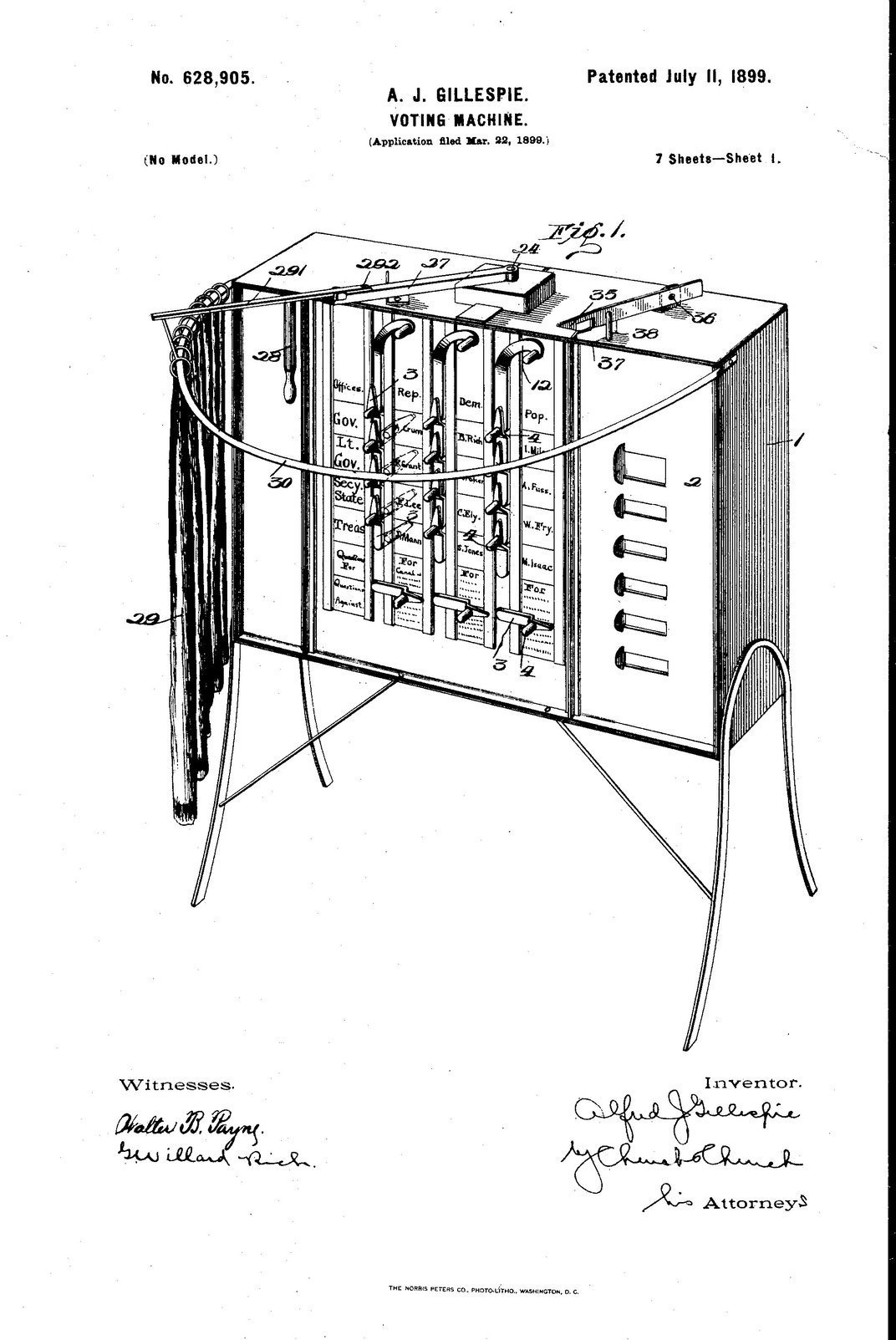
Here’s a physical example:
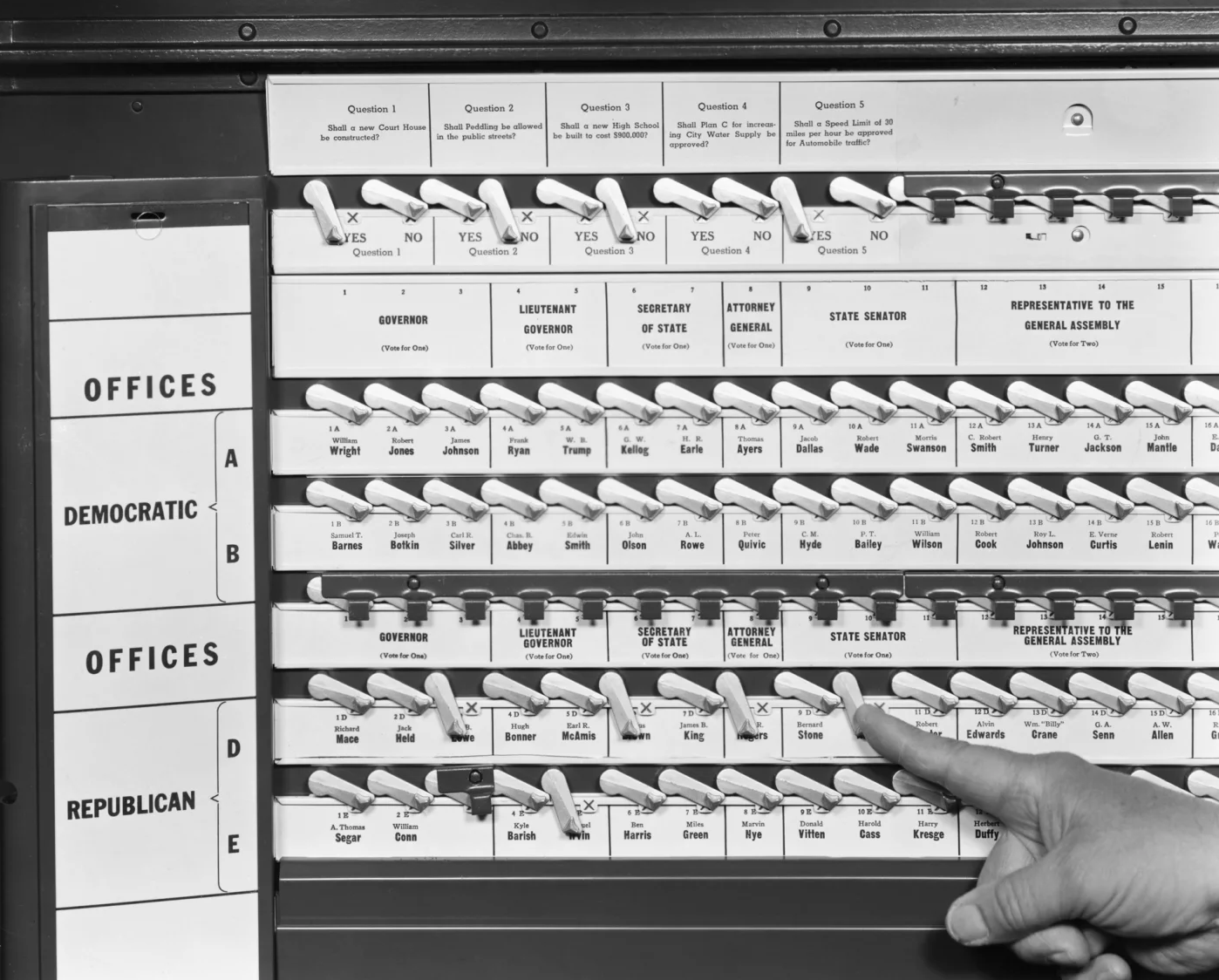
Punch card systems were developed in the 1960s and were last used in two Idaho counties in 2014, on the Votomatic provided by ES&S.
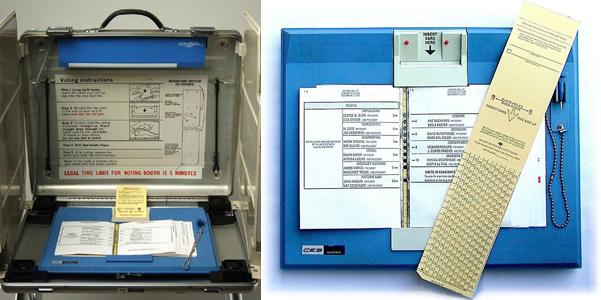
Fast forward to the 2000 presidential election between Al Gore and George W. Bush. Hanging chads on Sequoia Voting Systems punch-card voting system led to a recount, which Bush won.
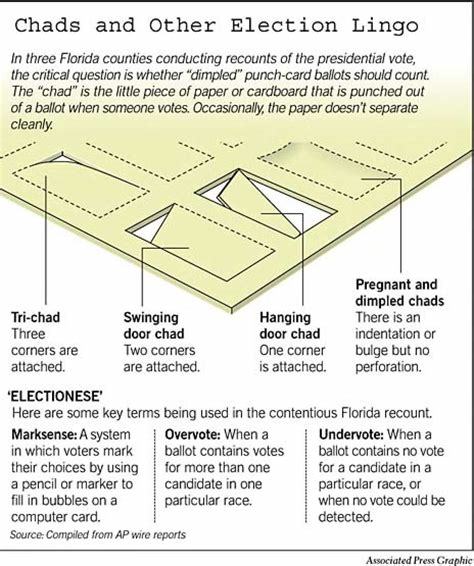
Sequoia Voting Systems got its start in the 1970s as Mathematical Systems Corporation of Anaheim, California, offering an alternative to ES&S’s Votomatic punch cards. On March 8, 2005 Smartmatic Corp. (a Venezuelan company) acquired Sequoia. This raised eyebrows since Smartmatic had only the previous year been selected to by the Chavez-era Venezuelan government to provide voting systems for the presidential recall election, its first time providing machines for an election. Since June 4, 2010, Smartmatic’s parent company has been Dominion Voting Systems.
Dan Sundin summarizes Smartmatic well:
“Smartmatic was founded in 1998 by three Venezuelans, Antonio Mugica, Alberto Anzola, and Roger Pinate. Initially they developed ATMs in Mexico, but the U.S. presidential election in 2000 led the group to consider electronic voting platforms. Venezuelan strongman Hugo Chavez’s government gave the company an early loan and its first contract for election machines in 2004. The following year, Smartmatic bought Sequoia Voting Systes, but after a U.S. Department of Justice inquiry, Smartmatic sold Sequoia in 2007. More recently, Smartmatic has become a political lighting rod in the Philippines, with some politicians accusing the company of marketing faulty equipment and orchestrating election fraud.”
Back to 2000. According to Sequoia’s own employees, Sequoia may have been responsible for the defective punch cards in Florida which led to “hanging chads” or undervotes to the tune of 10,000 in Palm Beach County.
One of Sequoia’s workers told Dan Rather:
“My own personal opinion was the touch screen voting system wasn’t getting off the ground like that they—like they would hope. And because they weren’t having any problems with paper ballots. So, I feel like they—deliberately did all this to have problems with the paper ballots so the electronically voting systems would get off the ground—and which it did in a big way.”
Specifically, USC 52 Ch. 209 Subchapter I—PAYMENTS TO STATES FOR ELECTION ADMINISTRATION IMPROVEMENTS AND REPLACEMENT OF PUNCH CARD AND LEVER VOTING MACHINES. §20902 states: Replacement of punch card or lever voting machines.
Sequoia benefitted from the passage of federal legislation in 2002—the Help America Vote Act of 2002—because they manufactured electronic voting equipment.
In 2003 Beverly Harris found Diebold’s source code on the internet. Diebold had only entered the elections business a year prior through its purchase of Global Elections Systems, a touch-screen voting technology producer in Texas. The source code revealed that Diebold voting systems used an unsecured access database, meaning anyone could access, change data, and erase logs.
In 2007 Diebold Election Systems rebranded as Premier Election Solutions and in 2009 they sold to Election Systems & Software (ES&S), which by 2014 was the largest manufacturer of United States voting machines (and still used in the majority of Minnesota counties).
The Source Code Review of the Diebold Voting System was published by 6 authors on July 20, 2007, showed the system was 1) vulnerable to malicious software, 2) susceptible to viruses, 3) failed to protect ballot secrecy, and 4) vulnerable to malicious insiders.
More recently, one of the authors of the Diebold review, J. Alex Halderman of Princeton University, provided the Halderman Declaration on Georgia’s ballot marking devices (BMD). Halderman has also issued a sealed 25,000-word report on voting systems vulnerabilities.
In an emergency meeting in Otero County, New Mexico in May 2022, nation-state vulnerability expert Jeff Lensberg provided further vulnerabilities, some of which he’d uncovered previously in the Antrim County, Michigan investigation. Of particular concern was his vote switching demonstration.
Putting the History in Context
The history of voting machines spans over 100 years. However the use of electronic voting machines is very short, only two to three decades. During almost the entirety of that duration, the electronic systems have been shown to be insecure, hackable, and manipulable, sometimes if not often by design.
If access can be gained, whether remotely, over a network, or through the internet, and once inside the machines or databases are configured to be manipulable, then there is ample room for subversion. Even if internet connectivity could be proven not to occur (it has been shown to have occurred), should citizens trust machines that have disturbing baked-in features?
The lack of certifications (and the uselessness of certifications) of voting machines is further troubling.
In the Tarrant County, TX, in the first half of 2022, Col. Shawn Smith describes why:
“…And for the people who said well, the machines are certified, I would say, the space shuttle Columbia was also certified for flight. How’d that turn out? The Boeing 737 Max was certified for passenger operations, and then crashed killing over 500 people in two separate accidents before they finally let experts take a look at it. And my point in saying that is not to try to scare people, but just to say that based on my experience, and I’m not a cyber professional, but I work with cyber pros, and I know the difference between somebody who knows cyber and somebody who doesn’t. And if you don’t know the difference, then you’re in very dangerous territory when you try to make any conclusions or try to listen to someone who doesn’t really know what they’re talking about.
“Our voting systems from my perspective based on the expert examiner’s report, cannot be trusted with our election. And what they require in order to for you to verify for yourself is that you become a cyber expert. Otherwise, you’re forced to trust other people who say they’re experts, people who have conflicts of interest, and people who’ve been trained essentially by the National Association of Secretaries of State, the election directors, and the Election Assistance Commission…”
Certifications Are Less Than Useless
Clay Parikh was an expert witness in the 2024 Georgia hearings where he demonstrated how to subvert the database of an election system, one of a couple thousand ways to skin the cat, as he said on record. Parikh worked at one of the EAC’s testing labs for about 9 years and told David Clements in an extended interview for the documentary, Let My People Go, that the security of the elections systems was 0.5 out of 10, because he couldn’t with honesty give them a 1.
Throughout its certification process, the Election Assistance Commission (EAC) which was established by the Help America Vote Act (2002) has not certified about 95% of Minnesota counties.
Those county’s electronic voting equipment are merely certified by the Minnesota Secretary of State, even though similar testing labs are used. The few counties that are EAC certified have the problem indicated by Col. Shawn Smith, that those certifications provide the illusion of security when in fact those systems are anything but ready to run secure elections, and by the EAC certificate’s own language not an endorsement of the products.
(The same illusion exists with Minnesota being a ‘paper ballot’ state. We have paper ballots, but do we count paper ballots? By default, No. Indeed, the tabulators take a picture through their scanning technology, and then these computers read the digital image, also known as a ballot image, to document the voter’s oval selections. However, audits of these selections are never done as part of the normal post-election review process, a serious gap in the public’s knowledge and ability to provide oversight on the MNSOS’s reported results.)
Back to certifications… Let’s take a look at the certification maps. Remember, being certified or not certified doesn’t guarantee system security, as we shall discuss shortly.
In the following image, Red = Certified | White = Not Certified
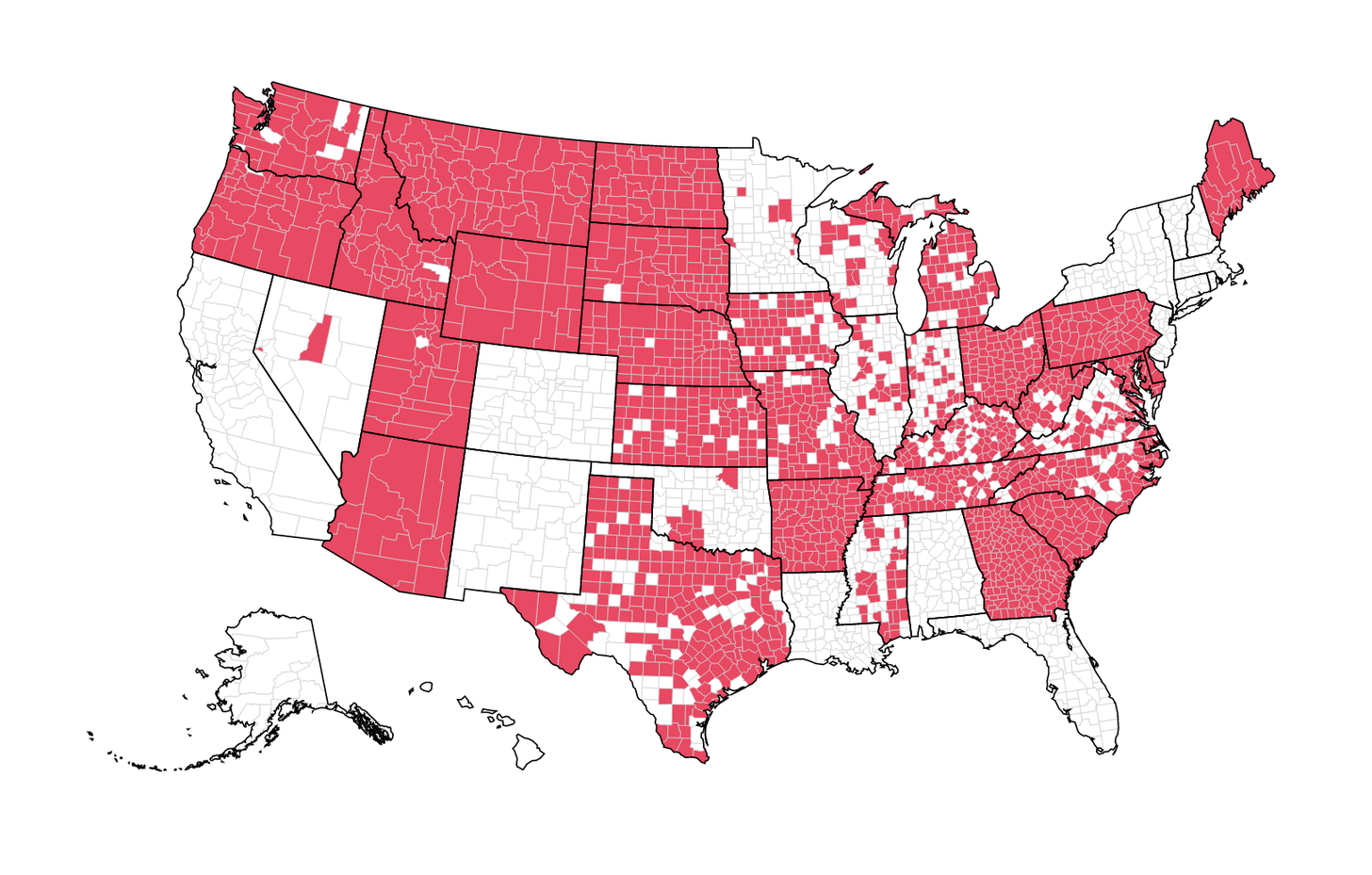
If we zoom in on Minnesota, we find that only 6 of 87 counties have voting equipment that is certified by the EAC. Remember, red counties are certified, white are not certified.
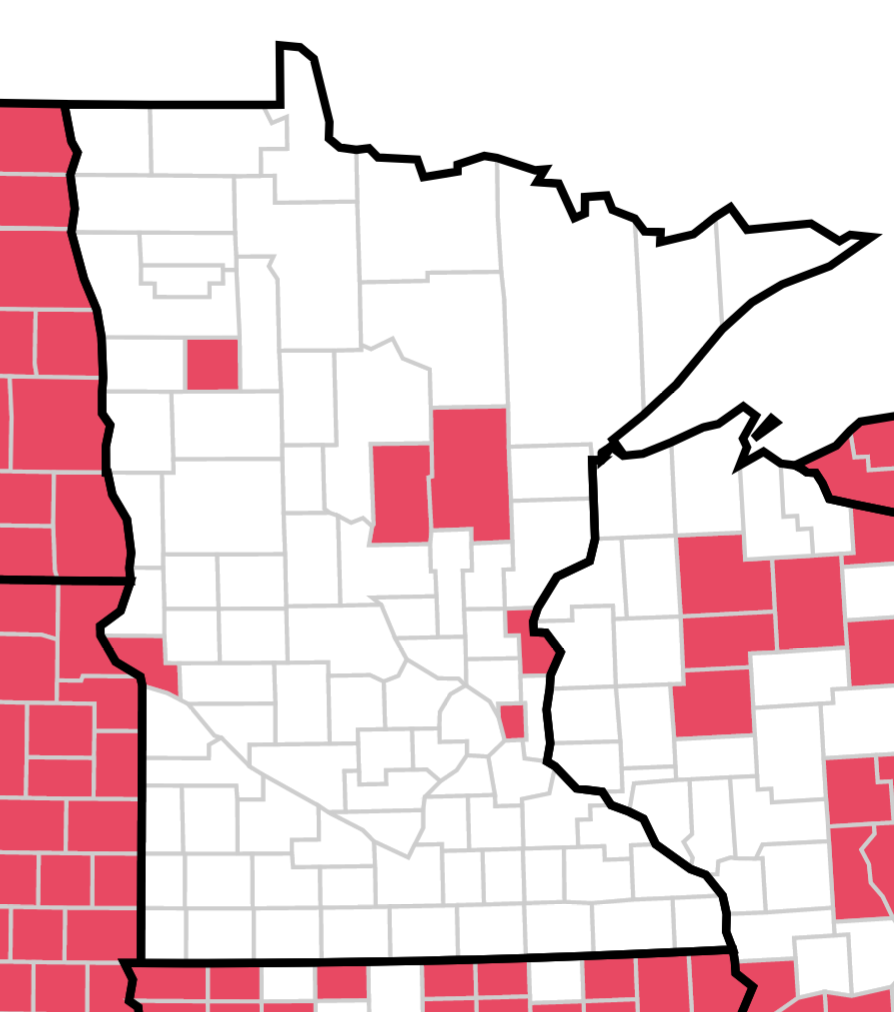
Here are the counties in Minnesota that were certified by the EAC as of April 2022:
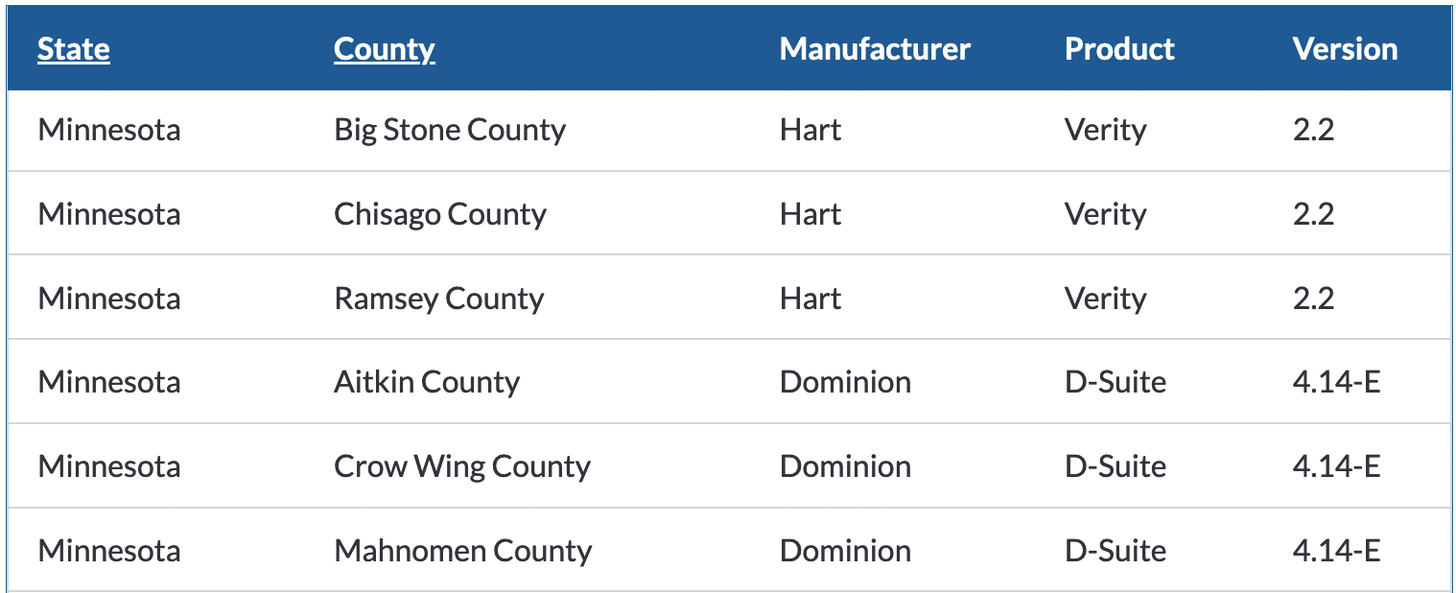
Thinking that this felt off, I called the EAC and left a voicemail and sent a question by email, which was replied to the same day (04/20/2022).
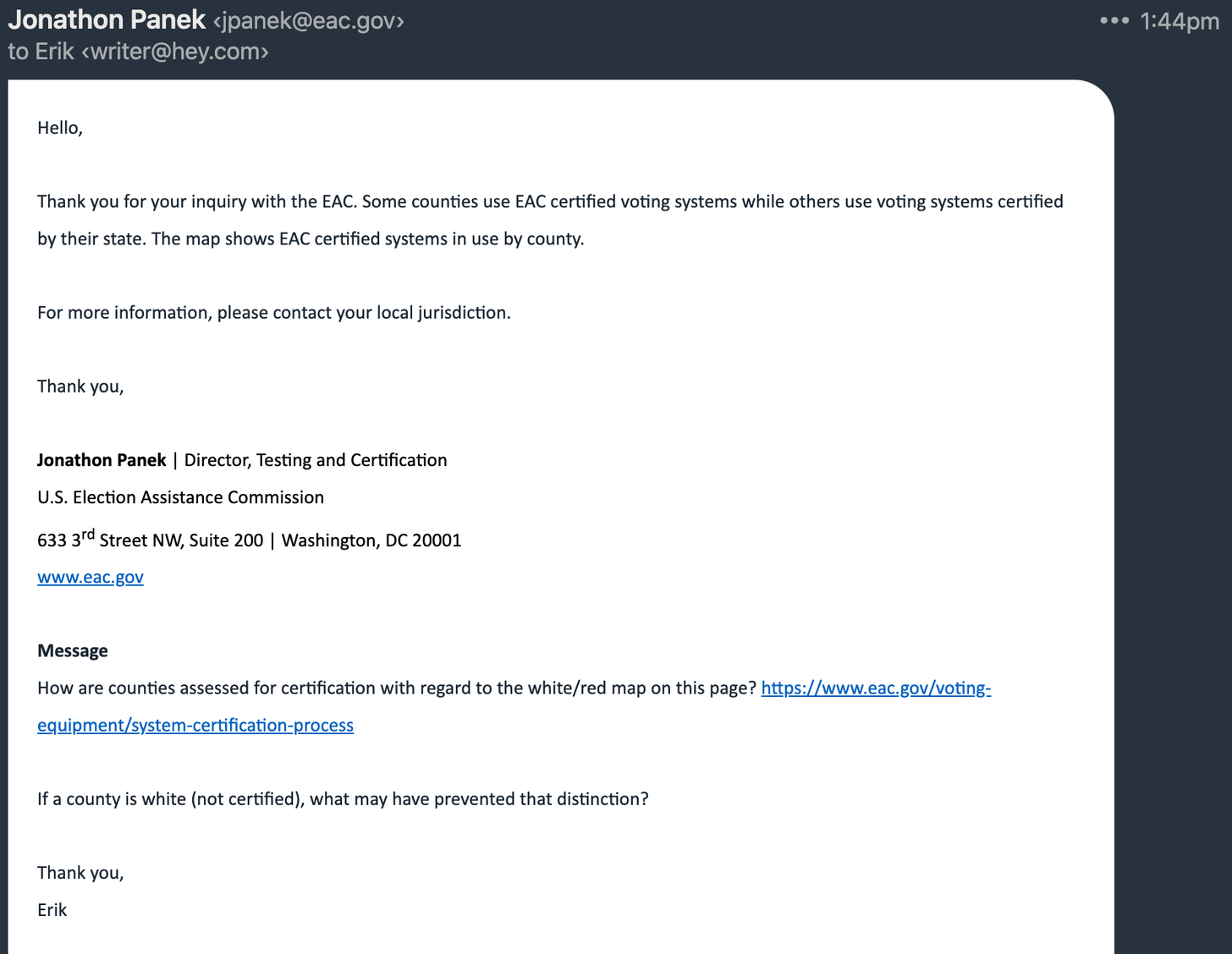
This may have been comforting if not for a close reading of Minnesota election law.
Minnesota Statute 206.57, Subd.6 states in full:
Subd. 6.Required certification.
In addition to the requirements in subdivision 1, a voting system must be certified by an independent testing authority accredited by the Election Assistance Commission or appropriate federal agency responsible for testing and certification of compliance with the federal voting systems guidelines at the time of submission of the application required by subdivision 1 to be in conformity with voluntary voting system guidelines issued by the Election Assistance Commission or other previously referenced agency. The application must be accompanied by the certification report of the voting systems test laboratory. A certification under this section from an independent testing authority accredited by the Election Assistance Commission or other previously referenced agency meets the requirement of Minnesota Rules, part 8220.0350, item L. A vendor must provide a copy of the source code for the voting system to the secretary of state. A chair of a major political party or the secretary of state may select, in consultation with the vendor, an independent third-party evaluator to examine the source code to ensure that it functions as represented by the vendor and that the code is free from defects. A major political party that elects to have the source code examined must pay for the examination. Except as provided by this subdivision, a source code that is trade secret information must be treated as nonpublic information, according to section 13.37. A third-party evaluator must not disclose the source code to anyone else.
It is important to note that as of now there are no other appropriate federal agencies outside of the Election Assistance Commission (EAC), which itself authorizes Pro V&V and SLI Compliance.
Bonus: As a reminder, check out the documentary film Let My People Go, free online, where Professor David Clements interviews Clay Parikh, who worked in the testing labs, where he describes the certifications as providing 0.5 out of 10 because he couldn’t honestly give them 1 out of 10.
Are There Limits to Certifications from the EAC?
Let’s take a look at the EAC certification for Dominion 4.14-E.
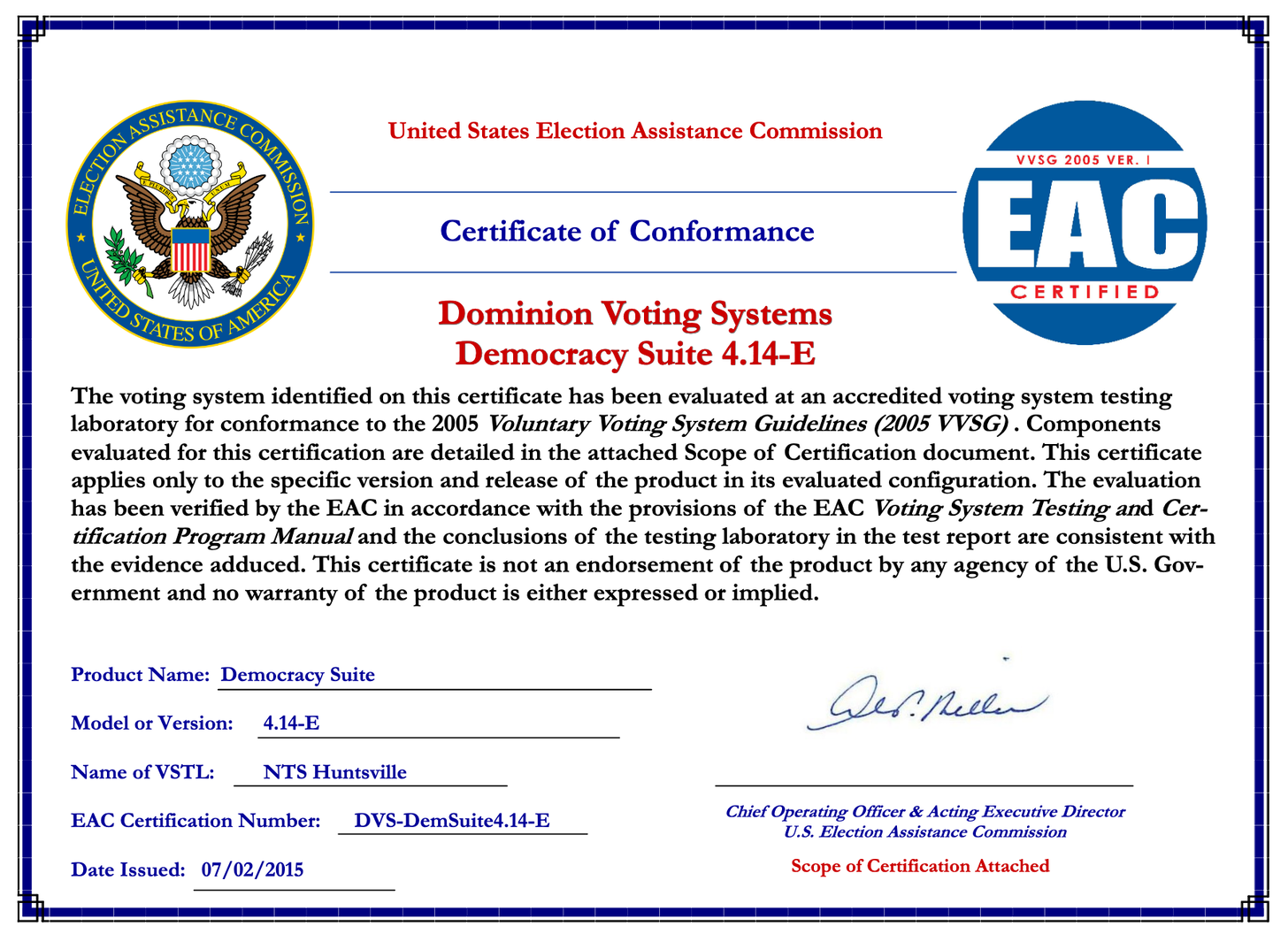
On page 1 note the last sentence:
“This certificate is not an endorsement of the product by any agency of the U.S. Government and no warranty of the product is either expressed or implied.”
On page 2 it reads:
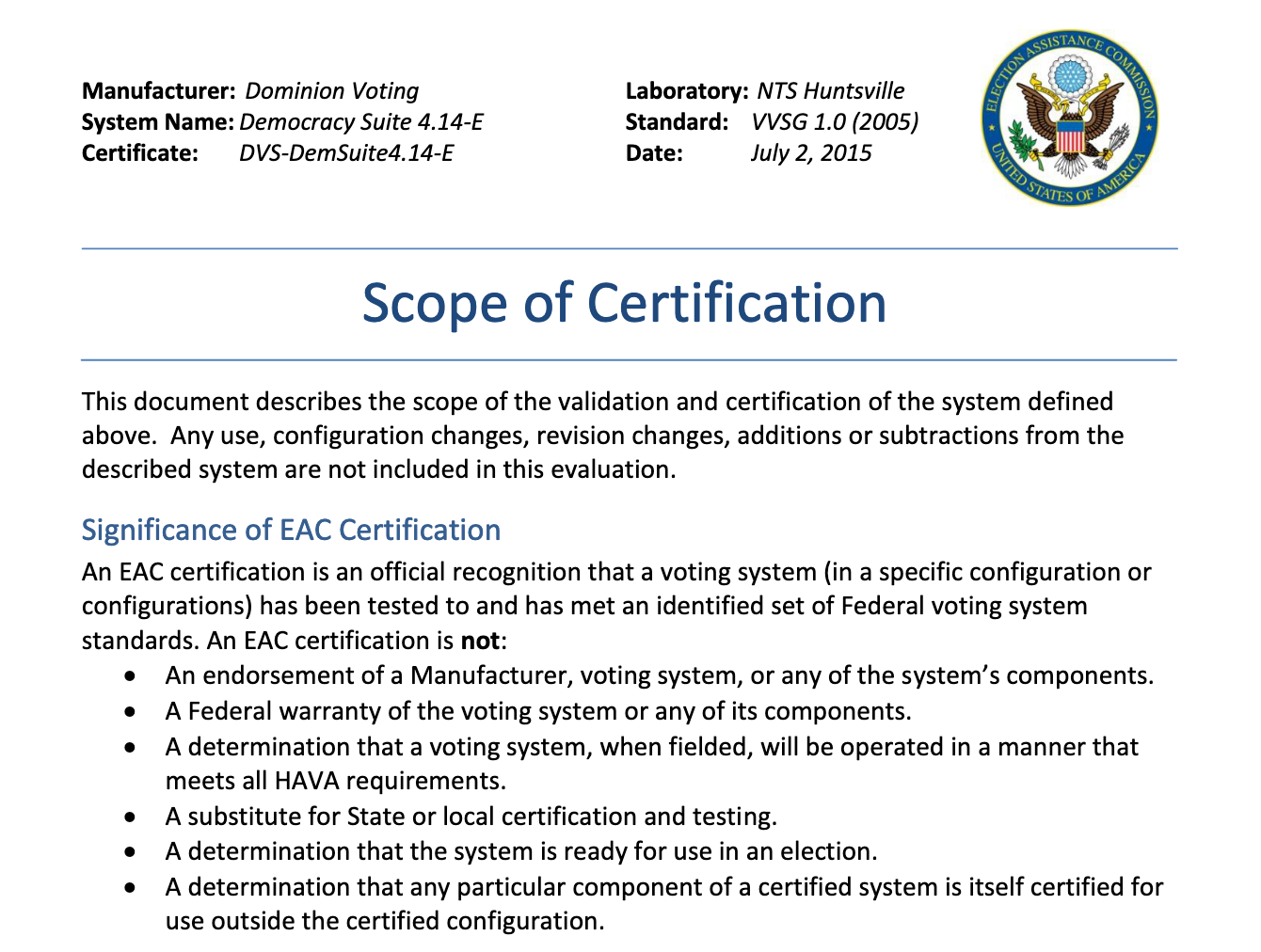
Note the second to last bullet point in “Significance of EAC Certification”:
“An EAC certification is not: A determination that the system is ready for use in an election.”
Then what might these certifications be for?
Are they meant to give the public a false sense of security?
Finally, compare the full 14-page EAC certification to the State of Minnesota Secretary of State Certification of Dominion Democracy Suite Version 4.14-E Voting System reproduced below:
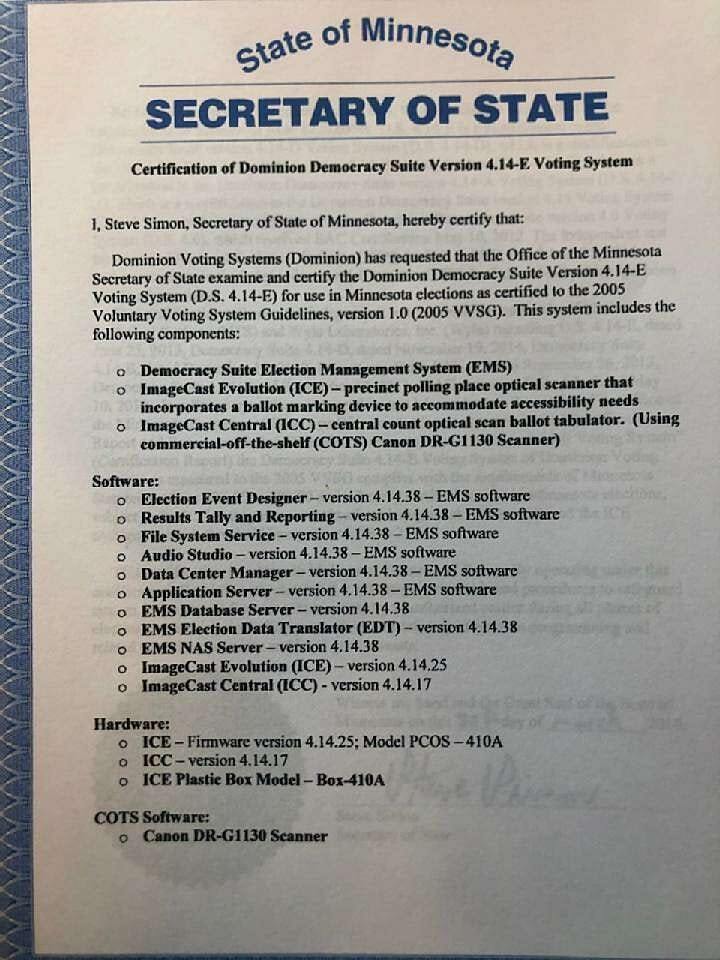
And page 2 of the same:
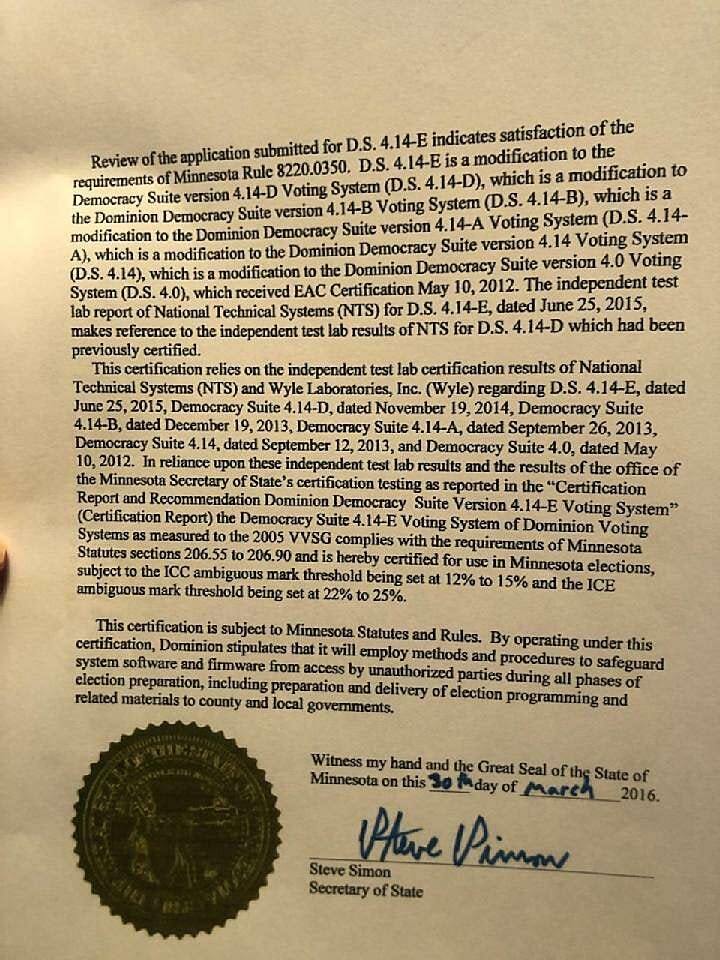
What did you notice?
It reads very similarly, sometimes verbatim, to the EAC’s certifications, which the EAC admits do not indicate a voting machine is ready for use in an election. If the secretary of state is using much of the EAC’s language to describe the certification, and the EAC certificates themselves say they are not a determination of whether a system is ready for use in an election, how then did the secretary of state deem them ready for use?
Should the public have questions when 81 out of 87 counties in Minnesota DO NOT have certified election equipment according to the Election Assistance Commission, which under Minnesota Statute 206.57 Subd.6 those election machines should have prior to use?
Are there consequences to certifications (the EAC certifications) which have disclaimers putting the value of the certification itself into question? Should we be concerned when our secretary of state basically copy-pasted the EAC’s certificate language into his own machine certifications?
Mail In Voting
No-excuse mail-in began was passed into law in 2014 and went into effect in 2015 leading to large increase in absentee/mail-in ballots and votes. Steve Simon, at the end of his 10 years from 2005-2015 as a House Representative for District 46B, sat on the Legislature’s Election Committee, where the No-excuse mail-in was proposed and drafted. He would have additional influence into the early and mid-2020s as well, in particular legislatively with the Voting Rights Act of 2023 and locally with providing specific guidance to prevent information spreading about the true nature of the electronic poll pads, from KNOWiNK, first introduced in 2016 in Hennepin County.
- A 1987 law made it possible for precincts to switch to mail-in only
- In 2016 the thresholds from 1987 were lowered; outside metro precincts with fewer than 1,000 registered voters, metro areas with fewer than 400, could opt for mail-in only
- There are currently 1,000+ precincts (out of 4,000 statewide) whose voters may only vote by mail (mail ballots can be hand-delivered, but no in-precinct election day voting allowed)
When mail-in voting is outlawed federally it will go a long way to setting the tone for serious legislative reforms toward free, honest, and fair elections with warranted trustworthiness.
If we continue the status quo where such a large proportion of ballots (and votes) come through a process that lacks basic chain of custody, then who is to say how many of the ballots are indeed legitimate or not?
Electronic Poll Pads
Why are the MNSOS, multiple attorneys, and county level auditors and election managers so desperate to have these iPads, while answering very few tough questions about the software embedded in them?
In late 2024 I was put on hold for about five minutes at the Office of the Secretary of State (OSS) for asking a simple question about electronic poll pads, only to be transferred to someone who then deferred me to yet another person who did not answer the phone and did not call me back.
My recent look into Hennepin County’s KNOWiNK contracts stalled when it was relayed to me that the “No responsive data” was returned because the Hennepin County Attorney was included on the emails I’d requested between KNOWiNK, OSS, and Hennepin County, allowing attorney-client privilege to block public access.
I do not know anyone who has reviewed the KNOWiNK source code, nor am I likely to find somebody who has, given that KNOWiNK is a non-governmental organization (NGO), a 3rd-party, private vendor. Despite the integral nature of their hardware and software to local, state, and nationwide elections, and despite the fact that KNOWiNK’s iPads are either wi-fi connected or cellular connected (still internet), and are therefore vulnerable to remote access, the Elections Assistance Commission is not required to certify the equipment or software in order for it to be fit for elections in Minnesota—the Minnesota Secretary of State determines that.
My suspicion of electronics, computers, and many things digital dates from my days working for a Fortune 50 in Minneapolis. I had landed in this particular area of the company by mentioning to the hiring manager the development of an iOS app (for iPhone and iPad) that a small team and I designed and implemented in 2013. My job was primarily as a liaison between several business departments and the IT department, at the time when the company experienced a well-publicized data and security breach where hackers gained remote access to Target’s servers: the hackers exploited first the HVAC system and then slipped executable files through a web portal which granted them remote access, eventually compromising data of 70 million customers, including 40 million credit cards.
The Cost of Secrecy
I am not the only one suspicious of these KNOWiNK devices.
Minnesota’s first rollout of the KNOWiNK electronic poll pads occurred in Hennepin County in 2016, where the Mayor of St. Bonifacius, during the product presentation, within mere minutes hacked the system and didn’t like the contract (which said if harmful code was embedded, then the county would not be liable), and his council voted not to use the iPads, leading to him being threatened with a lawsuit (which did not deter the council); St. Bonifacius became the only municipality of more than 40 in Hennepin, Minnesota’s largest county by population to use pen and paper to check in voters on election day.
By 2018, much of Minnesota quietly received the KNOWiNK iPads and embedded software, except for those areas with poor internet service.
The bigger question, though, might be less related to the fact of internet connection than what exactly such a connection might enable, even if the hardware or software worked as designed on election day without any security breaches.
On this path of thinking, it is to be noted that the widespread readiness of these electronic poll pads was just in time for a significant 2018 midterms and the nationwide presidential election two years later. In 2020, the availability of the electronic poll pads coincided with, in Minnesota, the unconstitutional route taken through LaRose v. Simon and NAACP v. Simon (Simon fully participating) to waive absentee mail-in vote witness signature requirements AND extend the acceptance deadline.
At 3:57pm on election day, 2020, the Minnesota Attorney General tweeted that ‘we don’t have all the votes we need quite yet’ and went on to recommend people get their friends go vote. It is conceivable that, combined with the already-collected absentee voting data from the 46-day absentee period, that the real-time access on election day itself—through the electronic poll pads acting as eyes and ears—provided Ellison information prompting him to post a tweet, which in turn may have activated certain levers such as additional absentee ballot dropoffs to later be reconciled with voters who had not voted, although this reconciliation took considerable time…
The biggest fact about Minnesota elections from 2020, that never became a headline, from any outlets, was that there were 700,000 MORE votes than voters on November 29, 2020, according the Statewide Voter Registration System (SVRS), which is managed by the Minnesota Secretary of State Steve Simon, five days after he and the other four members of the MN State Canvassing Board looked past this glaring fact to certify the election anyway. I myself did not learn this until attending a presentation first from Rick Weible (in 2021) and then from him and Susan Shogren Smith (in February 2022), in my mind the ONLY attorney in Minnesota to truly and fully stand with the people demanding transparency in government-administrated elections as documented by the petition to stop the 2020 certification on account of the missing voters and other irregularities, which was never heard by the Minnesota Supreme Court based on their dismissing it using a lame procedural tactic.
Reviving Suppressed Technology: Pen and Paper
The lack of transparency, including deliberate obfuscation in certain cases, are instances of irregularities that arouse yet further doubt in the officially stated purpose for having these devices, which is merely primarily to check in voters.
In a January 22, 2025 letter to cities considering e-poll pads, Rick Weible, the mayor who successfully defended his city’s voters from the initial release of KNOWiNK in 2016, wrote: “You should know what you are signing up for, remember paper poll books cannot be hacked remotely since they for sure cannot be connected to a Wi-Fi, internet, or any network.”
More recently, two (2) cities in Anoka County, Oak Grove and Ramsey, have cancelled their contracts, and now election managers, county attorneys, and the MNSOS are arguing that those cities are somehow still required to use them, seemingly ignoring Minn Stat §201.225 which refers to authorization in subdivision 1 and the revoking of usage in subdivision 6. If there is no choice for cities (or indeed counties), then the 95th Minnesota Legislature should clarify, just as the 93th Minnesota Legislature clarified unconstitutionally to require the usage of electronic tabulators for those precincts that previously used them (unconstitutional by ex-post facto). (Then, in 2024, the 94th Minnesota Legislature made it extremely difficult to hand count by inserting language that ballots must be sealed immediately after the close of polls.)
At the end of the day its an iPad with cellular service and 3rd-party software. How is that ever going to be more secure than paper at the local precinct? —Derek Lind, RamseyAnoka County commissioners are considering buying yet another batch of iPads from KNOWiNK on February 25, 2025, despite many good reasons NOT to (video: Ramsey), while other counties that don’t yet use them, like Isanti, are also being offered the hardware and software.
One wonders whether paper and pen are being equally considered.
Chapter Two - Beginning to Audit Our Government
“Since we know what we will find when we do our audits—”
“That we’ve been duped.”
“Yes, so what’s stopping us from reformulating our election processes as you described earlier and then immediately calling for new elections?”
“Nothing.”
—From a conversation between Col. Phil Waldren and the author inside The Military Heritage Alliance around 6pm on Day Three of Mike Lindell’s Cyber Symposium in Sioux Falls, South Dakota on August 12, 2021
This was how I joined one of America’s largest investigations and audits of its own government, which would continue into 2025 with such initiatives like DOGE and continued efforts locally.
It was evening on October 13, 2021 at the Ramsey City Hall. (Exactly five years after Trump’s “this is a crossroads in the history of our civilization” speech on the campaign trail.) Incredibly, almost a year had passed since November 3, 2020, and my education was only just beginning: finally, I’d decided to attend an in-person event about the election problems in Minnesota. Only two months prior, I’d become much more interested in how to help locally after learning from others at the August 2021 Cyber Symposium.
Pushing through the doors of the city hall and finding the conference room, I soon met Teri Dickenson, who was organizing this ‘I Thought I Voted’-sponsored event, where Rick Weible would soon present. The videographer was missing, and since there was a newly-purchased video camera hanging around my neck I offered to take his place. I was new to this, though: from a chair near the front, stage right, without a tripod, the camera shook a bit in my hands as Rick began to speak.
Before and since, to a variety of audiences, Rick has described himself as a tax refugee from Minnesota, living just over the border in South Dakota. In the aughts and teens, he was on the city council and then mayor of a small town, St. Bonifacius, on the edge Hennepin County, MN. In 2016 hacked into the converted iPads during KnowInk’s epollbook pitch and therefore declined the contract (the only municipality in the county to do so). In addition to a comprehension of election equipment, election statutes, and election process and procedures, his involvement in the Minnesota Republican Party gave him political experience. And he also knew about computers. If they worked, he said, he wouldn’t have a computer security business. Rick is humble, kind, competent, and stands in a Biblical foundation, occasionally quoting the likes of James 1:25 in an inviting way. But don’t let your compassionate nature fool you. He is more than capable of expressing himself and perhaps only temperance has stayed his hand when others may have lost their cool.
Since that time, Rick did many things, perhaps most significant of which was working with a team which succeeded in getting ES&S executives at the Nebraska headquarters to admit that cast vote record functionality does in fact exist in all their tabulators. Rick was also, ironically it could be said, appointed to city council in Elkton and in November 2023 filed to run for South Dakota House of Representatives in 2024, later deciding to challenge the number 2 senator in South Dakota instead while tirelessly assisting teams in the upper midwest and all around the country. He has led hand count demonstrations, provided evidence of the insecurity of electronic equipment, and has always answered whatever questions I ask of him.
That evening way back in 2021 he spoke first about expectations that the public has, or should have, from local government. Expectations may be justifiably low, but why shouldn’t they be high? And is it not true that how the government runs elections is an indicator of how well everything else is done?
Of particular interest to me was the fact that on November 29, 2020, about 734,000 absentee ballots were not connected with voters in the Statewide Voter Registration System 25 days after the election, and worse, five days after the Minnesota State Canvassing Board had certified Minnesota’s results. (It is not required in statute for this to be done, but it is unclear how the results could be verified properly without such basic work being complete, in particular once learning that it takes a few computer clicks, at most, to accomplish this task.)
Since that night, Rick and I have spoken reguarly, if not often, after he started to share more about what he was up to when I started going to commissioner meetings in Dakota County. Mostly, I have reported on the work he has done and the work he has inspired others to do.
Chatting with Teri after, she asked if I knew the shorter woman who had happened to walk in the same time as me (we weren’t together), because early on in the talk she had from the front row turned around and scanned the room with her phone. This was a reminder that this work was going to involve some interesting characters, a reality already experienced at the Cyber Symposium a few months before in Sioux Falls.
Before leaving, I’d hoped to thank Rick for his presentation and more properly introduce myself, but there was another man in a lengthy discussion with him. I didn’t know him then, but it was Tom Hunt, who would later become the Elections Manager in Anoka County after Paul Linnell was called up to the Office of the Secretary of State. I also didn’t know then that I was to spend a bit of time at the Anoka County Government Center alongside the Anoka County Election Integrity Team (ACEIT). But that would come almost 15 months later at the beginning of 2023.
Not long after, I attended an event in Rosemount put on by Bill Kiefer where Rick was joined by Susan. I learned later these two spoke often on the phone, which made sense given their backgrounds and areas of expertise. Susan provided much-needed expertise on Minnesota Statutes, often filling an entire slide with text. At first I wondered whether it might be easier to pull snippets from the statutes to focus our attention, but later I realized that the context is key, as is the language, definitions, and terminology. See the back of this book for an excerpt from a forthcoming book focusing on Susan’s contributions to showing the people the truth about our election system, especially from the legal and judicial lenses.
The irony of course is that even though in my opinion many of our legislators have not been properly elected, but [s]elected, that the legislation they have passed or tried to pass not only conflicts with foundational principles of election integrity but with itself.
For just one example for the moment: Note how Minnesota Statute 206.845 Subdvision 1. Prohibited connections says there will be no internet connection and in Subdivision 2. Transmission to central reporting Location of the same it reads that modems will transmit (over the internet) results from tabulators directly the county or perhaps to the secretary of state. Internet-connected devices are both allowed and not allowed by statute, apparently.
We will talk about Subdivision 3. Cast vote records soon enough. For now, just know that this third subdivision gave me a good laugh because so many auditors, county staff, including attorneys and administrators, had echoed someone (perhaps the secretary of state’s office) remarking that these didn’t exist, or hadn’t been turned on, then didn’t need to be handed over… all hogwash of course, as the existence of these digital receipts and ballot images became enshrined in statute in 2023.
The Four Phases
The next few chapters will flow as follows…
Not to be confused with Mark Cook’s four components of an election system (voter registration, voter validation, tabulation, and reporting), in The 2020 Coup, author Patrick Colbeck describes the four phases involved in stealing an election.
The phases are:
- Preparation
- Attack
- Back-Up Attack, and
- Defense
During Preparation, the terrain is favorably laid to create vulnerabilities to be exploited in the attack phase. This can be done through legislation and other overt or covert means.
The Attack is where the real damage is done. A large wave of mail-in ballots were sent out to voters. (This did not in reality overcome the tsunami of in-person voters in 2020, although the Media tried to both prime and then sell this story.)
If the Attack does not deliver enough ballots where they are needed, the Back-Up Attack is used to inject votes electronically. This can be done through registration—as shown by Kris Jurski in Florida or by Dr. Daniel Paguette (Art Zark) in New York—as well as through direct manipulation of the backend databases in the election management systems—as shown by Jeff Lenberg in the Michigan investigation and Mark Cook of Colorado on a forensic copy of Dominion’s systems, provided by the now politically-imprisoned Mesa County, Colorado clerk, Tina Peters.
The Defense phase is the cover-up. As citizens have become smarter, more equipped, and better able to communicate with one another within counties, between counties, and across state lines, those attempting to subvert elections have had an increasingly difficult time hiding the truth of their crimes, which the people are daily pulling back up from being memory-holed.
“Those who control the present, control the past. Those who control the past, control the future,” said George Orwell (Eric Blair).
So the fight over the present continues.
Let’s begin with Preparation.
Chapter Three - Preparation
“The highest priority as a bad guy would be to subvert our election system. The reason is: you can take over a country without firing a shot. If you can decide who the leaders are, if you can put judges, if you can answer constitutional questions any way you want, over a period of time—you’re not going to do it in one election, it’s going to take a bunch of elections—but you can take over a country. And that would be my top priority (as a bad guy). Nuclear weapons would be a close second, but the top one would be elections.”
—Jeffrey Lenberg, nation-state vulnerability expert in the May 9, 2022 Otero County, New Mexico Emergency meeting who previously demonstrated vote swapping in Antrim County, Michigan

Preparation
2020 was filled with what could be called distractions but in reality were outright attacks on the American people. While those occurred, the preparation phase was shaping the battlefield. Published in 1999, a translated version of the original People’s Liberation Army documents, Un-Restricted Warfare, by Col. Qiao Liang and Col. Wang Xiangsui provides context for how the George Floyd incident might relate to or be part of the same attack upon our country. In particular, chapter 7: Ten Thousand Methods Combined as One: Combinations That Transcend Boundaries, the authors argue for the necessity to exceed the previous limitations of warfare, perhaps in Machiavellian fashion going beyond acceptable methods laid down in The United States Department of Defense Law of War Manual, a guide to international humanitarian law. Qiao and Wang go on to discuss supra-national combinations, that is efforts that include national, international, and non-state organizations. The fog of war makes seeing how all these elements work together difficult.
Preparation to subvert elections occurs on multiple levels, local, state, national, as well as international, not limited to the domains of law, electronic systems, and psychological operations. By following the money one can learn details about election software and hardware vendors. By reading certifications and testing protocols one can learn that they do little to secure a system from continuous cyber threats. By reading the fine print of vendor contracts one can learn who is liable when things go awry. The unraveling of this national and local election theft is likely to take some time; it’s implications may be difficult for some of us to comprehend, but try we must. What other option do we have?
Subversion can occur legally or illegally, constitutionally or unconstitutionally, ethically or unethically, by individuals or by coordinated groups. In the pages that follow, bear in mind that the mere fact that something is legal does not make it right. In the elections domain, a statute could be well intentioned but in practice weaken the fairness or transparency of an election. To give just one obvious example: just because ballot dropboxes found their way into state statute in a bi-partisan manner does not make drop boxes a friend of fair elections—dropboxes offer a chain-of-custody gap that calls into question almost every ballot placed into them. Statutes that leave gray area present further difficulties.
In studying Minnesota election laws, one can follow the history of a particular statute over time by clicking on the links at the bottom of the Revisor’s webpage. Did the changes to a particular statute make elections more fair or less fair? Did attempts to provide access to one vulnerable voting group such as ADA voters lead to the potential for fraud? Did judge-ordered changes amount to encasing fraud within the process itself—for instance, by what metric are signatures verified? Did the waiving of witness and signature requirements (going around the Legislature) for absentee ballots in 2020 make it more convenient for voters? Probably. But it also opened the door to ballot trafficking rings discovered by Gregg Phillips and Catherine Engelbrecht, somewhat weakly highlighted in the documentary 2000 Mules which D’souza made a lot of money on. For perhaps a better documentary, try the free documentary film, Let My People Go produced by Professor David Clements.
Electronic systems must be tested, certified, and programmed prior to elections in order for them to function properly and as designed. The Election Assistance Commission certified less than 6% of Minnesota counties and certified none of its internet connected e-pollbooks, which are really just iPads with a centralized-access feature set enabled, and who knows what else.
The DS200, a scanner and tabulator from ES&S, was used in almost all Minnesota counties, and could easily have contained 4G wireless modems, as were found in the same model of tabulator in the Antrim County, Michigan investigation in late 2020 after it was discovered that thousands of votes had been flipped. In 2024 public accuracy tests, in places like Carver County, it was confirmed that a Verizon 4G R2 modem (2-way cell phone communication) was present and active on the tabulator. Similar was discovered in other counties, such as Washington, eviscerating the claim from 2020 that there is no internet connection—even if there weren’t then, there are Now, and were during the 2024 election. Who had access to real-time information from the tabulators and electronic poll pads?
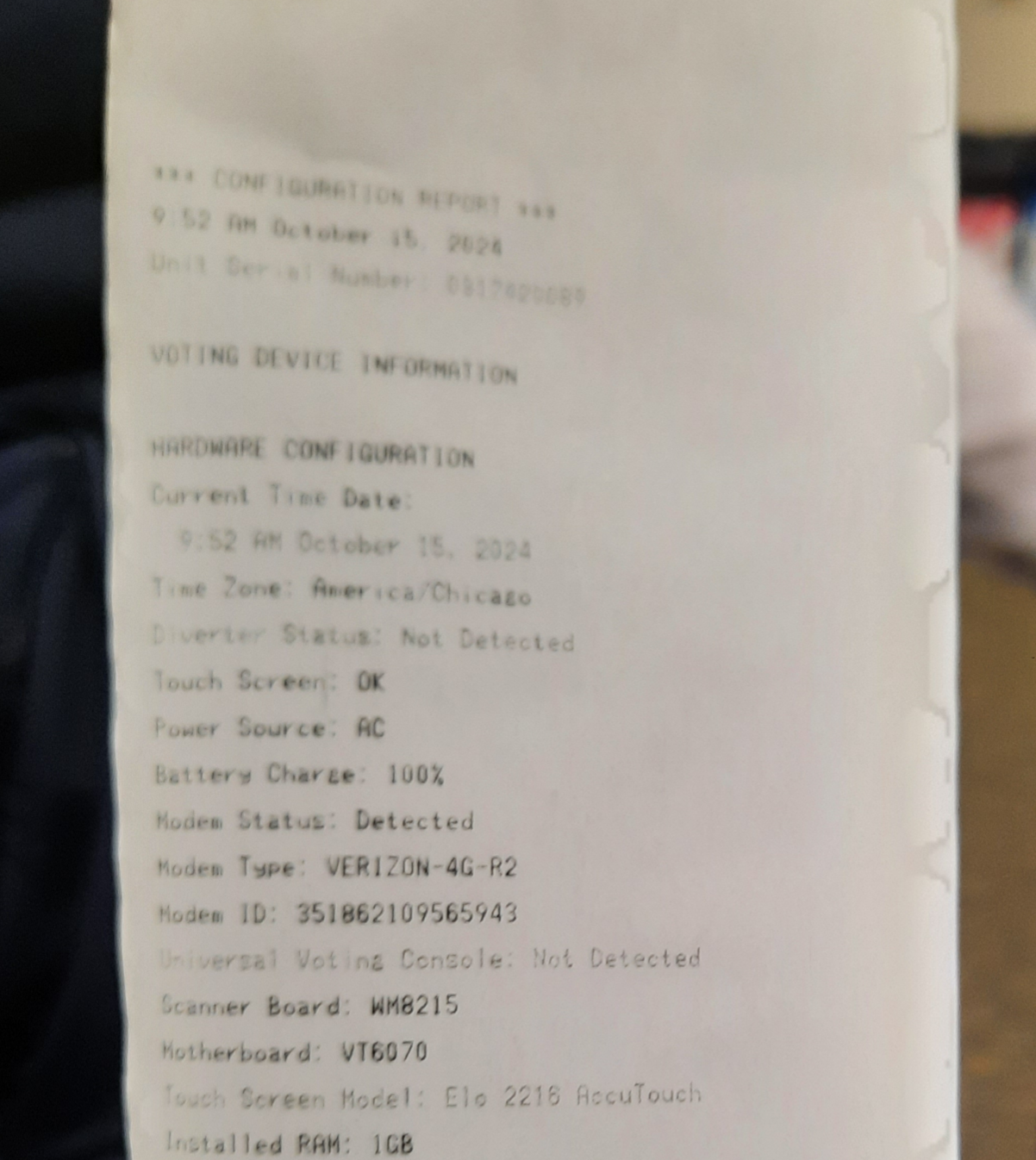
Electronic voting equipment and election management software from Dominion and Hart also had known vulnerabilities as shown at conventions like DEFCON 27 in 2019. Minnesota participates in the Electronic Registration Information Center(ERIC), having joined in 2014, which shares voter registration and other data between states, ostensibly to maintain clean voter rolls but a service which could be used to artificially inflate them. Were there any anamolies in the statewide voter registration system (SVRS) prior to or after the 2020 election in Minnesota?
It should be noted that there are currently groups working hard to develop software to ‘replace’ ERIC, and it’s my opinion that this is a waste of time because what is to stop the misuse of the next system? Meanwhile, there is a case to be made that voter registration is redundant, at least at the state level. Why can’t simple voter lists be kept at the county level and paper pollbooks be used to check in eligible voters with proper ID at each voting precinct on election day?
In the psychological realm, in mid-2020 George Floyd dominated news cycles. Covid-19 was also a daily discussion topic on and offline. This provided distraction, air cover, and justification for procedural changes which flew in the face of existing Minnesota law. Since, unusually high turnout in the absentee/mail-in category is anchored against the astronomical 60%, or 1.9 million (1,900,000) reported ballots in 2020, 700,000 of which were still not connected to a voter—700,000 MORE votes than voters—in the official system, the Statewide Voter Registration System (SVRS) even on November 29, 2020, 25 days after the election and 5 days after Secretary Simon and four others on the MN State Canvassing Board certified the election despite a petition to the MN Supreme Court asking for a pause until errors and omissions could be addressed.
To be covered in a separate book, in the runup to 2022 elections, there have also been reports of deliberate manipulations of delegate lists in addition to possible influence operations to position establishment candidates for the MNGOP endorsement and attempt to seed doubt beneath strong grassroots candidates who want to serve the interests of the people, not clandestine masters. The delegate disenfranchisement issue in Otter Tail County continued in 2024 and even into 2025 with new leadership continuing to fail to bring rogue elements into alignment with state election law and the MNGOP constitution. A no-endorsement occurred in the Boyd-Fischbach matchup when even with shockingly high spending and an ‘endorsement’ from Trump in addition to leaving out a large group of duly elected delegates, almost all of whom if not all were pro Boyd… that particular race went to a primary in August 2024, where Fischbach prevailed. Meanwhile, over a million dollars flowed in from about 50 congresspeople, friends of Tom Emmer, to Joe Teirab’s CD2 campaign where Taylor Rahm, who had already won the endorsement 75%/25%, was persuaded to step aside from his campaign.
Minnesota Statutes and Election Law
Let’s start with just a sample of Minnesota election laws and orders which affected the rules and procedures in the November 2020 general election:
- Election day registration allowed by Minnesota Statute 201.061 Subd.3 (legal since 1974, when Minnesota became the second state to allow it)
- Voter ID not required by law
- Dropboxes for absentee and mail-in ballots allowed by Minnesota Statute 203B.082 (58% of 2020 votes were reportedly absentee/mail-in ballots in Minnesota, over 1.9 million votes and more than 1.2 million more than the prior election)
- LaRose v. Simon - 1) Removed witness requirements for mail voters in Primary - 2) Extended the deadline to accept mail ballots (2 days) - STIPULATION AND PARTIAL CONSENT DECREE - Read LaRose Order 62 CV 20 3149 Order on July 31 Motions
- NAACP v. Simon - 1) Removed Witness Requirements for mail voters in General, 2) Extended the deadline to accept mail ballots (7 days), 3) MN Supreme Court Scheduled for September 3, 2020 - STIPULATION AND PARTIAL CONSENT DECREE - Read NAACP Order 62 CV 20 3625 Order on July 31 Motions
- This judicial complaint argues Judge Sarah Grewing’s decision not to recuse herself from above cases
- Minnesota Statute 206.57 Subd.6 Required Certification reads in part: “…a voting system must be certified…in conformity with voluntary voting system guidelines issued by the Election Assistance Commission…” Is it true that if not in compliance with VVSG 2.0, voting systems are therefore not in keeping with 206.57 Subd.6 Required Certification? The EAC has not certified any independent testing laboratories to perform the “VVSG 2.0” certification. (See also the EAC’s Voting System Testing and Certification Program Manual Version 3.0).

Discussion
No. 3 and No. 4 were put into motion after the MN Legislature, in April 2020, rejected Secretary of State Steve Simon’s request for irrevocable power to alter election law during a pandemic. Note that while Simon was the ‘target’ of NAACP v Simon and LaRose v Simon, he was actually participating in a play to circumvent the Legislature, which was ordered by biased Judge Sarah Grewing, a former staffer of Senator Amy Klobuchar, clearly a conflict of interest that 170 complaints argued should have led to her recusal.
No. 7 is included because this provides just one legal basis upon which to stand for county commissioners who choose to refuse to certify local elections in the primaries or midterm elections. It is one thing for the secretary of state to foist electronic voting equipment upon the counties. It is another thing for the county commissioners to certify an election just run on equipment that may violate election statutes like Minnesota Statute 206.57 Subd.6 Required Certification. If county commissioners are taken to court for withholding their certification, they may ask for the machines to be opened or to examine the source code. In that event, it will be interesting to see if either request is granted.
Modern Electronic Election Systems
On January 6, 2017 the Department of Homeland Security designated elections as critical infrastructure, alongside food, water, and electricity.
About three months before the election, on July 28, 2020, the Cybersecurity and Infrastructure Security Agency (CISA) identified the following components as lacking security in its Critical Infrastructure Security Resilience Note:
- voter registration systems
- epollbooks
- ballot preparation
- voting machines
- tabulation systems
- official websites
- storage facilities
Besides storage facilities, each of these components has undergone digitization in recent years.
Not long after the election, on November 12, 2020, CISA Assistant Director Bob Kolaksy, along with other members of the Election Infrastructure Government Coordinating Council (GCC) Executive Committee, made a joint statement declaring that “The November 3rd election was the most secure in American history… There is no evidence that any voting system deleted or lost votes, changed votes, or was in any way compromised.”

Rick Weible, in a workshop at the Big Lake City Hall on Wednesday May 25, 2022, pointed out that this statement could not have included a review of Minnesota, since Minnesota’s Canvassing Board would not certify the election until November 24, 2020.
Further, would it be unreasonable to ask Bob Kolasky how CISA’s analysis which produced the Critical Infrastructure Security and Resilience Note had changed between late July and mid November?
About a year and a half later, on June 3, 2022, CISA issued an advisory, “Vulnerabilities Affecting Dominion Voting Systems ImageCast X”, which focuses on Dominion (but ES&S and Hart also have glaring vulnerabilities) and may have been released to get ahead of a potential leaking of the Halderman report. The advisory detailed weaknesses including hidden functionality and improper protection of alternate path. Now, the Halderman report focuses on the internet connectivity of election equipment. But, I tend to agree with Draza Smith that we shouldn’t over-focus on that given what she wrote on Telegram in March, 2022: “The thing we need to get everyone to understand is that it is the software the vendors have baked into the machines that is cheating the American people.”
It’s not that internet connectivity isn’t a problem—it’s a big problem because for one thing, it allows centralized real-time communication between devices. But internet-connected, networked, or remote-accessable devices aren’t the only vulnerability. Even a machine without internet connectivity can be a huge problem for fairness and transparency based on its programming or chosen configurations.
Now, let’s take the CISA-identified components one at a time.
The Statewide Voter Registration System (SVRS)
The registration files known as voter rolls or rosters are critical because they store the data which helps determine who in the state is eligible to vote. An extract of these files is pulled into the epollbooks to allow a voter to receive a ballot if voting in person on election day.
Inflated rolls facilitate mail-in ballot schemes and support machine manipulation. It seems plausible that non-profits like the Electronic Registration Information Center (ERIC) could provide support to states using inflated rolls through “reports that show voters who have moved within their state, voters who have moved out of state, voters who have died, duplicate registrations in the same state, and individuals who are potentially eligible to vote but are not yet registered.”
For instance, if member states like Minnesota do not remove voters who have moved out of state or have died, then the result is an inflated voter roll. Even if the dead or out of state voter votes, that vote technically counts since that individual will be on the statewide voter registration system with a voter ID in the system. On the second night of the Cyber Symposium, I met someone named Russ working on several problems including the problem of voters on voter rolls in multiple states.
But how would you verify for yourself that voter rolls are inflated, providing an ample supply of ready-to-launch voters, a credit or slush fund to be used during the attack phase?
Voter rolls and histories are public information that you can request from the Minnesota Secretary of State’s website for $46. Note that your request is made at a particular moment in time. However, if you request a list before and after an election, as people like Rick Weible did for the November 3rd, 2020 General Election, and you are handy with database management (these are big files) then you can see how the lists changed. If you were to continue to request lists every few weeks, then you could see how the lists change over time, sometimes dramatically. Even still, it is unclear what version of the data is being handed over by the state. (Going forward, it should not require experts in database management to hold our government accountable.)
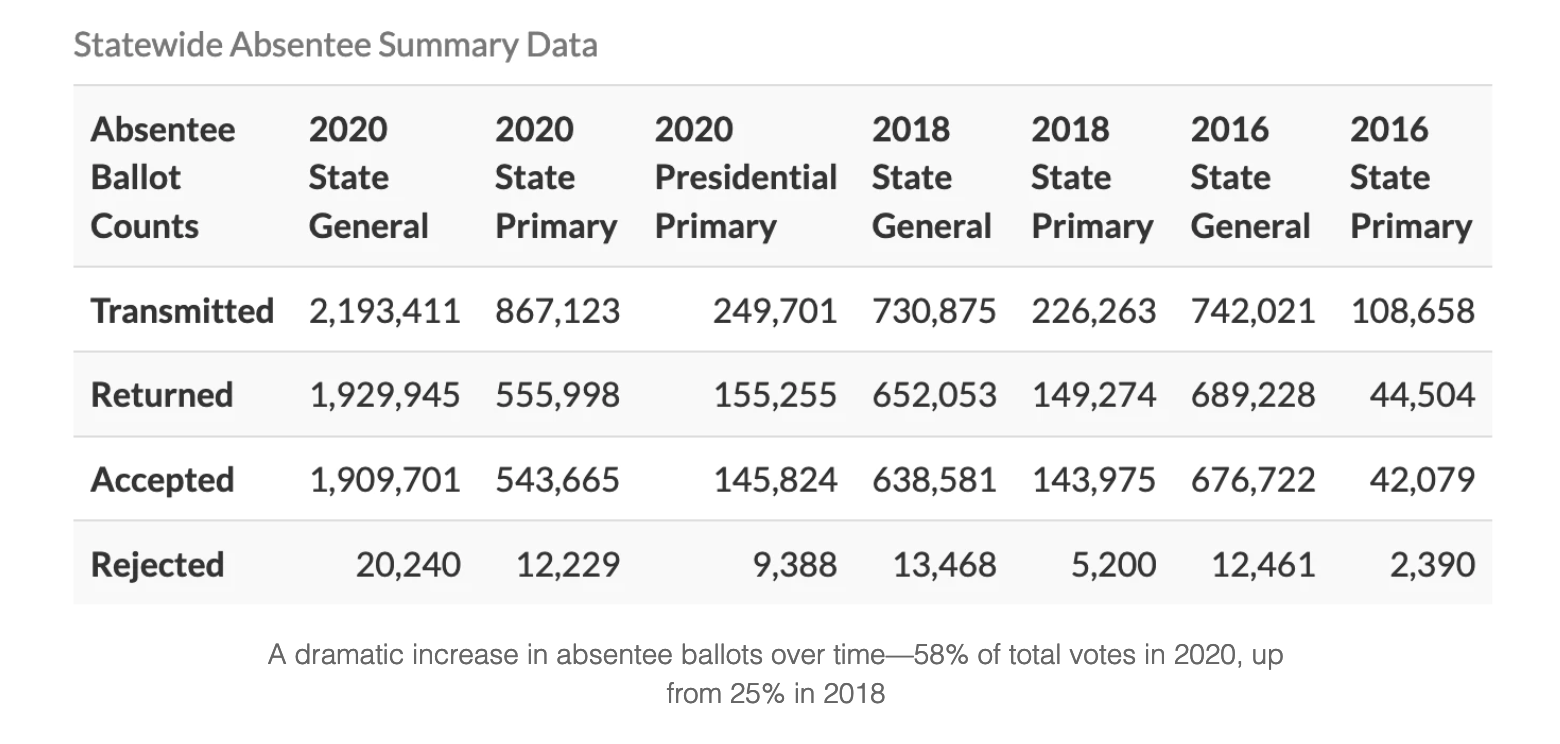
It was these voter rolls and histories that allowed Rick Weible to discover that more than 700,000 reported absentee votes reported by the secretary of state’s website were not yet connected to a voter in the SVRS on November 29, 2020, only 25 days after the election and a mere 5 days after the Minnesota State Canvassing Board certified the results of the 2020 General Election. This fact alone is major cause for concern because it means that the Office of the Secretary of State during that period would not have been able to prove the election was above board as apparently the work had not been completed yet. (Even a fully paper based system would not require that much time.) Note: These kinds of delays were repeated in 2022.
When comparing voter rolls with census population data, having been shown to be elevated in many ‘blue’ states through analysis of Seth Keshel and others, one can chart turnout of the voting age population. In the following chart, we see that Minnesota ranks 1st in voting age population turnout, an indicator of fraud. When the Minnesota Secretary of State boasts of high voter turnouts, is he actually deceptively bragging about how much fraud has occurred? (It should also be noted that the Office of the Secretary of State often defines voter turnout as number of eligible voters who voted, expressed as a percentage, instead of the standard definition which is the number of registered voters who voted expressed as a percentage. Voter turnout numbers with the latter standard definition put many Minnesota counties into the 90% and higher range in 2020, an absurd rate—if voters were really so eager to vote, why aren’t city level elections, primary elections, and even midterm elections challenging that 2020 rate?)
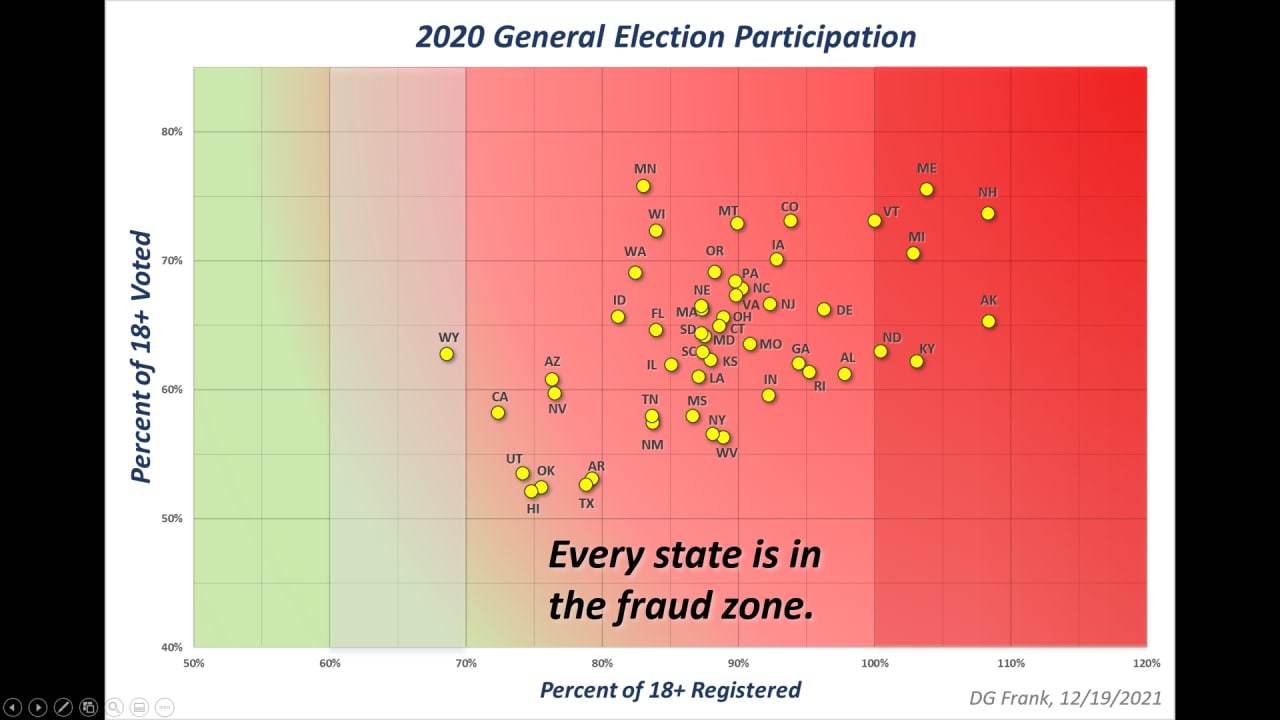
The USEIP Canvassing Report from March 11, 2022 visited 4,601 of 9,472 residences in Douglas, El Paso, Pueblo, and Weld Counties, Colorado. They found that about 8% of voters (123,852 of 1.1M) were affected by unexplained irregularities in Colorado’s voter rolls and voting records.
This rate of irregularities was similar to a 30-county canvassing effort led by Robin Sylvester in Minnesota, which as of early 2022 had canvassed about 2,000 homes and found just under 300 suspicious records.
In neighboring Wisconsin, Jeffrey O’Donnell’s analysis of data from August 2021 voter rolls showed over 7 million separate voter records in a state with less than 6 million people.
Rick Weible has acquired voter rolls and histories from multiple states. When examined collectively, the inflation either inspired by or influenced directly by organizations like the Electronic Registration Information Center (ERIC) is plain to see. We have since learned that there is a connection between Soros-funded Catalist and ERIC which helps to decrease the number of people on ERIC’s ‘Eligible but Unregistered’ EBU list. According to the EAVS report compiled by the EAC, there were 103,701,513 registration applications between the close of registration in 2018 and the close of registration in 2020, a 4x increase for the equivalent timeframe for the 2016 general election. The result of helping people become registered leads to head-scratching outcomes like this in California.
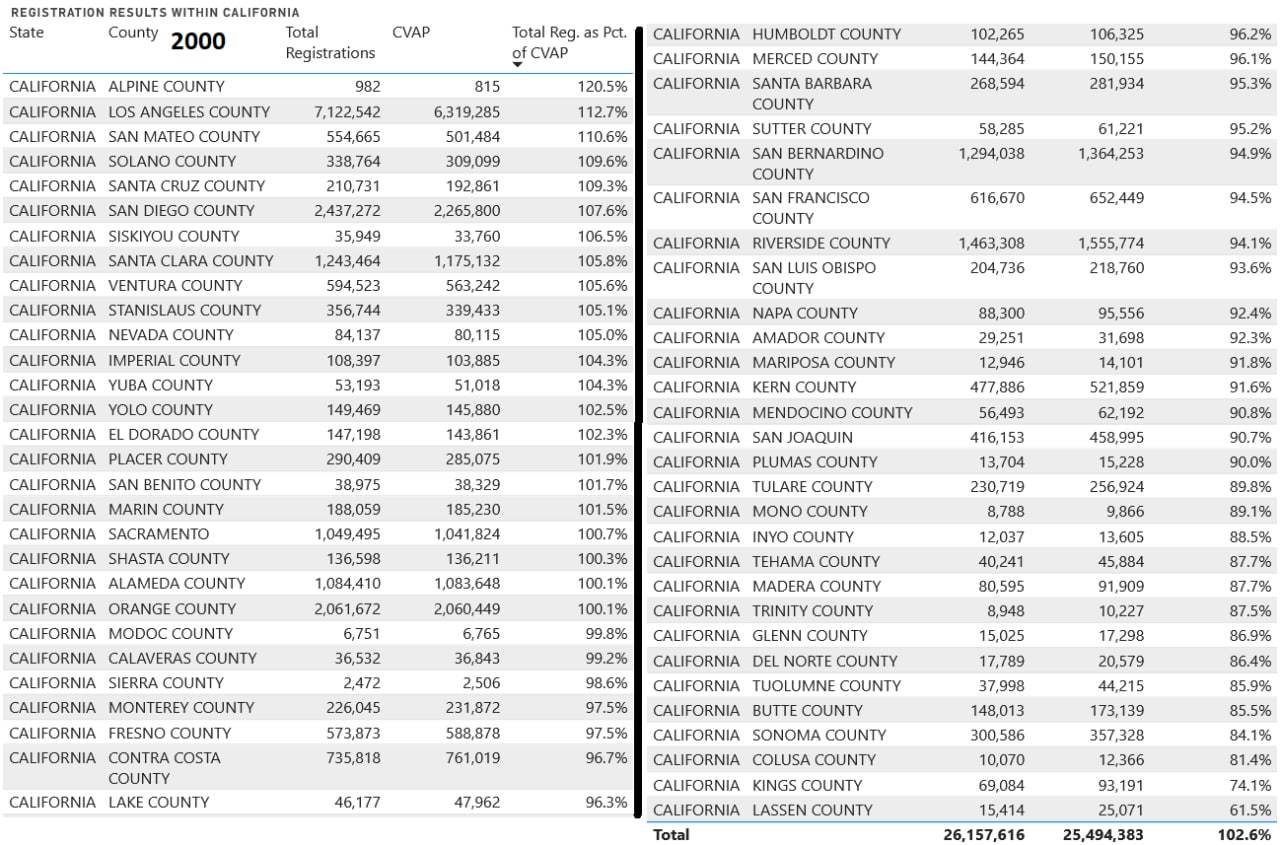
Minnesota is not much better, with for instance Carver County having more registered voters than citizens of voting age population.
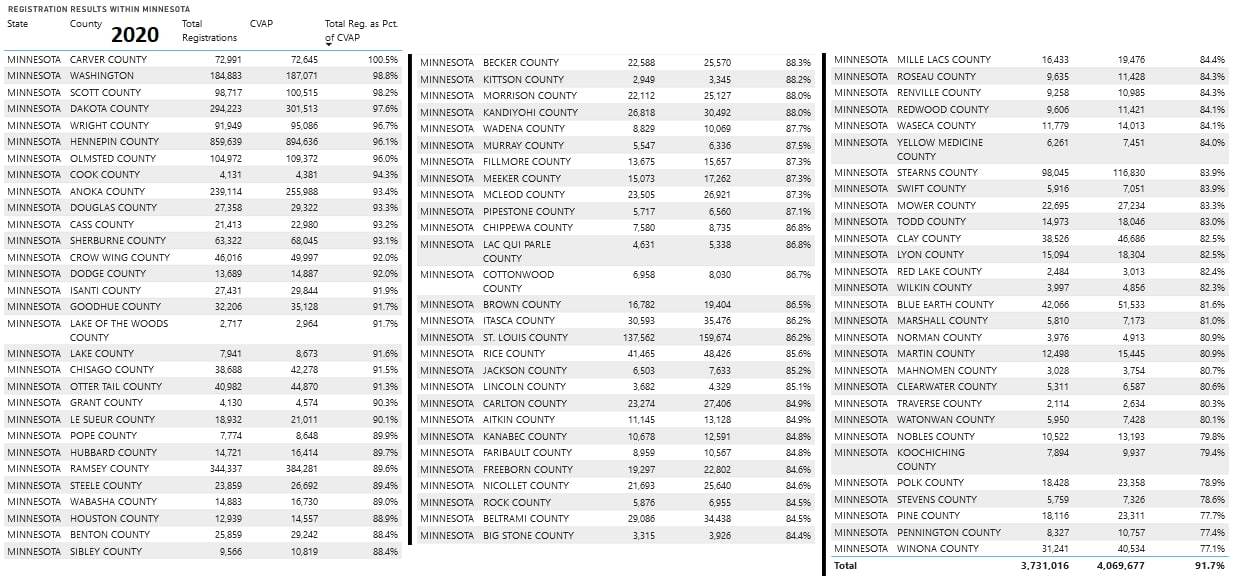
E poll pads (electronic poll books)
Electronic poll pads are generally connected to the internet via wifi or cellular so that they can both receive a precinct-level extract of the statewide voter registration system or are at minimum a digital file if not connected or networked.
The internet connection also provides for real-time updating which conceivably would have allowed the Minnesota Attorney General to make a certain tweet at 3:57pm on election day, which may have been a signal to the ballot mules, or simply panic.
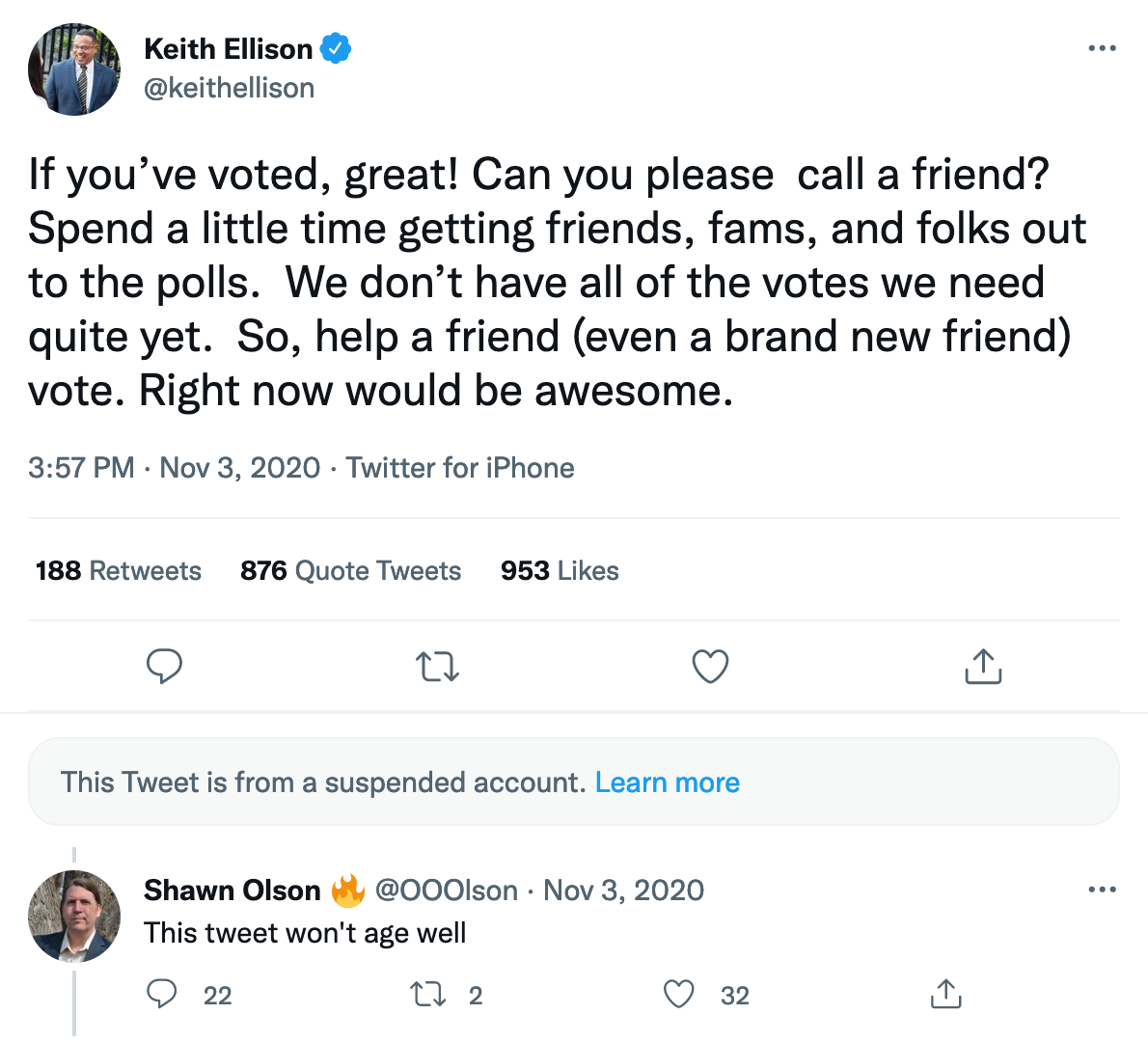
In January 2025, the Anoka County Elections Manager confirmed that precinct-level access to the number of remaining ballots is viewable by a centralized system available to him and others.
As an example of the importance of such a connection, in the New Jersey primaries in early June 2022, evidence of the Nighthawk providing internet connectivity to 8 Tenex epollbooks was documented at one polling place. For the first three hours, no one noticed. Then, the county board of elections office called one of the senior poll workers on her cell phone to remind her to set up the Nighthawk because prior to that the board officials were unable to monitor the processing of voters.
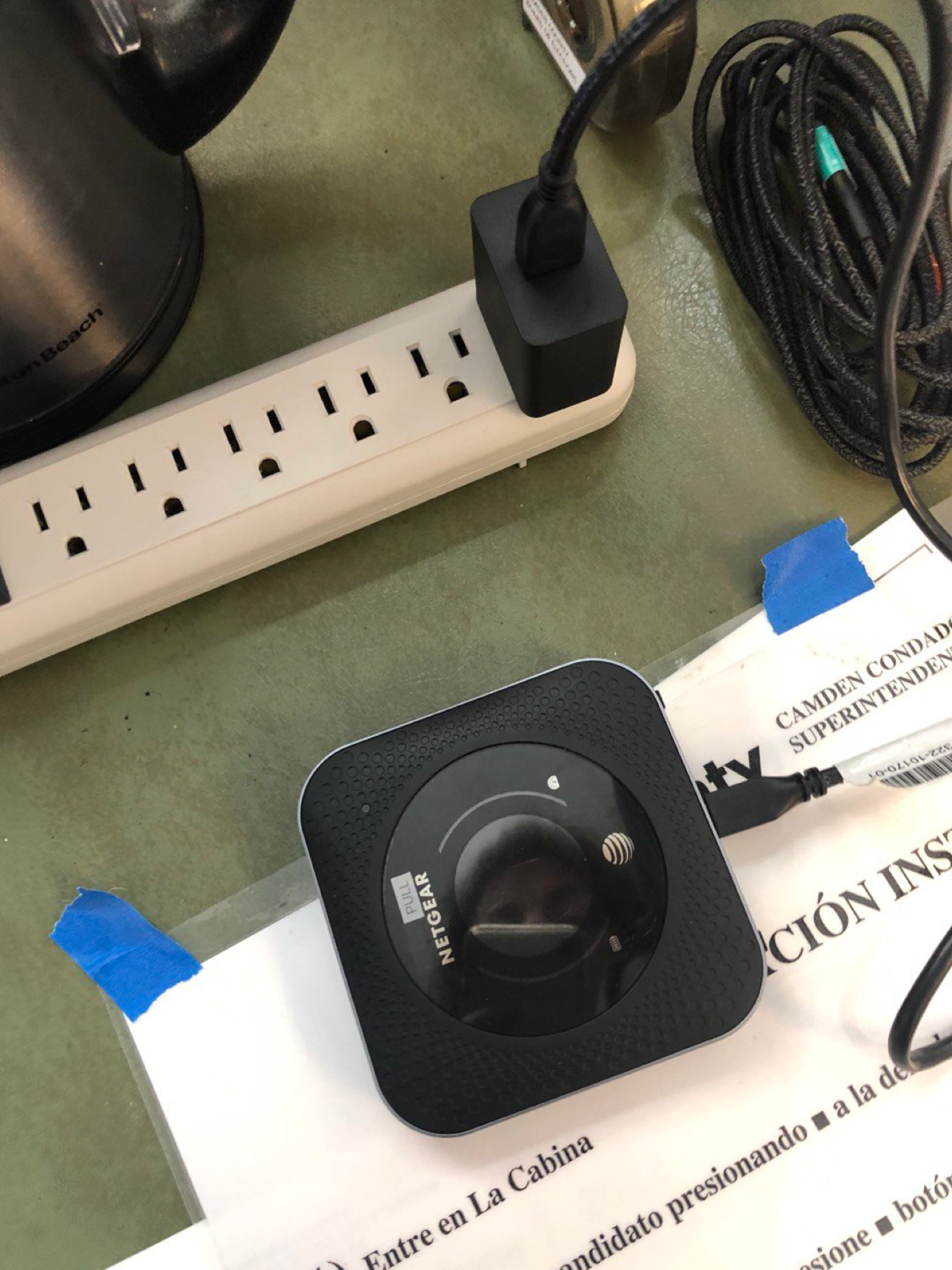
In 2016, when Rick Weible was the mayor of St. Bonifacius, he hacked into the proposed iPads from KNOWiNK within minutes. Then he declined to sign a contract to use them in St. Bonifacius (his council voted No), even while receiving the threat of a lawsuit. His was the only city in Hennepin County not to use epollbooks (they used paper pollbooks) in the following election, but this did not stem the major rollout to counties like Anoka in 2018, which coincided with a major shift in especially Democrat voter turnout, both in a 2014/2018 (midterm comp) or from 2016/2018 (presidential to midterm comp).
As shown on the Verified Voting website, a majority of counties in Minnesota use the KNOWiNK Poll Pads, which are essentially converted iPads for epollbook use. However, about 20 are still not using these electronic poll pads, which are not certified by the Election Assistance Commission (EAC). Rick Weible has spoken about cloud issues that were documented in Sherburne County on election day, 2020, and in 2024 discrepancies were found between the Secretary of State’s website and precincts like Clear Lake in Sherburne County, documented by researchers.
Ballot Preparation
Ballot preparation is a complicated process. But Patrick Colbeck does us a favor of simplifying the complex in his book, The 2020 Coup:
“Ballots are another key election infrastructure component with security vulnerabilities. Modern ballots are much more sophisticated than a piece of paper with checkboxes next to names. Today’s ballots are sophisticated paper and/or digital documents. In fact, in some cases, ballots are replaced by Direct-Recording Electronic (DRE) voting machines.
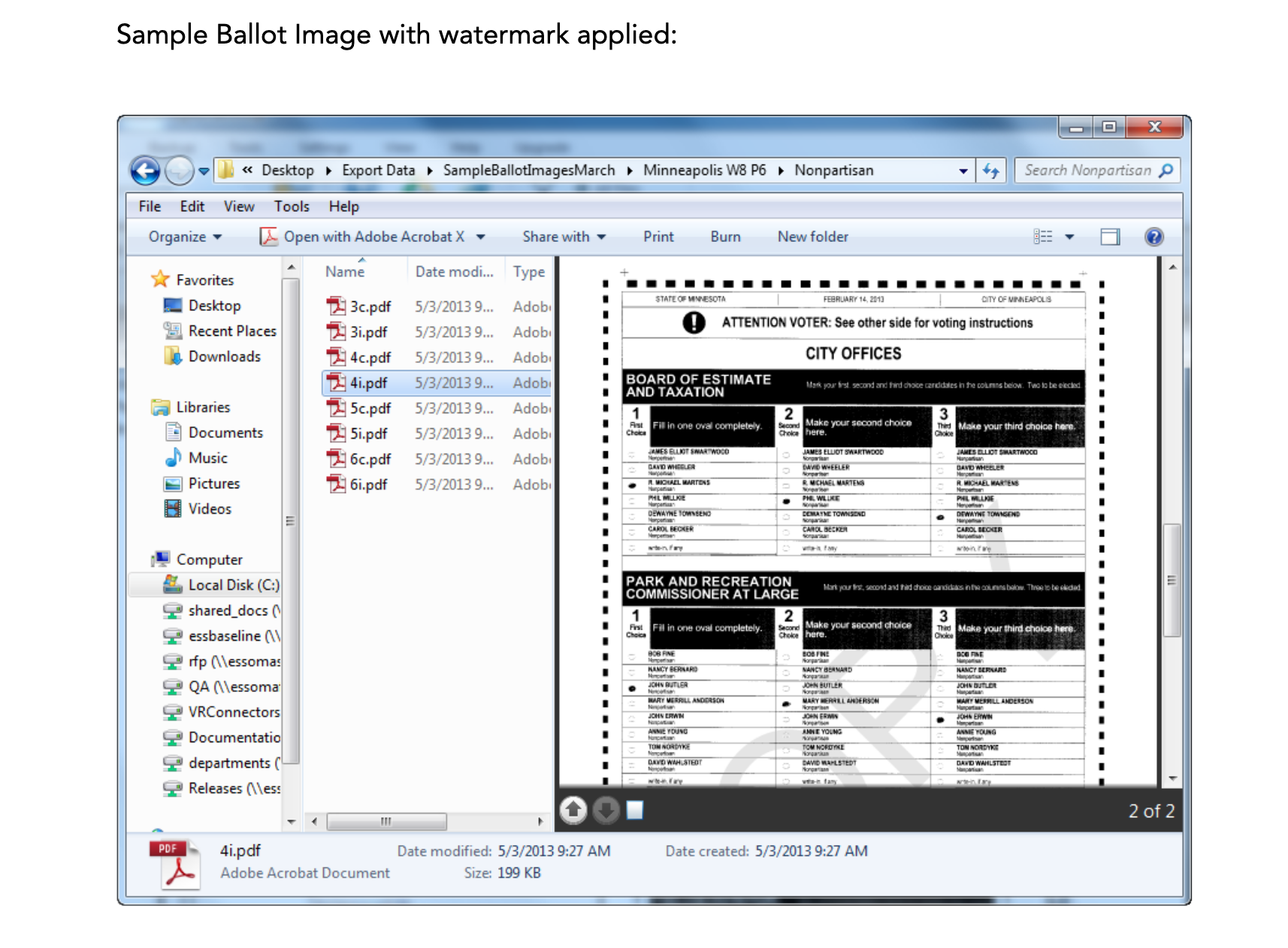
“Ballot preparation is a complicated process of overlaying political geographies with the contests and candidates specific to each district and then translating those layouts into unique combinations of ballot data. Ballot preparation data takes multiple forms such as ballot images (both paper and electronic), the data files necessary to build ballot images, audio files for special use ballots, and specific files for export to external systems such as websites for Uniformed and Overseas Citizens Absentee Voting Act (UOCAVA)-focused digital systems. Ballot preparation also generates the data necessary for tabulating votes within a voting machine and aggregating tabulated votes within a jurisdiction or state. This process is usually completed in an election documents and records management system (EDRMS), which is special software designed to manage documents and records throughout the document lifecycle, from creation to destruction. Access to the information in such systems would enable anyone attempting to subert the integrity of an election with the information necessary to create ballots independently of election officials. Of course, ballots are also where voters record their votes. Vote tallies are generated from the information on ballots therefore their integrity is very important to protect.”
After watching 2000 Mules Erin Clements asked where the NGOs that printed the ballots for the mules may have gotten the ballot formatting and ballot styles to correctly print ballots. I imagine True the Vote’s Catherine Engelbrecht and Gregg Phillips’ team were asking the same questions, leading to their follow-on work from the Wisconsin hearing in March 2022 to the Maricopa County senate hearing in early June to the work on the ground in Yuma County.
While Minnesota uses paper ballots in all 87 counties, we are not hand-counting them, but instead relying on computers to first scan and then read the ballot image created.
Because there is no hand tally, we are putting our trust completely in the voting machines and tabulation systems to properly scan, tally, and record the votes on each paper ballot and the aggregation of those totals. There is no way for the public to verify the accuracy unless a manual human hand count and hand tally is done on the spot. Numerous demonstrations by the likes of Rick Weible or Mark Cook in Searcy County, Alabama, have shown this to be effective. See uscase.org or openelectionrecords.org for more and to setup your own trainings.
The voting machines, also called tabulators, scan and tally the votes. Simply put—but the process is anything but simple—the tallies from the tabulators are then aggregated in tabulation software known as an election management system. Results from this election management system are then supposed to be passed through reporting providers like Edison Research and eventually through the media to your living room. However, Jeffrey O’Donnell and Draza Smith have speculated that this election night reporting could well be theater and not directly connected to actual results recorded in tabulators.
Voting Machines
The most common voting machines is otherwise known as a tabulator. These optical scanners take in paper ballots and then are essentially interpreting pixels on a bitmap and translating that into vote tallies.
Vendors largely keep to themselves their standards for interpreting ovals. In certain situations, the tabulators are programmed to send ballots to adjudication, where election judges are responsible (not the voter) for deciding the intent of the voter. This includes situations like blank ballots, overvotes, ambiguous marks, and ballot misreads.
It’s conceivable that these tabulators make mistakes that humans would not make. Erin Clements demonstrated evidence of this from the Otero County audit in the Otero County Special Meeting on June 9, 2022. She concluded, “The tabulators are not smarter than people.”
In that same audit, there was a software mismatch between the tabulators and the election management system (a violation of the election code in New Mexico law), and yet the mismatch did not prevent the tabulation systems from processing vote tallies.
Here is a table of electronic voting equipment used in Minnesota’s 2020 general election, provided by Dan Sundin, part of the decentralized Telegram group mentioned in the introduction, who despite not living in Minnesota did me a favor and pulled this information from each of the county websites (in addition to precinct-level results for all counties).
| County Name | Absentee and Mail Ballot Tabulation Equipment | Assistive Voting Equipment |
|---|---|---|
| Aitkin | ImageCast Central | ImageCast Evolution |
| Anoka | Digital Scan 200, Digital Scan 450, Digital Scan 850 | AutoMARK |
| Becker | Model 100 | AutoMARK |
| Beltrami | Digital Scan 200, Digital Scan 450 | AutoMARK |
| Benton | Digital Scan 450 | AutoMARK |
| Big Stone | Verity Scan | Verity Touch Writer |
| Blue Earth | Digital Scan 200, Digital Scan 450 | OmniBallot |
| Brown | Digital Scan 450 | AutoMARK |
| Carlton | Digital Scan 200 | AutoMARK |
| Carver | Digital Scan 200, Digital Scan 450 | AutoMARK |
| Cass | Digital Scan 200, Digital Scan 450 | OmniBallot |
| Chippewa | Digital Scan 200 | AutoMARK |
| Chisago | Verity Central, Verity Scan | Verity Touch Writer |
| Clay | Digital Scan 200, Digital Scan 450 | AutoMARK |
| Clearwater | Digital Scan 200 | AutoMARK |
| Cook | Digital Scan 200 | AutoMARK |
| Cottonwood | Digital Scan 200 | AutoMARK |
| Crow Wing | ImageCast Central | ImageCast Evolution |
| Dakota | ImageCast Central | ImageCast Evolution |
| Dodge | Digital Scan 200 | AutoMARK |
| Douglas | Digital Scan 200, Digital Scan 450 | OmniBallot |
| Faribault | Digital Scan 200 | AutoMARK |
| Fillmore | Digital Scan 200 | AutoMARK |
| Freeborn | Digital Scan 200, Digital Scan 450 | AutoMARK |
| Goodhue | Digital Scan 450 | AutoMARK |
| Grant | Digital Scan 200 | AutoMARK |
| Hennepin | Digital Scan 200, Digital Scan 850 | AutoMARK |
| Houston | Digital Scan 200 | AutoMARK |
| Hubbard | Digital Scan 450 | OmniBallot |
| Isanti | Digital Scan 200 | OmniBallot |
| Itasca | Digital Scan 200 | OmniBallot |
| Jackson | Digital Scan 200 | OmniBallot |
| Kanabec | Digital Scan 200 | AutoMARK |
| Kandiyohi | Digital Scan 200 | AutoMARK |
| Kittson | Digital Scan 450 | AutoMARK |
| Koochiching | Digital Scan 200 | AutoMARK |
| Lac Qui Parle | Digital Scan 450 | OmniBallot |
| Lake | Digital Scan 200 | AutoMARK |
| Lake Of The Woods | Digital Scan 200 | OmniBallot |
| Le Sueur | Digital Scan 200 | AutoMARK |
| Lincoln | Digital Scan 200 | AutoMARK |
| Lyon | Digital Scan 200 | AutoMARK |
| Mcleod | Digital Scan 200, Digital Scan 450 | AutoMARK |
| Mahnomen | ImageCast Evolution | ImageCast Evolution |
| Marshall | Digital Scan 850 | AutoMARK |
| Martin | Digital Scan 200, Digital Scan 450 | AutoMARK |
| Meeker | Digital Scan 200 | OmniBallot |
| Mille Lacs | Digital Scan 200 | AutoMARK |
| Morrison | Digital Scan 200, Digital Scan 450 | AutoMARK |
| Mower | Digital Scan 200 | AutoMARK |
| Murray | Digital Scan 200 | AutoMARK |
| Nicollet | Digital Scan 200 | AutoMARK |
| Nobles | Digital Scan 200 | AutoMARK |
| Norman | Digital Scan 200 | AutoMARK |
| Olmsted | Digital Scan 850 | AutoMARK |
| Otter Tail | Digital Scan 200 | AutoMARK |
| Pennington | Digital Scan 200 | AutoMARK |
| Pine | Digital Scan 200, Model 100 | AutoMARK |
| Pipestone | Digital Scan 200 | OmniBallot |
| Polk | Digital Scan 450 | OmniBallot, AutoMARK |
| Pope | Digital Scan 200 | AutoMARK |
| Ramsey | Digital Scan 850, Verity Central, Verity Scan | Verity Touch Writer, AutoMARK |
| Red Lake | Digital Scan 200 | AutoMARK |
| Redwood | Digital Scan 200 | AutoMARK |
| Renville | Digital Scan 200 | AutoMARK |
| Rice | Digital Scan 200, Digital Scan 450 | AutoMARK |
| Rock | Digital Scan 200 | OmniBallot |
| Roseau | Digital Scan 200 | OmniBallot |
| St. Louis | Digital Scan 200, Digital Scan 850, Model 100 | AutoMARK |
| Scott | ImageCast Central, ImageCast Evolution | ImageCast Evolution |
| Sherburne | ImageCast Central | ImageCast Evolution |
| Sibley | Digital Scan 200 | AutoMARK |
| Stearns | Digital Scan 450, Digital Scan 850 | AutoMARK |
| Steele | Digital Scan 200 | AutoMARK |
| Stevens | Digital Scan 200 | AutoMARK |
| Swift | Digital Scan 200 | OmniBallot |
| Todd | Digital Scan 200 | OmniBallot |
| Traverse | Digital Scan 200 | AutoMARK |
| Wabasha | Digital Scan 200 | AutoMARK |
| Wadena | Digital Scan 200 | AutoMARK |
| Waseca | Digital Scan 200 | OmniBallot, AutoMARK |
| Washington | Digital Scan 850, Verity Central | Verity Touch Writer, AutoMARK |
| Watonwan | Digital Scan 200 | AutoMARK |
| Wilkin | Digital Scan 200 | OmniBallot |
| Winona | Digital Scan 200 | AutoMARK |
| Wright | Digital Scan 200, Digital Scan 450 | AutoMARK |
| Yellow Medicine | Digital Scan 200 | AutoMARK |
Another way to view which equipment was in use in 2020 or will be in use for 2022 is on the Verified Voting website.
Remember, there are known and potential vulnerabilities in all voting machines, but let’s zoom in for a moment on the most-used equipment in Minnesota.
ES&S DS200s were used in 65 of Minnesota’s 87 counties in 2020.
In April 2021, the DS200 used in Antrim, County Michigan was found to have a 4G wireless modem installed within the enclosure of the machine.
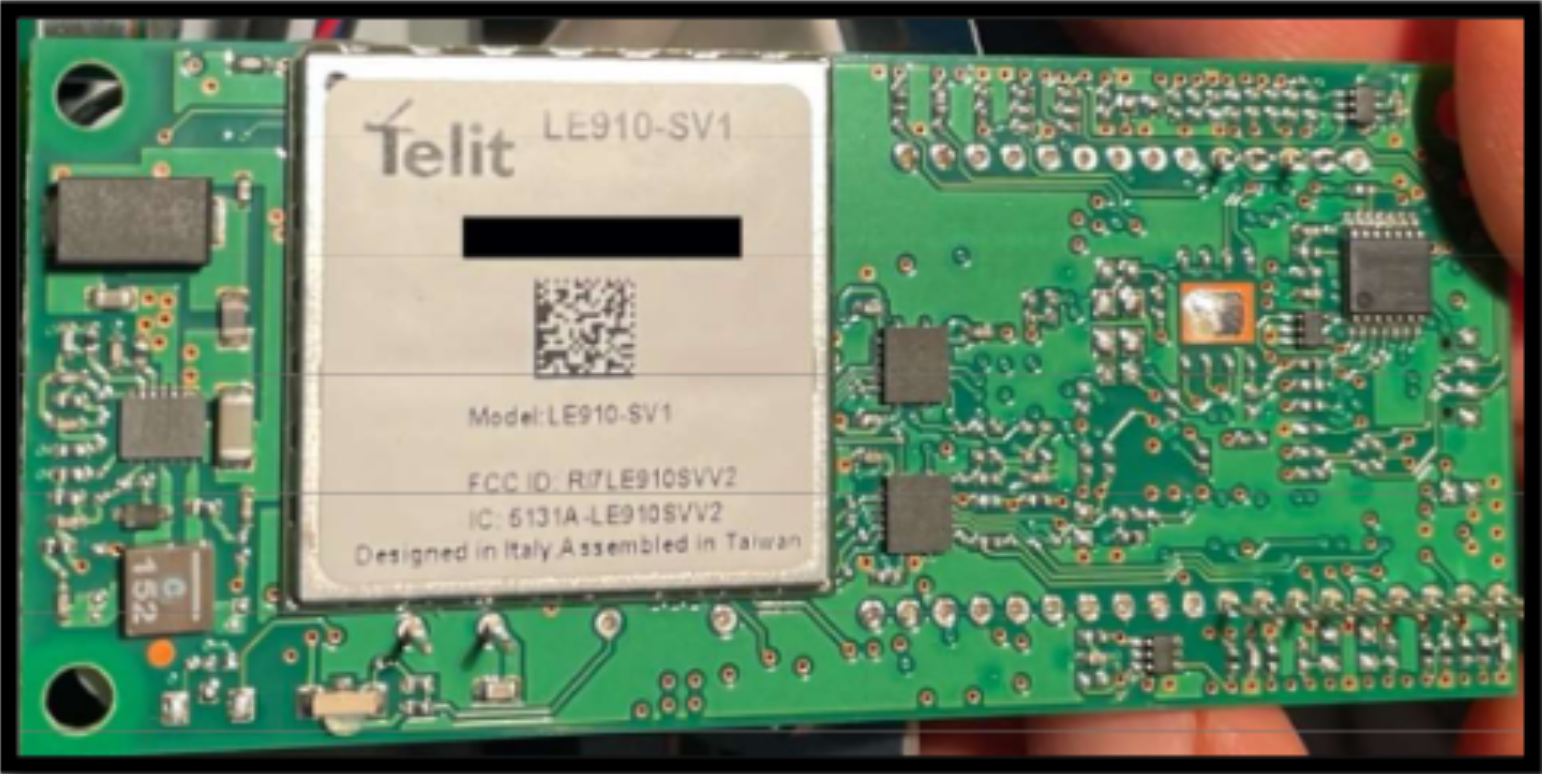
Furthermore, the exhibit describes how the card was “utilizing a commercial Verizon SIM card with an APN configuration specific to the ES&S DS200 provisioning. Testing revealed that the same SIM card could be utilized in a separate wireless hotspot device and the device could then join the same APN as the ES&S voting machines. An unauthorized user could gain access to this APN by an extra SIM card pre-provisioned for this APN, or by removing a SIM from an operational device and using it in another device.”
To repeat: This wireless modem was found on an enclosed part of the machine. Therefore if these same or similar wireless modems were also installed on the DS200s throughout Minnesota, it would be invisible to election judges, poll challengers, and even election officials regardless of whether the machines were certified. Under Minnesota law, it is not required that every machine be certified, only the model of machine. (From 206.57 Subd.1, “Examination is not required of every individual machine or counting device.”) Testing can be limited to certain requirements which evidently can miss the presence of a 4G wireles modem.
The presence of these would seem to also disqualify a voting system according to the VVSG 2.0 (relevant to county commissioners considering whether to certify their upcoming local elections):
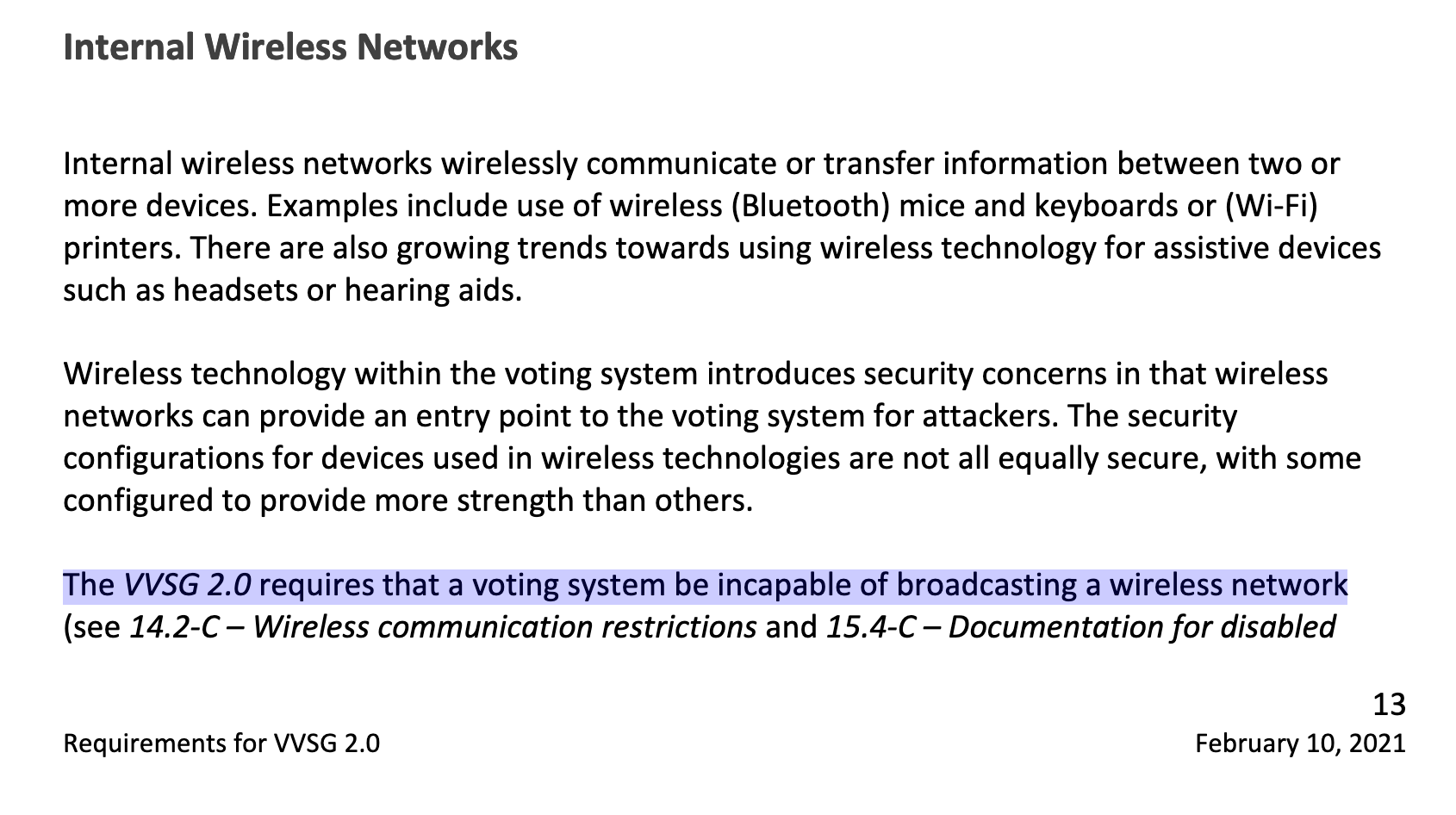
I also include this information in the preparation phase of our discussion because this 4G wireless modem implementation would likely need to be installed before or during the election in order to be used by bad actors.
Additionally, scientist Dr. Douglas Frank has called the ES&S DS200 “one of the most hackable ballot scanners in the country”. Because the code is not open source, it is difficult to know all the vulnerabilities that may exist. And since its “System and Method for Decoding Marks on a Paper Ballot” is proprietary, patent law means ES&S owns that intellectual property. That being said, former cyber analyst for the Air Force Jake Stauffer’s vulnerability report is revealing, demonstrating among other details that “file systems are not encrypted [which] allowed the team to recover system configuration information, password hashes, and ES&S specific binaries.”
To understand how the DS200 plays into the overall system, here’s a diagram ES&S sent to Travis County, Texas in a contract proposal.
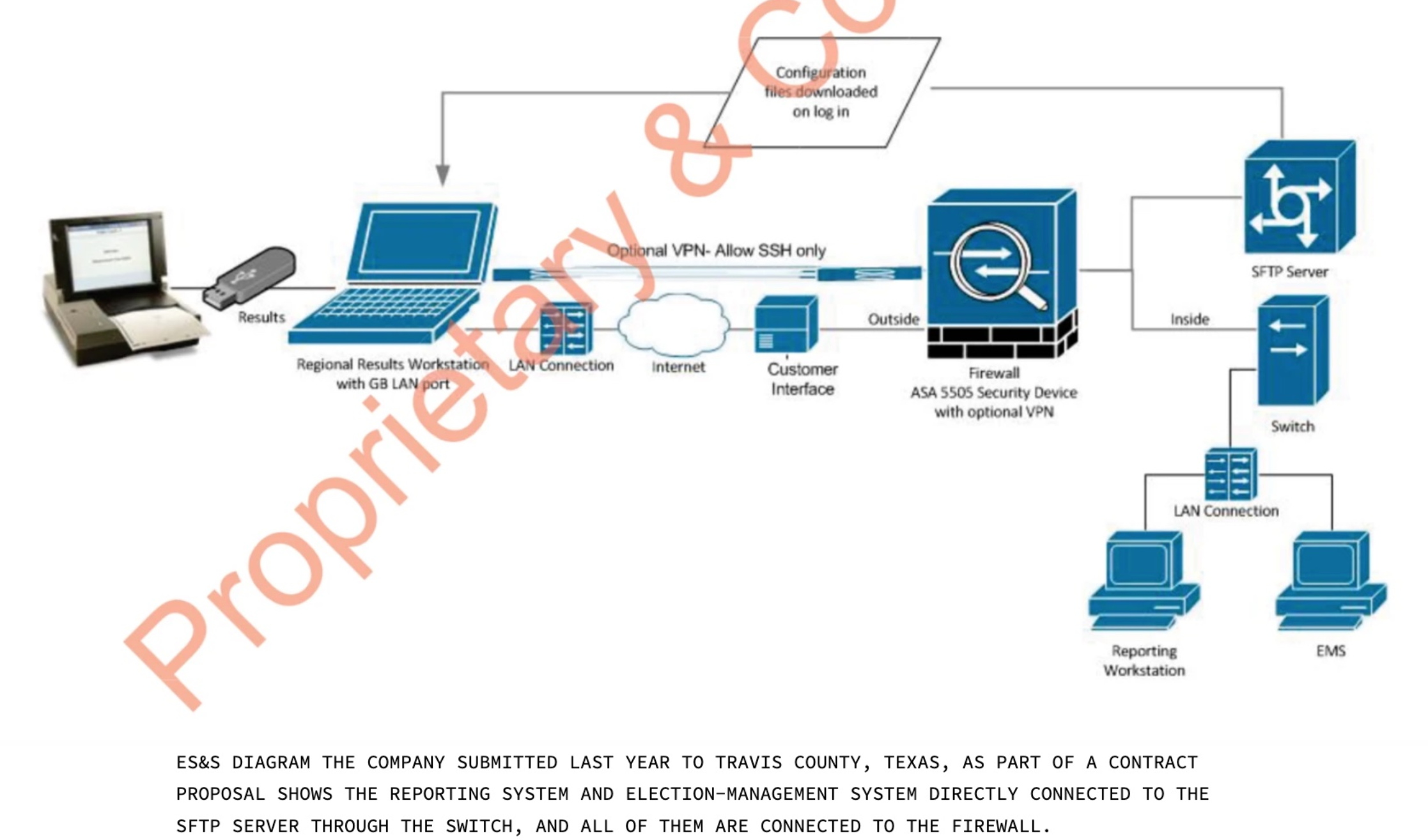
To make matters worse, however, there are apparently settings on the DS200 which allow the ballot images to not be saved (reducing the audit trail) and potentially configuration settings which turn off the Cast Vote Record (CVR) report functionality. EDIT: This last point was actually disinformation from secretary of state offices, meant perhaps to throw citizens off the scent of these vital election records which by federal law must be retained for a minimum of 22 months.
Turning off the functionality to generate the ballot image portion of the cast vote records is troublesome.
But the following letter and those like them from auditors, attorneys, and administrators at counties all over Minnesota demonstrate a basic lack of understanding of how our votes are being counted and tallied. If those administering the elections don’t even know how the computers work, that’s a big deal.
Here’s a letter I recieved from the Todd County Attorney after initially starting the conversation with the Todd County Auditor. Note: Went to Todd after a friend suggested starting there since, after all, Dr. Frank had said we should vote like the Amish.

*Please note that although we have focused on the ES&S DS200s, there are several Minnesota counties that use Dominion ImageCast machines and several that use Hart Verity Scan tabulators. Equipment from these vendors are also insecure from cyber threats. These vendors, in one case, have also deleted election records prior to the 22 month federal retention, constituting a federal crime, as admitted to by the Chisago County Auditor over the phone (recorded) when I was simply asking for the cast vote records. She said they weren’t available because the vendor had performed an update, which to me sounded similar to the Tina Peters situation in Mesa County, Colorado, except in that situation Peters retained a before and after computer image to allow comparison of the databases, revealing evidence of an election crime.
Along with obvious cyber vulnerabilities, vendors are not open with their source code (and by statute do not have to be) and therefore vote-manipulating software could be baked in. Furthermore, because of a supply chain that too often had its origin in CCP-controlled China, the components of these machines could represent the point of vulnerability.
This all said, any commissioners opting to withhold their certifications of local elections (shortly after election day) could for just one instance request a micro-audit, to be performed in under a day, of their voting machines to ensure that security and accuracy were maintained throughout the election. Better still, they could pass resolutions to perform extensive post-election audits of all the precincts and all the races in those precincts.*
Contracts
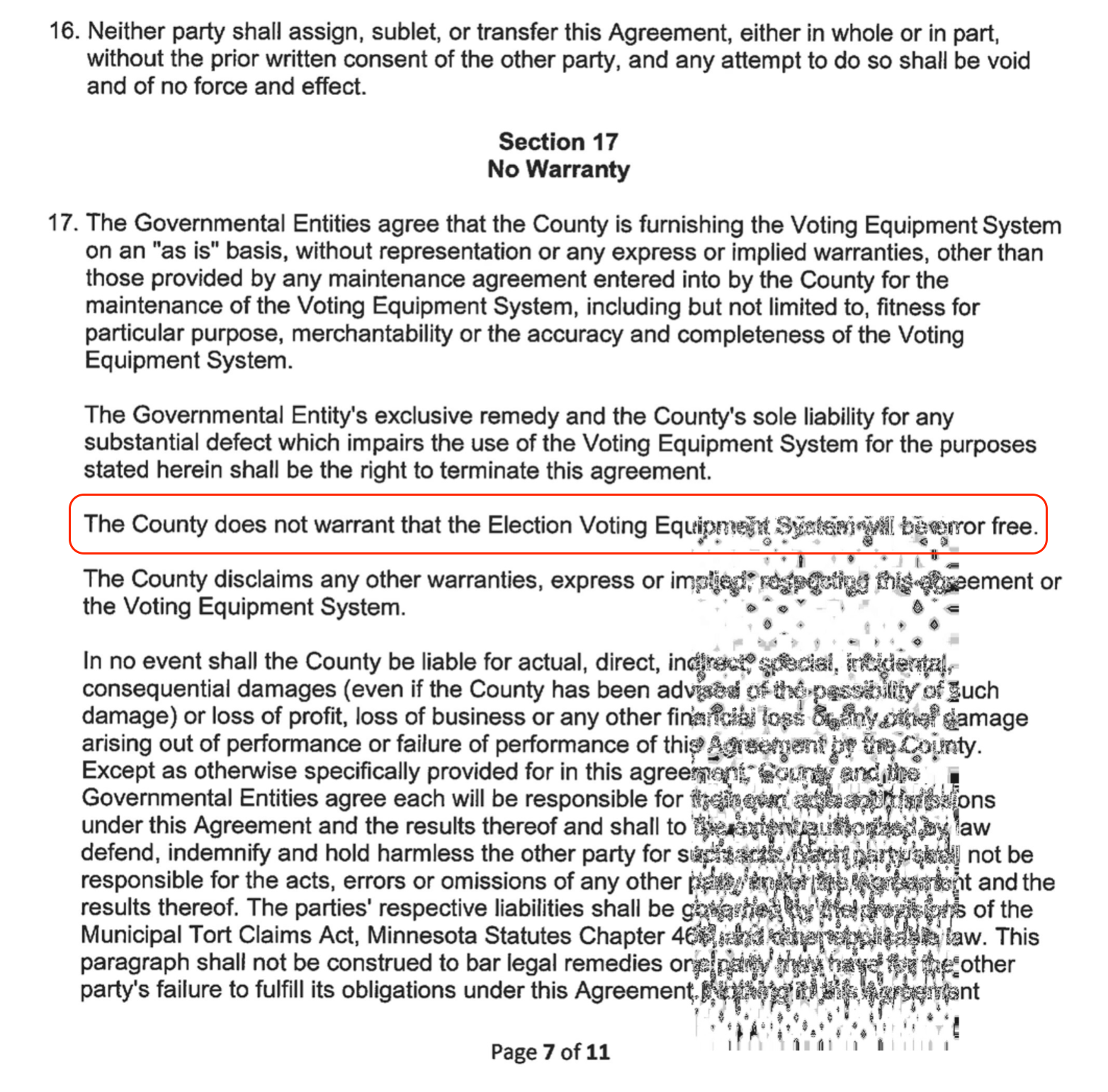
One of my friends has repeated, “It’s in the contract.”
Researchers across Minnesota and the country have read numerous manuals from the vendors, training materials, guides from the secretaries of state, and of course, the contracts themselves.
Tabulation Systems
Here again I lean on Patrick Colbeck’s description, this time from page 10 in The 2020 Coup:
“Tabulators are critical election infrastructure components with significant security vulnerabilities. At the precinct-level, tabulators are used to read a ballot, convert the ballot image to votes, and add the vote data on a given ballot to the running tally of votes stored in a digital table. Precint-level vote tallies are then aggregated by centralized vote tabulation systems at the municipal, county, and state levels. Collectively, these systems help determine and communicate the results of an election. If tabulators are compromised, they can shift votes from one candidate to another. These votes shifts can change the results of an election.”
Dan Sundin’s description of ES&S’s ElectionWare is helpful to understand how important the tabulation system is:
“ElectionWare runs in the Server computer (which may just be a workstation depending upon the customer deliverable). ElectionWare is key, as it does all the related work in generating the Election Project Files, the optioning of the races, districts, precincts and splits of those precincts. It downloads the related information in to all of the collection points, ExpressVote BMD, DS200 Scanners at the precincts, and sets up the Central Count Site Scanners, DS450, DS850 and now DS950. It also creates all the PDF Ballot files for professional printing and for creation via the Ballot-on-Demand print feature.”
The following diagram shows how five elements of the ES&S EVS tabulation system is put together, which include:
- Election Data Management
- Ballot Formatting and Printing
- Voting Equipment Configuration
- Voting and Tabulation
- Results Consolidation and Reporting

In the 3/15/2022 Nye County, Nevada County Commissioner’s meeting cyber security consultant Mark Cook described his experience with computers pre-internet in the CompuServe and Prodigy days, then as a consultant to protect companies from threats and seal off vulnerability, and finally with election systems.
Today, Dominion is a popular voting system which uses Microsoft SQL database, one which Mark was and is very familiar with as he used SQL databases from day 1. In the same meeting, he discussed how within the first minute of getting his hands on a Dominion system, he was able to access the backend and change votes…without leaving a trace.
In the Antrim County, Michigan investigation, where there were a confirmed 7,000 votes flipped (in the 2020 election), nation-state vulnerability expert Jeff Lenberg demonstrated vote swapping that allowed the election management system and tabulator printouts to match (for the canvass). The problem? The EMS and the tabulator tapes would not match the paper ballots initially scanned through the tabulator. (This is still one of my favorite videos and mirrors a mock election experience that Draza Smith, Col. Shawn Smith, and Mark Cook created alongside Patrick Colbeck at the Cyber Symposium. Once you see how easy it is to swap votes, it cannot be unseen, and this is only one of many exploitable vulnerabilities.)
In 2021, when Tina Peters learned that a Dominion vendor was planning to visit her office to make a software update, she took action in line with her statutory duties to preserve election data as the Mesa County Clerk. She worked with consultants to save a copy of the before and after image of her Dominion Voting Systems (DVS) Election Management System (EMS) servers, which data analysts then began investigating to detect what Dominion’s “Trusted Build” may have changed.
It turned out to be a lot.
The three Mesa County reports go into much detail on findings, some of which was alluded to in the Selection Code documentary.
These not so trust-worthy software updates were performed by Dominion employees across the country, possibly destroying evidence of election tampering and manipulation. It is possible that such an update may have occurred in the six Minnesota counties using the Domininon Voting System (DVS) Election Management System (EMS). So far, just the one before/after image of the servers exists. For her contributions, the Mesa County Clerk, Tina Peters, who first began telling her story in the August 2021 Cyber Symposium, has been politically imprisoned for a sentence of 9 years.
Influence Operations
I have chosen to borrow the term influence operations from Patrick Colbeck since it is less frequently used when compared to psychological operations or psyops. The screens which bring us our daily inspiration and fear, information from loved ones and our 2-minute’s hate (à la 1984), are seemingly a blessing and a curse.
A blessing because it is only with the internet that information can be shared quickly enough and widely enough to outflank centralized media platforms and censorship regimes.
But a curse because influence operations are deployed on those screens which provide an unobstructed path to our brain, unless one is armored up and discerning wisely.
For me, the most significant influence operations in the preparation phase in Minnesota were George Floyd, its extended aftermath, and of course, Covid-19.
At the time I lived not far from 38th and Chicago.
A few months later, I biked there once and another time went on foot. Roads were blocked making it difficult for locals to leave area in cars. Shops were closed replaced by vendors selling t-shirts and BLM masks. Flowers were laid before the provocative murals and around the monument at the intersection. Into the beginning of 2025, it is still unclear whether the area will be properly cleaned up so the business owners there can continue operating, or whether various monuments and displays can remain, or even whether it will be turned into a walking mall.
In the days following May 25, 2020, there were protests and looting and riots. The 3rd precinct police station burned. It was a trying time to the point that I even asked one of my clients if I could take time off from a gig. One protest organized by Royce White, then a candidate for Congress, as well as a 2024 candidate for US Senate, led thousands to the Federal Reserve, where they prayed, an interesting and significant choice that got the attention of many, though I missed it at the time.
Covid-19 led to the deployment of eerily similar lockdowns and language worldwide—language precedes manifestation. The monthly discussion groups I’d held ended and I resorted for a time to arguing needlessly with friends online. One day I saw Jacob Frey, Mayor of Minneapolis, jogging maskless near the fairly crowded Stone Arch Bridge—that evening he was wearing a mask announcing new recommendations and rules. Then came the experimental vaccines, only qualifying to be called as such because of dictionaries redefining the term. Perhaps suspecting I had exercised my right not to partake, a Mayo Clinic ICU doctor before a pickup soccer game asked if I had questions about Covid-19. Boy, did I ever.
It was great to see people like Lisa Hanson, who I would later meet at an Otter-Tail related event in CD1, defy shutdown orders and unfairly spend 60 days in jail and people like Mark Bishofsky organize rallies at the St. Paul Capitol. When Mayor Frey and Mayor Carter announced in a joint press conference the vaccine card requirements, I wrote this article questioning their judgment.
Months later, I was on the phone with the head of a hospital in Seattle who predicted that the inventors of the mRNA vaccines would get Nobel prizes. Maybe they will. But so did Barrack Hussein Obama before many realized what he was up to. When I asked this head of hospital if he got his booster, he said he probably wouldn’t get the next one because now there were alternative treatments…
The chaos played into the enemy’s hands.
They kept us divided, distracted, demoralized.
The subversion of our elections was well under way.
All the while, preparations continued to be made for the election with little if any reporting of substance regarding the consent decrees which stripped witness and signature requirements from absentee ballots, nor the mass installment of Zuckerboxes, nor the careful calibration of electronic equipment such as tabulators and iPads from vendors like KNOWiNK to give the centralized controllers eyes and ears throughout election day.
As part of the Attack Phase, to that we turn next.
Chapter Four - Attack
“It’s an organized crime. It was perpetrated on Americans by advancing bad process: dirty voter rolls, ballot boxes, all sorts of mail-in ballot capabilities. And you roll all that up and it’s quite evident to those of us who’ve spent the last 15 months of our lives developing these numbers that this was indeed an organized crime that was perpetrated on Americans.”
—Gregg Phillips in the informational hearing(see 32:32 time stamp) before the Assembly Committee on Campaigns and Elections in Madison, Wisconsin on March 24, 2022.
By now many are familiar with suitcases of ballots being scanned by Ruby Freeman or the truckloads of ballots being delivered to the TCF Center in Detroit (the story of Michigan 2020 is further unpacked in Patrick Colbeck’s The 2020 Coup: What Happened. What We Can Do.). But to understand the scale of the attack on the weakest part of the American election system—absentee and mail-in ballots—let’s first review a few high level statistics.
In the EAC’s 2020 Election Administration and Voting Survey (EAVS), the following stats are given in on page 1 of Chapter 1. Overview of Election Administration and Voting in the 2020 General election:
- More than 209 million people were active registered voters for the 2020 general election, an all-time high for the EAVS.
- Voter turnout for the 2020 general election reached the highest level documented in any EAVS thus far, at 67.7% of the citizen voting age population (CVAP). Turnout increased 6.7 percentage points from 2016 levels, and nearly all states reported an increase in turnout. More than 161 million voters cast ballots that were counted for the 2020 election.
- For the first time, a majority of voters cast their ballots before Election Day. Slightly more than 43% of voters participated with a mailed ballot, and 30.6% of ballots were cast through in-person voting before Election Day. Ballots cast on Election Day at a physical polling place comprised 30.5% of the turnout for the 2020 general election.
- The number of mailed ballots transmitted to voters more than doubled from 2016 to 2020, and the percentage of mailed ballots that were returned by voters, that were counted, and that were rejected held steady with 2016 levels.
It is now a proven fact that ballot harvesting and more critically ballot trafficking operations were in effect across the country throughout the 2020 election.
Keep in mind as we explore these numbers that the ballots themselves are from one perspective only necessary IF a substantial audit were to be ordered and actually occur, which is very rare.
In Minnesota we perhaps caught a small glimpse of ballot harvesting through the Project Veritas reporting on Ilhan-Omar connected ballot harvesting schemes in September 2020. However, the ballot harvesting being done in those videos only sheds light on traditional ballot harvesting—notable but not highlighting the scale of operations likely at work in Minnesota—in that case exploiting the elderly in apartment towers for which the in-person polling place was within walking distance if not in the same building.
Rick Weible has since shown how simple it is to acquire ballots, even as a citizen. When he called Seachange, which prints ballots for Minnesota, the operator only asked if he was a technician, then proceeded to sell him 9,000 ballots, on net 30 terms. These ballots were used to print Dodge County, Wisconsin ballots (from the ballot images published on that counties website) to use in hand count demonstrations in Minnesota and South Dakota, including in the South Dakota Capitol building viewable by legislators in session there in early 2024. It doesn’t seem to have changed their ability to make reasonable legislation, unfortunately, but it did highlight the general indifference to helping the people, whom they are meant to serve in our constitutional representative republic.
What True the Vote’s work showed—which in my opinion was only glimpsed in documentaries like 2000 Mules—is that a likely nationwide coordinated effort to print ballots at NGOs and have them dropped off in drop boxes (or the mail) by paid mules. This is ballot trafficking, what Gregg Phillips called “organized crime that was perpetrated on Americans.”
True the Vote’s election integrity report titled “Delivery of Absentee Ballots by Intermediaries to Milwaukee County Area Drop Boxes October 20 – November 3, 2020 was published on March 18, 2022. A week later, in Madison, Wisconsin, founder of True the Vote Catherine Engelbrecht and Gregg Phillips, founder of the OpSec Group gave testimony in an informational hearing before the Assembly Committee on Campaigns and Elections.
From the True the Vote (TTV) report:
“In 2021, in response to whistleblower reports, TTV began purchasing and analyzing publicly available drop box surveillance video and commercially available geospatial (mobile device) data generated at CTCL grant-funded drop box locations during the time periods in which drop boxes were in use for the 2020 General Election.”
The work of True the Vote and their consultants is bringing into focus David Clements’ vote trafficking parable delivered at Mike Lindell’s Cyber Symposium.
Did Ballot Traffickers Work in Minnesota?
If Minnesota was going to be comfortably won by Biden, it stands to reason that ballot traffickers would not need to be called into action in large numbers.
But many now understand that Minnesota may well have voted in favor of President Trump on November 3rd, 2020 (and possibly in 2016, too). A simple vote trend analysis of counties like Blue Earth begins to raise questions and noticing the vote trend similarities across multiple counties begs further inquiry.
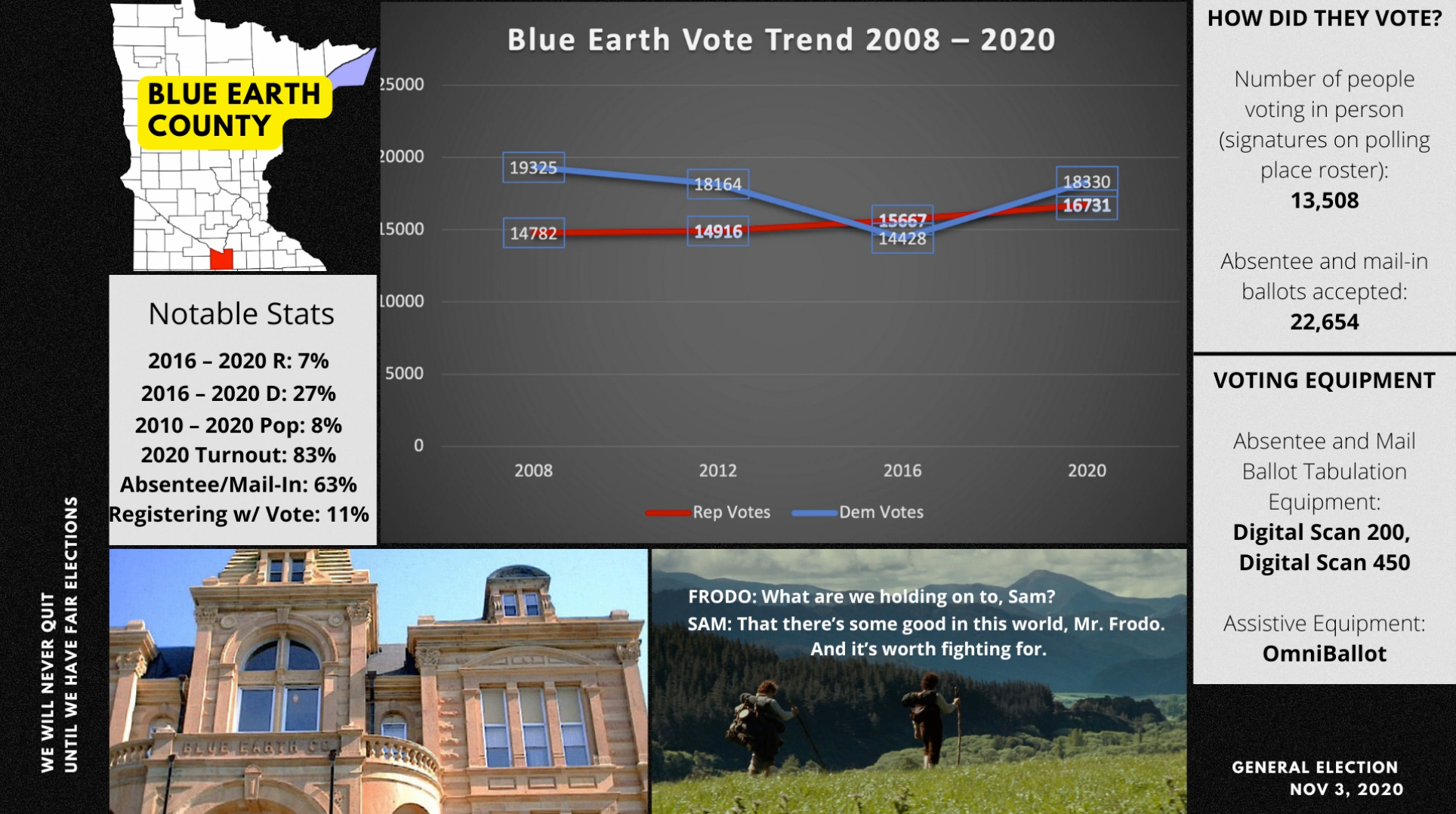
Captain Seth Keshel’s trends, lawn signs, and word on the street in 2020 suggested it would be a close call and Minnesota Attorney General Keith Ellison even seemed worried based upon his 3:57pm tweet on election day: “…We don’t have all the votes we need quite yet. So, help a friend (even a brand new friend) vote. Right now would be awesome.” Was this a signal to unleash additional mules? Or could it be—to name just one more possibility—that the electronic poll pad system notes which voters do not vote (neither submitting an absentee/mail-in vote nor voting in person in the precinct) and adds those voters to the phantom voter pile?
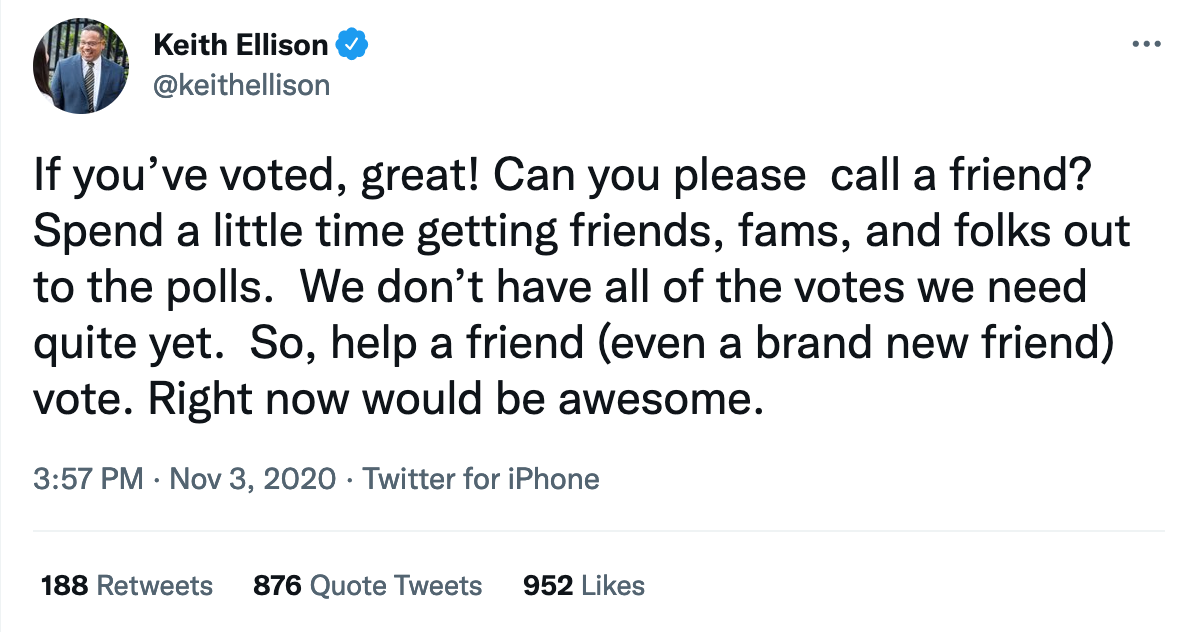
Therefore do not let Biden’s MN Canvassing Board certified 7.2% margin deceive you; to echo Seth Keshel, would Trump really have spent as much time and money here if Minnesota’s 10 electoral college votes were not in play?
Now, many Minnesotans are aware their state is well known for daycare fraud and food fraud. It is emerging that voter, ballot, and election fraud are probably as prevalent, or worse, as indicated by a combination of trends, forensic analysis of Dominion systems also used in several Minnesota counties, and coordinated vote trafficking findings presented by True the Vote in the informational hearing before the Assembly Committee on Campaigns and Elections on March 24th, 2022 in Madison.
Even though Milwaukee officials failed to provide the requested video surveillance, geospatial data and cell phone signal data revealed vote or ballot trafficking into drop boxes to the tune of 137,000 ballots, or 7% of all WI ballots (in the sample, 138 people met a minimum threshold of visiting 5 NGOs and 25 drop boxes during the 2020 general election period, and 10% of that group were also present at a violent riot).
Is there any reason to believe organized ballot abuse isn’t happening a few hundred miles west here in Minnesota? (In the cab ride to the Crystal Lake VFW for the CD5 Show on Saturday April 2, 2022, the driver said he’d heard ballot harvesting and possible trafficking was happening in Minneapolis—word of mouth has long been effective but is especially powerful in our censorship-ridden world.)
Nationwide, about 160 million votes were apparently cast after experts predicted about 145 million would be. About 45% of the 160 million were absentee or mail-in ballots. In Minnesota, absentee or mail-in ballots represented 58% of the total reported votes by the secretary of state. The office listed this as an indicator of their progress in a recent budget-focused annual report, a report which lacked metrics relating to security, auditability, verifability, and accountability.
Further, in Minnesota, we have mail-in only counties (about 1,000 out of 4,000) which speaks to the variance with nationwide numbers, but Minnesota’s record absentee numbers may also suggest the success of the absentee voting marketing campaigns and influence operations.
The scale of absentee or mail-in ballots in Minnesota was immense. Over 1.9 million votes were apparently cast this way. That’s a more than 1.2 million increase over the previous record.
Not only could absentee ballots sent to phantom voters that came back return-to-sender be collected, but NGOs may have had the ability to print ballots en masse and use mules to deliver them. Note that Minnesota does NOT use serialized ballot numbers or watermarking that I am aware of. Many people can be persuaded to perform illegal activities (like delivering ballots that are not their in large numbers) if paid. The operation would not necessarily be limited to those outside of election administration offices.
The rate at which canvassing in 30 Minnesota counties has shown that voters who reported voting in person were recorded as voting absentee raises questions.
The fact that more than 700,000 reported absentee votes were not connected to a voter in the statewide voter registration system (SVRS) 25 days after the election and only 5 days after the MN State Canvassing Board certified the election raises further questions. Read that again. 700,000 MORE votes than voters. And Simon still certified.
Could it be that some percentage of these 700,000 reported absentee votes were coordinated by bad actors and therefore were not easily reconcilable in the electronic systems? For emphasis: 25 days after the election and 5 days after certification by the MN State Canvassing Board the numbers did not check out. And not by a little bit. By over 700,000.
The reasons for this remains an unresolved issue.
The following table with data from Rick Weible shows the absentee ballots not connected by November 29th, 2020, in the MN SOS data in the Twin Cities area. Note that this work should be done immediately according to Minnesota Statute 203B.121 BALLOT BOARDS.
| County | Absentee Ballots Not Connected |
|---|---|
| Anoka | 4,537 |
| Hennepin | 17,830 |
| Carver | 33,741 |
| Scott | 46,220 |
| Dakota | 154,756 |
| Ramsey | 8,350 |
| Washington | 81,414 |
This is not an exhaustive list.
Furthermore, there is data gap between October 30 and November 3 which makes it difficult to audit the “must immediately” clause. The next table shows the absentee data and how it changed over time on the secretary of state’s website.
| Date Requested | Quantity | Date Accepted | Quantity |
|---|---|---|---|
| 10/25/2020 | 1,765,327 | 10/23/2020 | 1,186,522 |
| 11/01/2020 | 1,969,728 | 10/30/2020 | 1,581,193 |
| 11/04/2020 | 2,129,804 | 11/03/2020 | 1,846,668 |
| 12/01/2020 | 2,129,804 | 11/03/2020 | 1,846,668 |
| 1/16/2021 | 2,193,411 | 1/14/2021 | 1,909,701 |
| 2/14/2021 | 2,193,411 | 1/14/2021 | 1,909,701 |
In watching the room as Rick Weible has presented this data around the state in 2021 and 2022, many understand and are deeply concerned. They expect better from government especially when the issue concerns the sanctity of the elective franchise. And yet, as it now appears certain elements of government have proven incapable of administering free and honest elections with absolute integrity, citizens are right to wonder what else needs to be audited in their government at the federal, state, and indeed, the local levels.
Minnesotans want to know whether their vote counted, whether it was cancelled out by a phantom vote or a fake mail-in vote, whether a machine altered their vote choice, or even if the numbers provided to the MN State Canvassing Board to be certified have any connection to reality at all.
On this last point, we turn to next in the Backup Attack Phase.
One of my friends recently asked me why a ground game as seen in 2000 Mules was needed if forensic audits can be denied and votes can be injected electronically. My simple response here is that the enemy would have preferred we not learn about the depth of cheating available through the machines. The illusions we are under need to be plausible enough, else our instincts to spot a lie kick in.
In other words, if you can cheat enough to win by inflating voter rolls and by stuffing the ballot box, you can potentially reduce the chances that people will ask questions about the machines in the first place. I’ve heard people skeptical that there was enough cheating to overcome a 7.2% margin between Biden and Trump, showing exactly this problem.
Those who control the software, control who wins. Better to keep this reality under wraps.
This is part of the reason, I think, that while Hillary said she thought there was fraud in 2016, she may not have wanted to call for any audits because then there could have been discovery. And history shows that she did not. There was a different plan hatched instead.
Meanwhile, since 2020, while much focus has rightly been on mail-in ballots and the tabulators, it has emerged that the electronic poll pads and the integrated systems which provide monitoring and real-time reporting (and likely many other tricks) are also central to the puzzle and the overall cheater’s toolkit. Again, Let My People go is an excellent free resource to learn more about the surveillance ‘features’ of such Eye of Sauron type systems.
Chapter Five - Backup Attack
“The election of 2020 was not counted, it was calculated.”
—Draza Smith, mathmetician
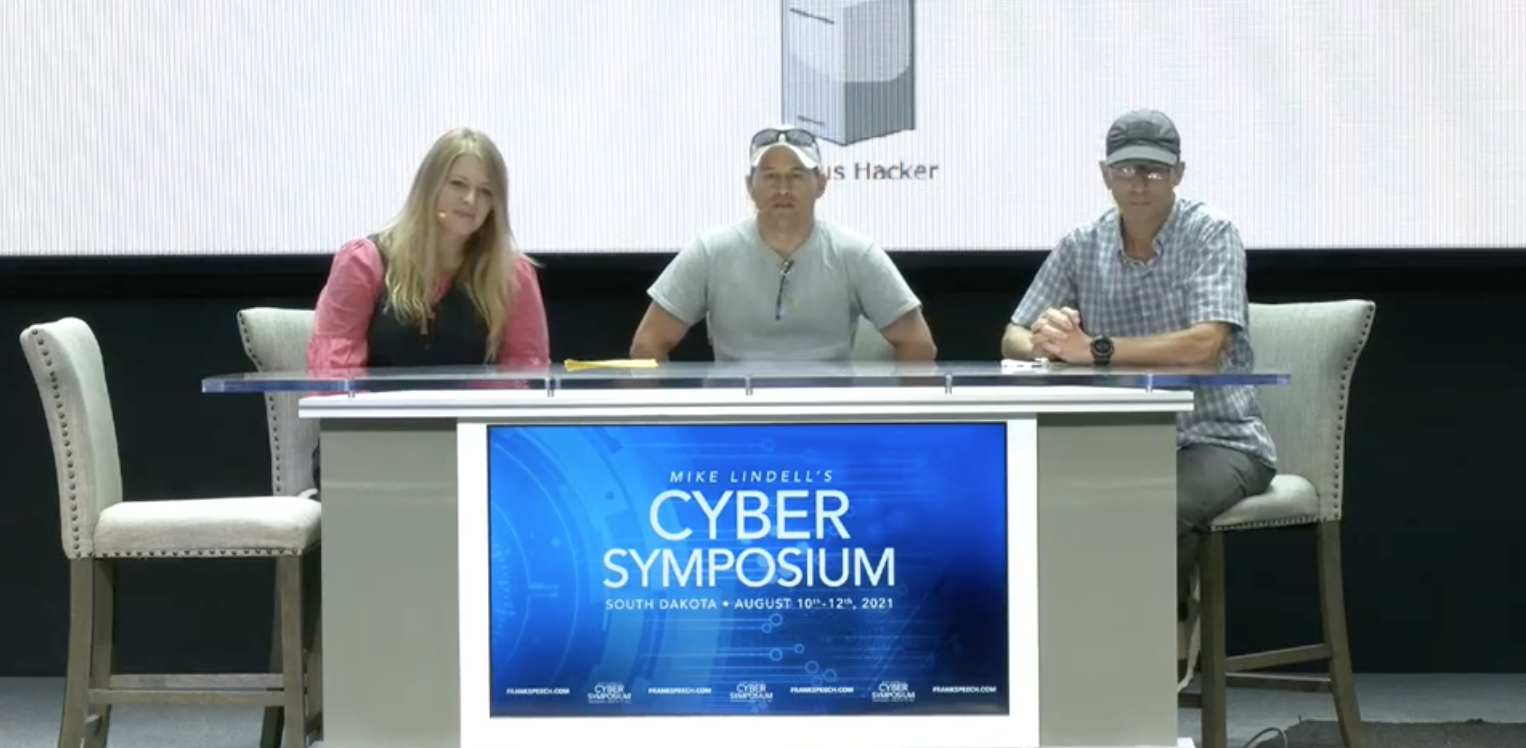
If the Attack Phase fails, the Backup Attack Phase comes into play.
This is where the story takes an interesting turn which may shake the reader’s previous understanding of how elections work.
For all the years of my life until 2020, I thought my vote counted. Then, in late 2020, I realized it probably didn’t, but I didn’t know how exactly.
Then, sometime in 2021, my perspective drastically (Drazatically) changed when I was introduced to Draza Smith’s work and later met her at the Cyber Symposium. David Clements has described her as an “unsung hero”. I am not keen on the word ‘hero’ generally but that is another topic!
What changed how I viewed elections?
Draza put it well: “The election of 2020 was not counted, it was calculated.”
Start with an electoral college map of the United States. To win the presidential election takes 270 electoral college votes. Then, use a PID controller, like in your thermostat or the cruise control of your car, to generate outcomes at the state level in such a way that the desired candidate wins.
Easier said than done, because you don’t know how many voters will turn out, either for the desired candidate or for the undesired candidate.
Except that you kind of do… We’ve already talked about how many people mailed in their ballots early or showed up early to vote. In Minnesota, there are forty-six (46) days of voting. I don’t know why 45 or 47 days were chosen, but I wasn’t [s]elected to write the laws!
In that 46-day window, data on who is voting is collected. Using historical data in the voter histories, the map of how the state will vote, all the way down to the precinct level, can be projected. As it gets close to election day, the PID controller’s set point can be decided. (In 2020, it appears that overnight when ‘vote-counting stopped in all the swing states because a pipe burst in one of them’ the set point needed to be reset, as shown in the upcoming graphs.)
It’s indeed possible that the original set point in each state might need to be adjusted to get the desired outcome state by state to achieve the electoral college victory for Biden. Again, is this why vote counting needed to suddenly stop in multiple states in the middle of the night?
This part of the book, more than others, requires the visuals, charts, and graphs to be in front of you. If you are listening to the audiobook, print out the pages from the e-book freely available at https://leanpub.com/sim2020/read.
Edison Zero
For background on Edison data, recall this chart from Russ Ramsland’s Georgia presentation in December 2020.
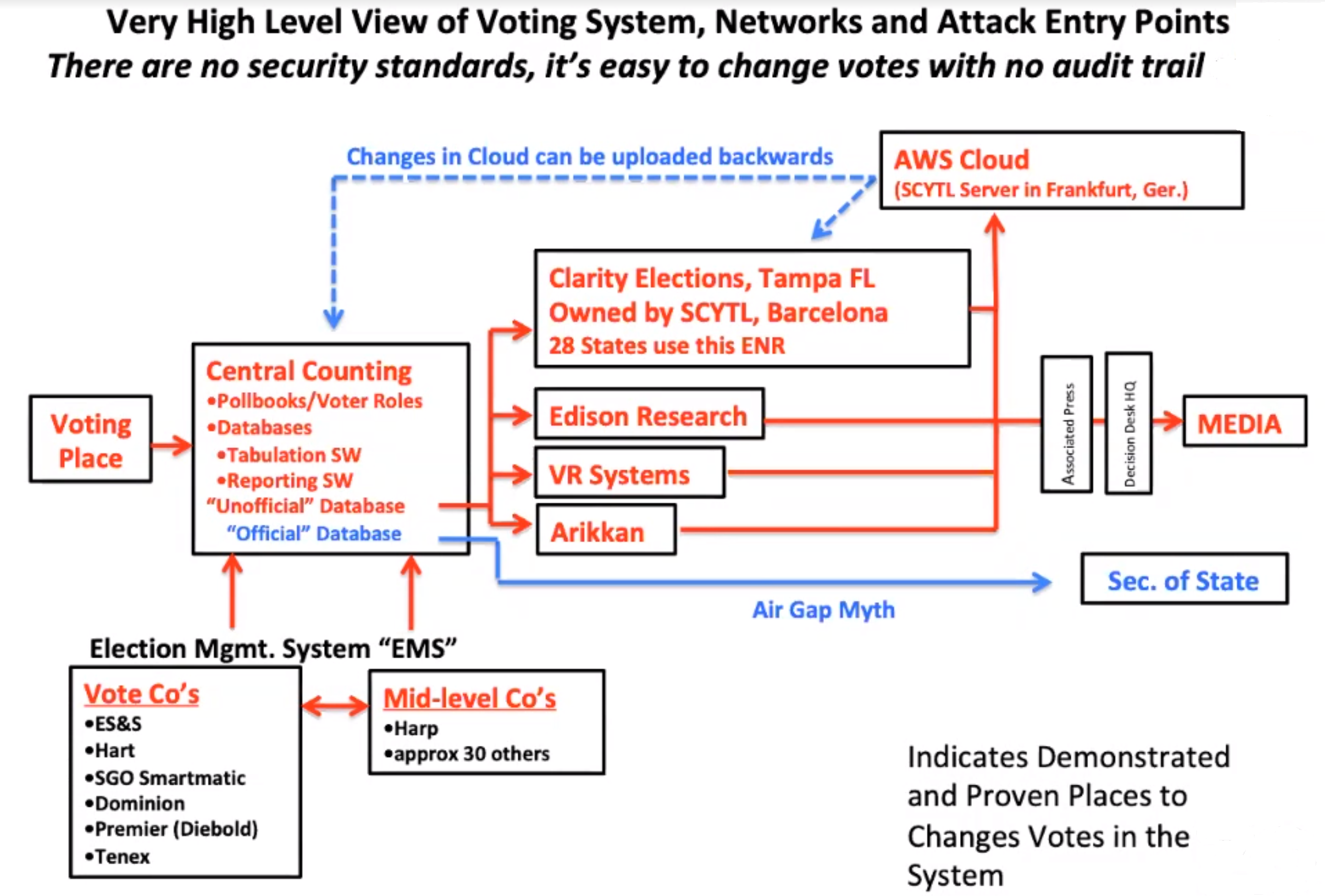
Draza also writes: “For those asking - the Edison data reports the cumulative votes and the percentage that each candidate has during the election. But - during the Nov 2020 election, these reporting values all went through a rolling zero that then returned to relatively the same values on the next reporting cycle. It happened in series to each state and DC. I suspect that this was application of new setpoints and/or new control constants to drive the vote totals to the setpoint within the number of votes remaining in the count.”
Here’s an example of New Jersey’s Edison Zero on November 4, 2020 starting at 4:01:23 AM and lasting until 11:35:48 AM.
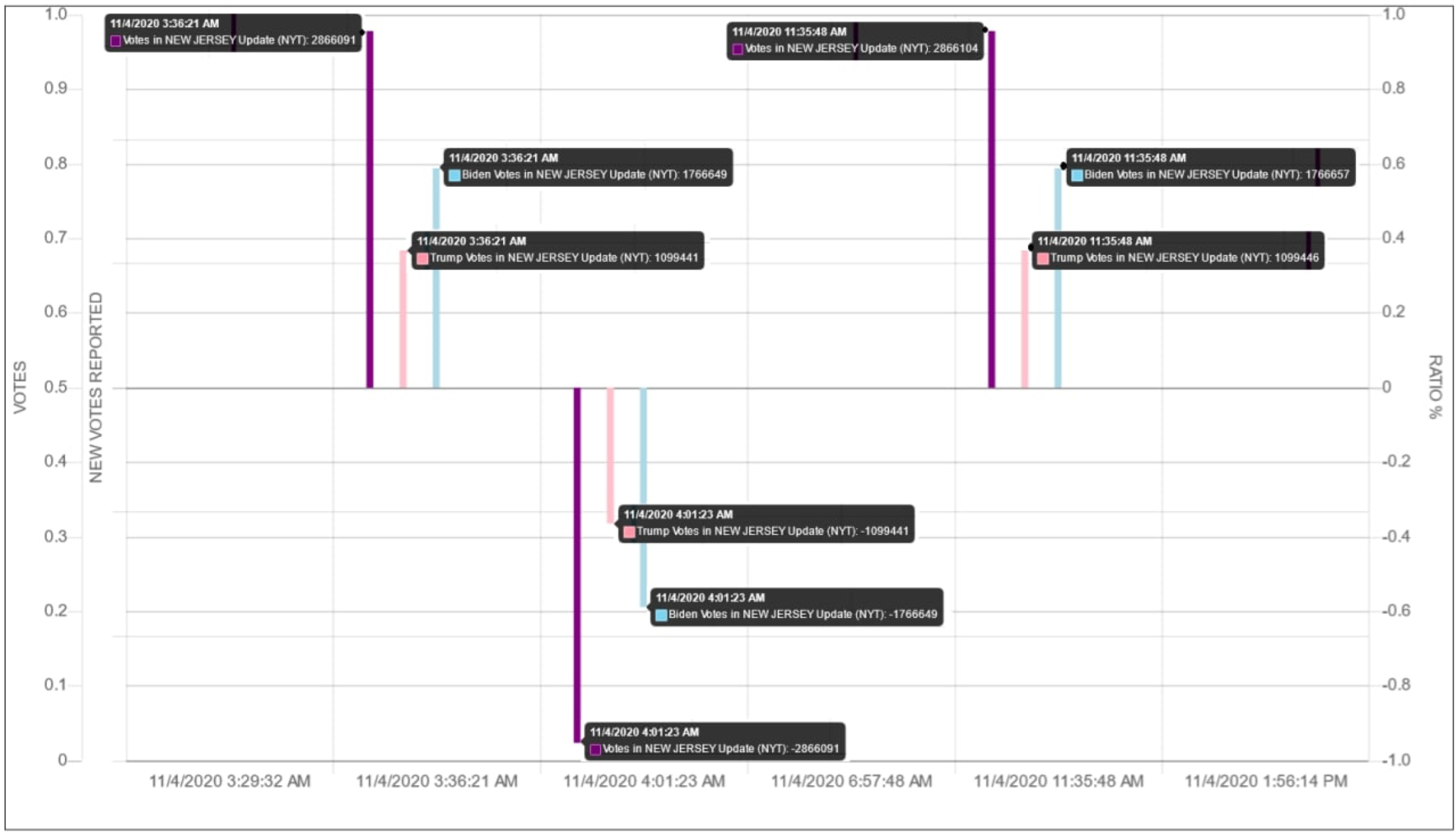
Rhode Island
Erin Clements recommended I have a look at Draza’s analysis of the Rhode Island cast vote record (CVR) and compare it with what Edison played on TV. Reason being that it was the “best synopsis of the set point phenomenon and the shuffle because that’s the only place where we have apples to apples comparison between what we were told was happening on election night and what’s actually stored inside the computer system—they can’t be reconciled.”
On Draza Smith’s Telegram channel, all of the following charts and descriptions can be found by using the search function and typing “Rhode Island”.
On August 3, 2021 Draza said: “So - Rhode Island is one of the more surprising plots I have seen so far. During the entire election reporting, the ratio of votes was on the Trump side of the line…until they were slammed down into their setpoint…
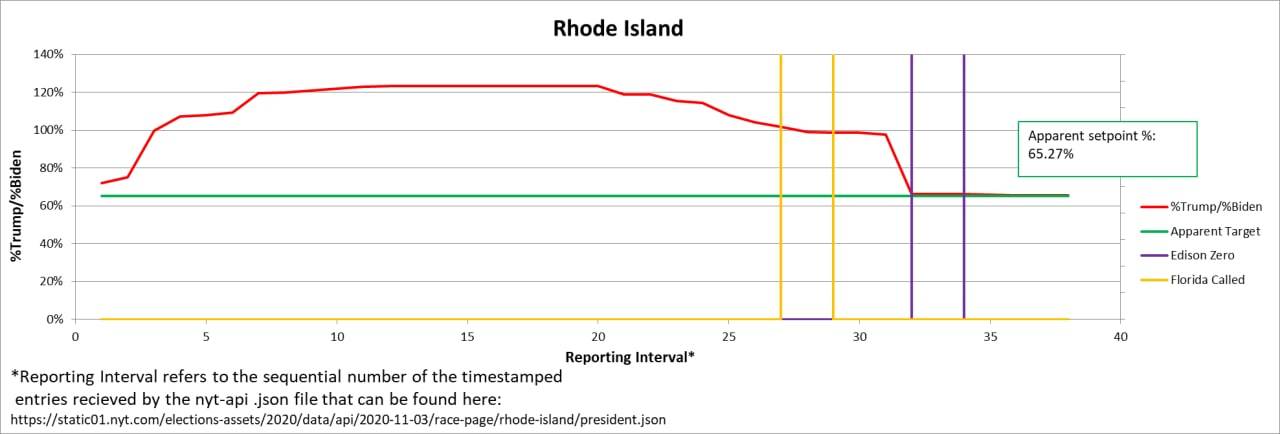
“Looking at the total vote trend, there was a clear preference, until that pesky Edison zero reset….”
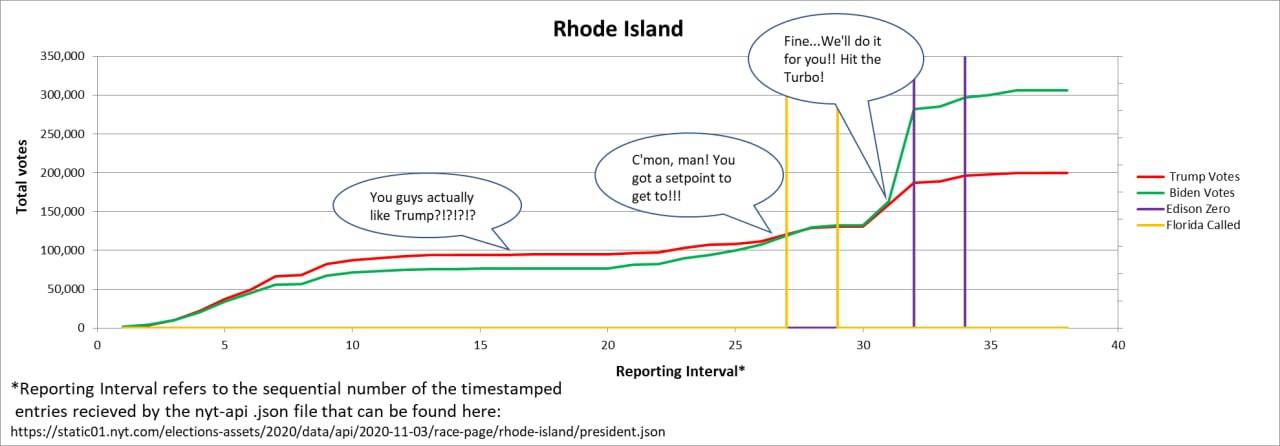
“From the Edison reported percentages, you can see the HUGE spike in the Biden votes prior to the reset, which has been indicative of receiving a new setpoint and higher tuning constants.”
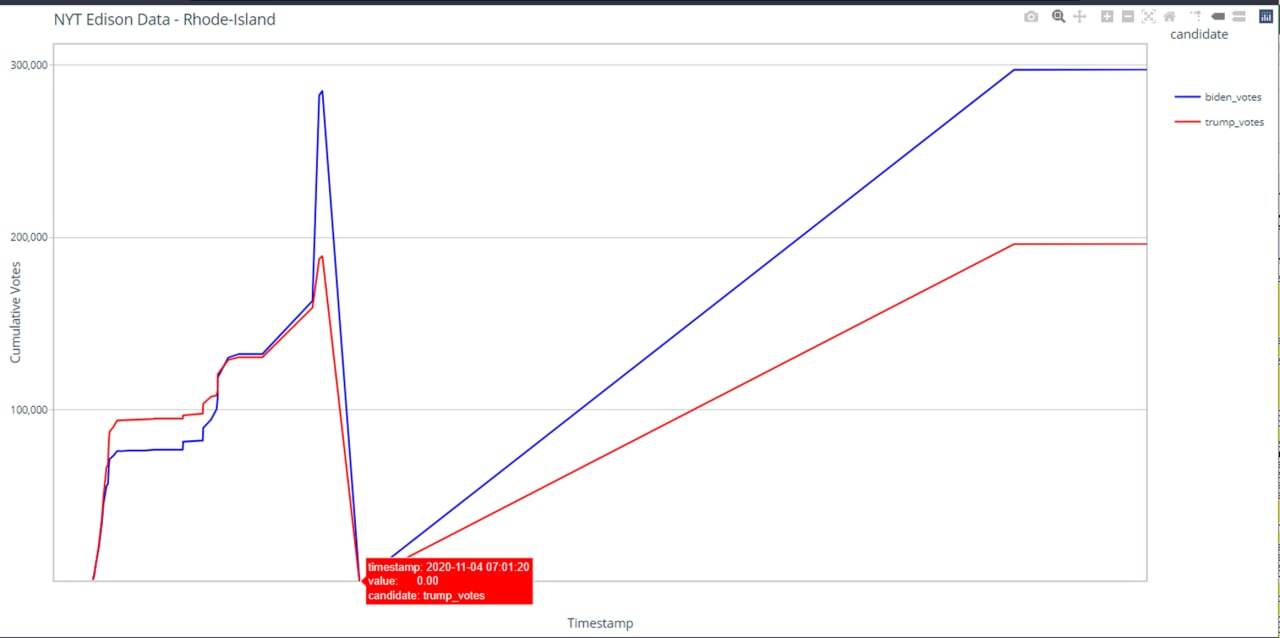
“In the data you can see it happen here. The ratio setpoint is driven from 97% to 66% and the Edison zero happens 4 minutes later.”

Then, on the 21st of May, 2022, Draza announced this:
“I am so grateful our smallest state today. Because the entire state is smaller than many counties in other states, they do things a little more efficiently there, including counting all of their statewide votes with a single system that produces a STATEWIDE CVR.
“So, I have been saying for a while now that I have been confused about the fact that none of our counties/precincts can give a good explanation of how Edison and Scytl and SP are getting the election data to the NYT, etc. for election night reporting and CALLING THE RACES ON!
“But, I believe these companies know the playbook and just provide a probabilistic model to the viewers at home - so how can you question the results? You watched them come in live on TV! All the while the mules and machines and NGO’s with electronic access to the voter rolls/poll books are working magic on the real votes have them end in the same place.”
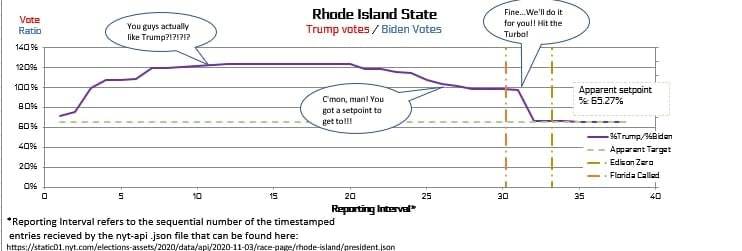
“So, here is the results as we saw them election night for the State of Rhode Island! This is how the ratio of Trump to Biden votes were reported by the news to all of us sitting at home on election night.
“That Drop towards Biden looks a little funny right there after FL was called for Trump, doesn’t it?”
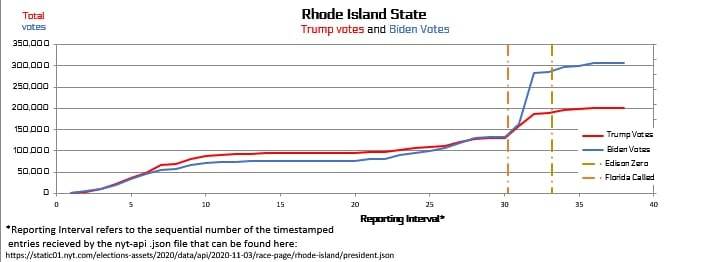
“Here are the actual votes for each candidate that were reported over time. Did you realize little Rhode Island had their very own “F curve”?
“Well, actually it looks kind of like a snake in the grass…”
“So - now we have the CVR data to see what the MACHINE says about how the votes counted up. Before I show the plot, remember what we have learned through the work by Jeff O’Donnell on finding the two sets of books in the database. And my theory that they reshuffle the database to push those muled in votes that come in just under the wire forward in time to make it look like they were always there.
“This produces a distinctive curve with a drop and then a scoop (which Dr. D has termed the “Biden Boost” and then the votes float back upwards to the final setpoint, with corrections here and there. Right?
“Well, even here in RI where it would be totally obvious, the machines could not help themselves. It is in their code.”

“So - here is what the machine told us with the CVR report of how the ratio of votes ACTUALLY cough, cough came in for Rhode Island over time.
“The blue graph below shows the precinct index that each ballot came in from. This is term I have developed for places that do not have numbered precincts. I take the list of precincts and record the precincts in order as they show up as precincts 1,2,3… and then I can plot them. Anyone that is interested - I can provide you my precinct name-to-number key.
“But what is notable here is - just like in other places, ALL the precincts report in at the very beginning (REPRESENT!) and then are shuffled to look almost too perfectly randomized with keeping some from every precinct in the back pocket to add at the end of counting.
“But - remember - if we were getting in votes perfectly randomized from all over the state - would the Law of Large Numbers dictate that this rollercoaster would be the shape we would expect?”
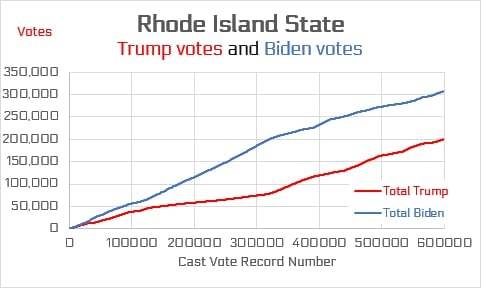
“And - if you could possible believe it, just look how evenly over time the votes came in for each candidate!! No snakes in the grass here…just in the programmers’ seats.”
“And - believe it or not - those RI Patriots collected more data - interim reports of vote counts, etc. NOTHING MATCHES, not the news data, to the machine data to the SecState data - sure , they all end up in the same place after a month or 2 of making ‘corrections’.”
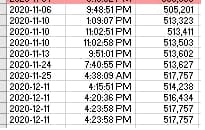
“Check out the corrections that the Edison data made to get to the final results - after over a month worth of “corrections and updates” - because this is how we should count election votes.
“P.S: I dropped out the reported vote from the AP that wasn’t Edison because they appear to not have ben synchronized and make even more crazy jumps, as a result.”
Minnesota’s Simulation
No Minnesotan has been given any cast vote records from their county for 2020 (except for Fillmore County), although these only came in the form of a comma delimited-type file (think .csv or .xls), not in the form of the ballot images themselves which the computers/tabulators read to interpret the voter’s ovals and record the vote tallies. Not being able to produce an audit trail of the machine count, when the machine count is the primary method of counting, is unacceptable AND it puts the public in an awkward situation of not truly knowing whether ANY of their current legislators were fairly elected. Even when recounts are triggered, there is NO audit of the legitimacy of ballots included in the recount and recounts occur days, sometimes weeks, after the election. Again, think back to how easy it was for Rick Weible to order and receive 9,000 ballots from Minnesota operator, Seachange.
Since we do not have the cast vote records from any county, let alone the entire state as Rhode Island was able to produce, let’s make do with what we can.
Let’s start take a look at how votes were reported to the media (refer back to Russ Ramsland’s slide above for reference). The following graphic shows how the votes were sent through to the media from Edison Research. Notice the negative 194,846 votes near interval 50. In a system that is aggregating votes, should there ever be a drop in nearly 200,000 votes? What may have caused that?
Here again I will quote Draza Smith:
“So - Minnesota had some really interesting things going on that took a little bit of thought. I am finding a lot of events that happen across states that help me try to convince all of you our elections are completely controlled events. Minnesota - I believe - kinda went like this:”
“The overall votes have a very high correlation with an R value of 0.9978, which is higher than Pennsylvania, but Pennsylvania was the states that had the same “event” happen, with regard to the loss of votes during counting. I pulled up the similar curve from Pennsylvania and, not only is the shape factor almost exactly the same, but it happened during almost the same counting interval number - around 50 - which, timewise, was shortly after the Florida surprise.”
“The difference in the shape that follows whatever was happening that caused the similarity between the events in PA and MN is the result of the difference in the initial perturbation that was assigned to each state. PA had one that was more chaotic that MN.”
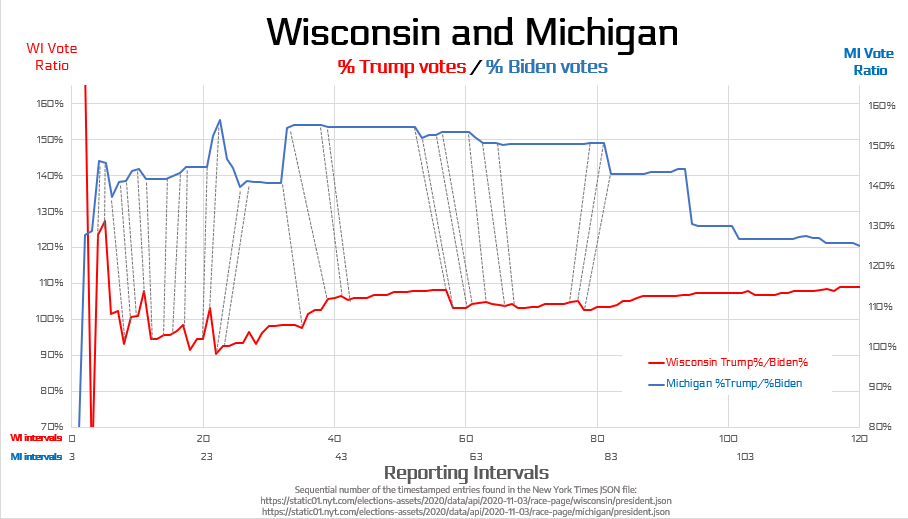
To demonstrate that similarites between states are not isolated, notice Wisconsin compared with Michigan.
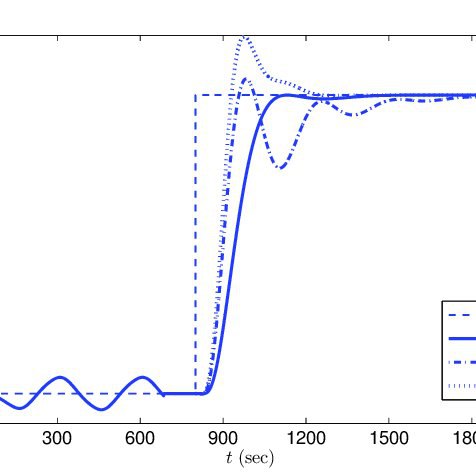
“The “setpoint change” that appears to occur later on is most likely the result of a slight shifting in position as MI was being moved in the lineup. I refer to this as a setpoint change, because it bears a striking resemblance to what we would see in any industrial system that is being controlled and experiences a setpoint change. This is the image that I used on the graph above that - should - have nothing to do with elections.”
When Draza refers to MI (Michigan) being moved in the lineup, consider that since Florida’s Trump turnout was so high the algorithm was not going to be set in such a way to achieve a Biden win. It appears the decision was made by the powers that be to let Trump win Florida but pick up those electoral college votes elsewhere. Thus Michigan being moved in the lineup.
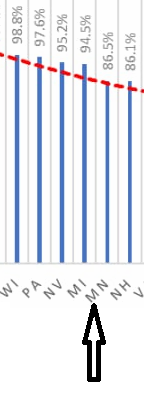
“If we go back and look at the national key calculated from the final values, you can see that MN is right there at the edge of the shuffle - and probably was affected by the moving of MI into the Biden side of the curve.”
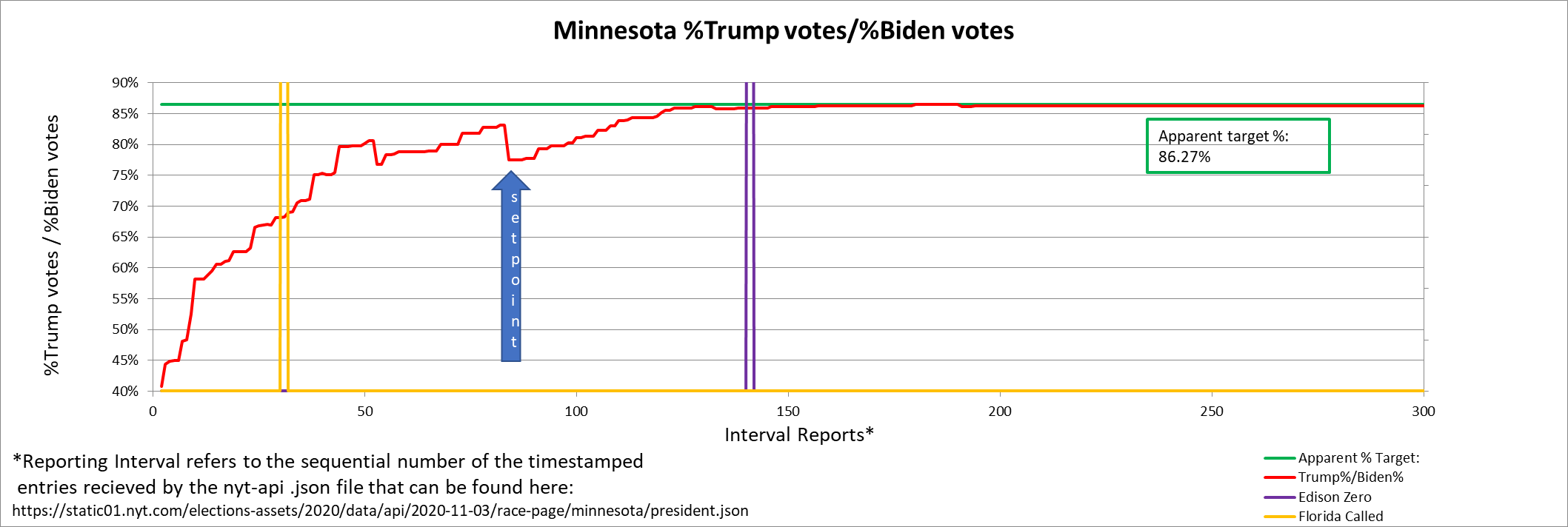
“Here you can see the ratio control curve with a bit of a chaotic start and that “event” after Florida was called. But, after she got her final setpoint, the curve just eased its way into the final setpoint, like we have seen in so many other states.”

“Now, the adjustment to that final setpoint was really a herculean effort by our vote counters. We were able to report 289157 votes in 17 seconds. This reduced the percentage from 83% to 77% Trump to Biden votes, because Biden received the lion’s share of that valiant effort.”

“So - that number - 194846 - is kinda like the other reductions we have seen in other states. If you take that number and divide it by the total on the line above, it is usually apparent that is it a calculated reduction. If we do that here 194846/2071091 = 9.41% reduction. I would have expected it to be 9.5% of 10%…a nice round reduction like seen in other states. So, I looked as what we have going on. If we look at the reduction in just Trump’s votes, what we have on this line is a reduction coupled with a flip from the 3rd party. If we remove the flip from the 3rd party, we get a reduction of 87049.15 votes from Trump’s tally, which is a 4.20% reduction in Trump’s overall vote at that time.”
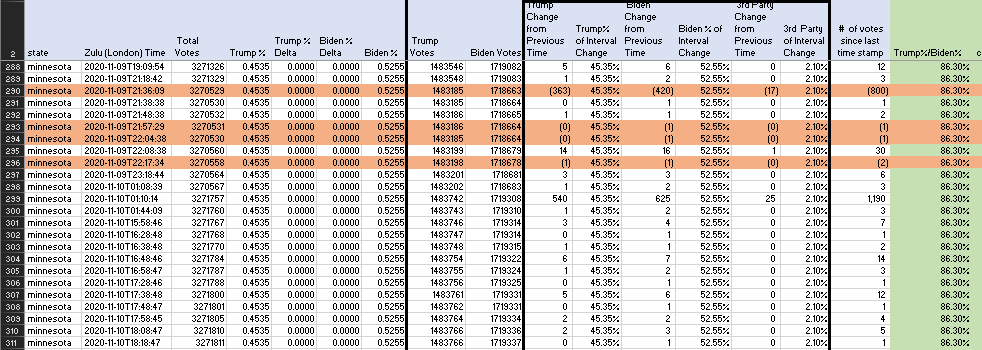
“Annnddd - we finish up, much like the other states. We have our percentage control of the interval hanging tight - while we find places for the reductions to happen, without changing either the interval percentage distribution or the overall percentage ratio. These cleanup reductions are in between the reports that take about 10 minutes for each single vote to be counted. I guess they were tired from the big push earlier.”
Does reviewing this data make the reader look at our election process differently?
I know when I first saw this data I was unsettled—I hadn’t considered this possibility. But with this new information I went forth with new questions.
Remember that the Backup Attack phase is used when the initial attack doesn’t go as planned. The biggest tool is the injection of votes electronically. If this can be done without detection, a race can still be won regardless of how many physical ballots were delivered absentee (dropbox or mail-in) or at the in-person polling place on election day and subsequently scanned through tabulators. In a totalitarian system, election night reporting could be largely or actual theater and disconnected from results aggregated at lower levels; citizens could be shown results and then later barred from auditing election materials altogether and appeased with piecemeal post-election reviews which only review a tiny number of ballots.
There is a theory out there which Draza’s data begins to provide evidence for that the 2020 election was less an election and more a simulation disguised as an election. (This is in part why I made the acronym for the title of this book = SIM.) We don’t need that perspective to lay out the anomalies, indicators, and evidence we’ve done up to this point in the book, but it does serve to provide a working explanation for the irregularities reported around the state and in the Edison Research data. Data is only as good as its source.
Once the simulation concept is understood, lower level manipulation can occur in the databases or voting machines in counties and precincts to achieve results at that lower level which align with the top-down algorithms. This may be part of the reason the Office of the Secretary of State in Minnesota stops providing absentee data a few days before elections and does not provide it until a few days after. Meanwhile, the official results don’t have to reconcile or match the Statewide Voter Registration System until about 6 weeks post-election, AFTER the MN State Canvassing Board has certified the election. Indeed.
Case in point: Around September 2021, I remember video calls where Jeffrey O’Donnell and Dan Sundin shared preliminary findings from the before and after server images revealed by Tina Peters on Days 1 and 2 of Lindell’s Cyber Symposium (see the documentary Selection Code for more details). To this day I encounter folks who were disappointed by the event in Sioux Falls: I may share their confusion regarding the PCAPs but I will not hesitate to point them to the three Mesa reports.
When I first spoke publicly at the Sherburne County Commissioner board meeting on April 19, 2022, I mentioned some of the findings of the third report. (Others had already begun to do so.)
It turns out that the government does the election administration work and needs to prove that its work is sound, although refuses to do so. It isn’t for We the People without access to the information to make that case… although we have had to do so because of non-compliance from those whom are meant to serve us.
If the cover up in the Defense Phase, which we turn to next, is good enough, then many citizens will not immediately be able to find out exactly how subversion of their elections took place.
Chapter Six - Defense
“Are you ready?”
- Mark Cook
The Defense Phase is where the attackers try to defend against what Patrick Colbeck calls the meddling kids from discovering what they did. It involves cover ups, destruction of physical and digital evidence (Dominion’s Trusted Build), slow walking and infiltration of livestreamed election audits (the Maricopa audit), media bullying, and lawfare. Unfortunately, it has too often involved government officials, further eroding the people’s trust in the system.
This phase began on election night 2020 and in many regards we remain in this phase, even in early 2025, with respect to 2020 but also now to 2022 and 2024.
Some object to the prospect of coordinated fraud on the grounds that it would not be so easy to cover up.
But if there were people smart enough, sophisticated enough, and resourceful enough to pull off such a heist nationally (and likely involving international and supranational components), wouldn’t it stand to reason that they would have some kind of plan to get away with it? They did, although in retrospect it was a bit sloppy and there were eyes on their actions. For example, people like Patrick Colbeck, author of The 2020 Coup, were on the scene at the TCF center in Detroit serving as a certified Poll Challenger when the vans arrived in the early morning hours.
The people that did this may be clever, but it was an uphill task to pull every lever and not spring a leak.
The first leak was on election night when there was a coordinated pause to vote counting in multiple states.
That alerted millions if not tens of millions to the subversion right from the start. It was only a matter of time before the riddle could be solved, despite extensive interference from many you might have thought would have supported election accuracy and transparency, but who have revealed that they do not.
Part of Their Plan?
At the Cyber Symposium, Dr. Shiva gave a presentation which detailed the connections between the various players and mentioned a few of their published playbooks. These are recently coming into view in a different way through the work of people like @DataRepublican on X. One of these publications was The Long Fuse, by the Election Integrity Partnership.
On page 3, the ‘Data Cleanup’ phase immediately follows the election. What data exactly needed to be cleaned up?
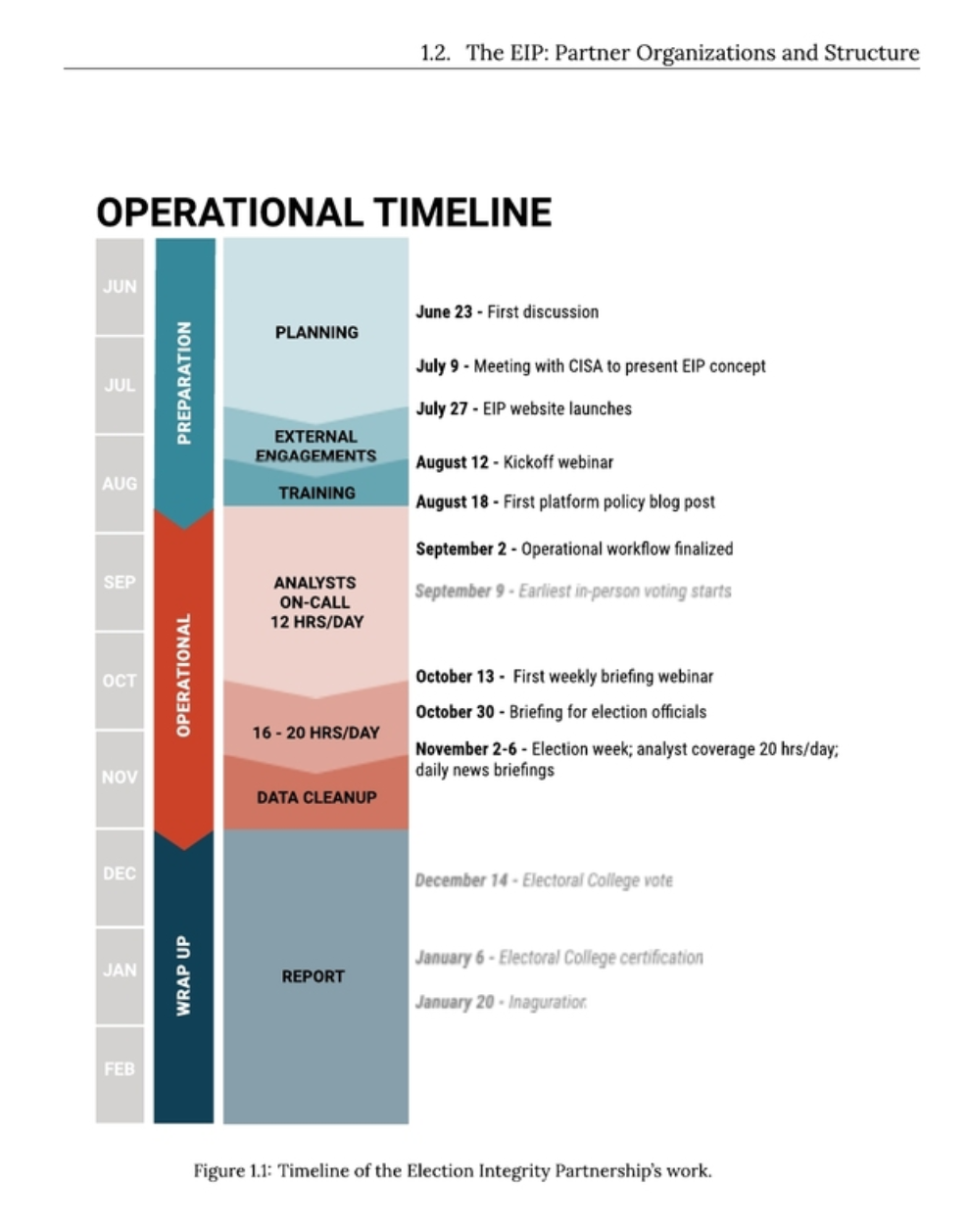
Part of the data cleanup being done would need to happen with the voter rolls. Public requests of these rolls and comparisons between them show large changes across time in registrations. Presumably this could cover up large additions of phantom voters just prior to elections.
But what is harder to cover up is detailed comparisons across counties in a single state, as was shown by Erin Clements in New Mexico’s voter rolls, or the proof of database manipulation in the Mesa County, Colorado Dominion Trusted Build.
700,000 Reported Absentee Voters Not Connected in SVRS
Rick Weible’s database analysis of Minnesota’s statewide voter registration system (SVRS) highlighted that there were more than 700,000 absentee voters reported than documented in the SVRS five days after the MN Canvassing Board certified the election.
In other words, 700,000 MORE votes than voters. Did these ballots even exist?, one wonders.
In a June 7, 2022 GGP meeting in Dakota County, former Election Manager of Dakota County Andy Lokken said that after the fact comparative analysis of SOS-reported data with the SVRS data was not an effective way to verify results.
Then how should an election be verified by the people?
Bear in mind that no statewide nor any county-wide full forensic audits (of all election materials, not a recount of ballots) has been done in Minnesota, ever. Citizens have faced considerable resistance from those responsible for ensuring that no voter is disenfranchised and have succeeded in finding numerous indicators and proof that election processes were not followed according to statute and that the results are therefore seriously in question.
Regarding the absentee voters: If the SOS data was not at all consistent with the SVRS data 25 days after the November 3, 2020 election, when was it going to be? And how did the MN State Canvassing Board certify the election 5 days prior with such a large discrepancy? To repeat, on November 29, 2020, just 5 days after the MN Canvassing Board certified the election, more than 700,000 reported absentee voters were not connected in the statewide voter registration system.
This fact alone should have triggered a statewide audit and uproar from any elected officials that care about election integrity. If you are unsure about your local elected officials, ask them what they think about this issue and whether they believe we ought to have higher standards for our absentee ballot process as it pertains to data accuracy in our statewide voter registration system.
Many are not aware that although there is a clause about party balanced absentee ballot board judges (those who process the absentee ballots as they come into the counties), the counties have the option to simply staff those boards with their own employees who do not have to be balanced from the major political parties. In essence, the statutory oversight is minimal regarding absentee, which, in 2020, was the majority of ballots at 58%, or 1.9 million (1,900,000).
From the perspective of the defense phase relating to absentee ballot coverup, deflection and obfuscation of the 700,000 ballot delta that Rick called out (it still remains unresolved) should be expected—the general public learning this certainly threatens to undermine the credibility of those at the helm.
Minnesota Post Election Review Reveals Missing Ballots
The local media likes to report on the success of risk-limiting audits (RLAs) which are known as post-election reviews (PERs) in Minnesota. Let’s discuss why these are not suitable to demonstrate the total accuracy and integrity of a machine-driven and absentee-driven election.
In Minnesota only about 3% of of precincts per county are subject to a post-election review according to Minnesota Statute 206.89 POSTELECTION REVIEW OF VOTING SYSTEMS, although counties can opt to do more.
In 2022, there were at least two counties that opted to do a few more, mostly to appease advocates.
Then, in 2024, spurred on by the Anoka County Election Integrity Team (ACEIT), the Oak Grove City Council voted 5-0 in favor of performing a post-election review of all four of their precincts, hopefully for all the contested races as well. 7 cities in total desired this out of 21 municipalities in Anoka County.
A post election review hand counts ballots returned by the optical scan ballot counters in select precincts.
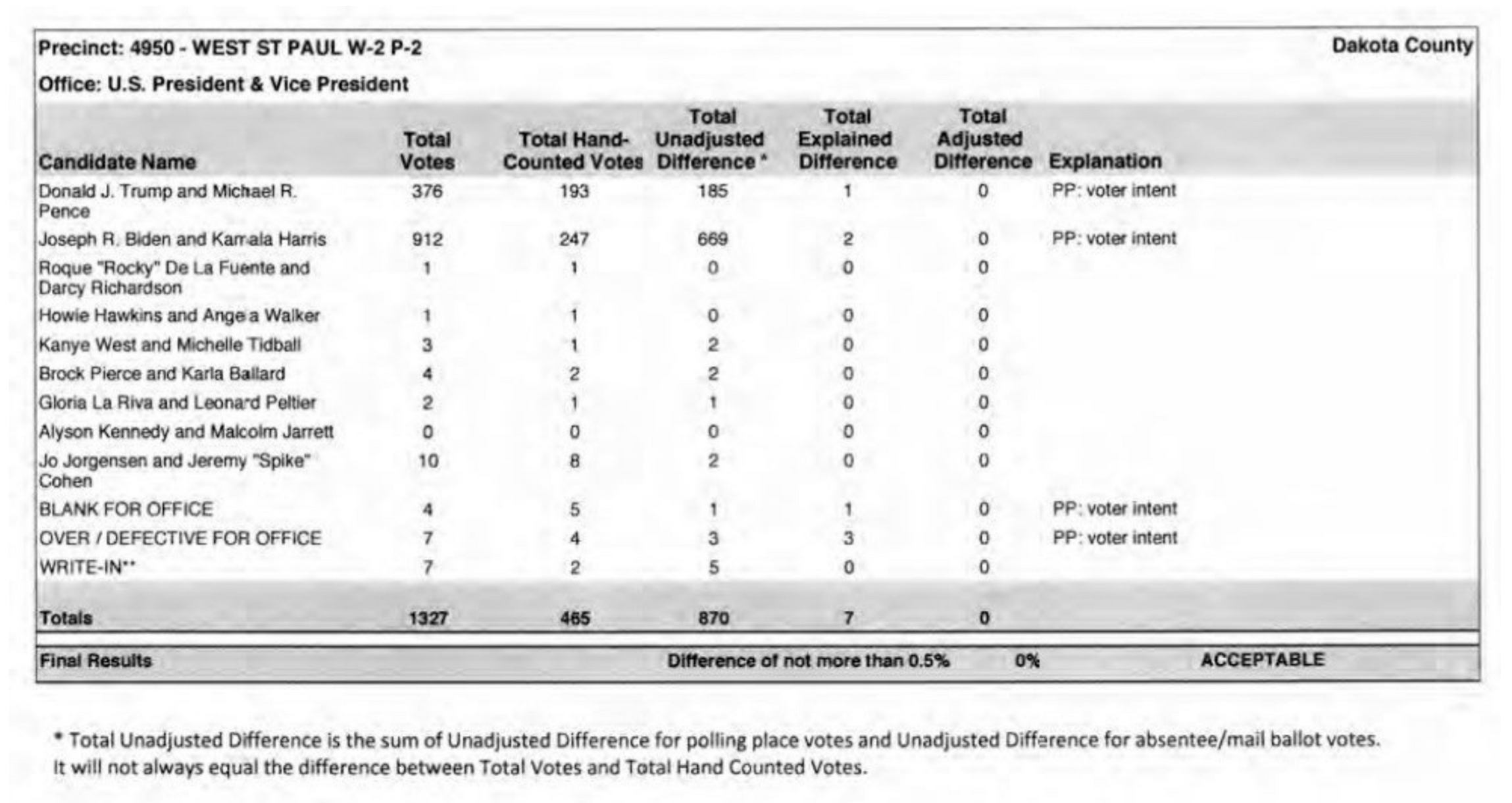
Stepping back to 2020, in a postelection review in Dakota County’s Precinct 4950, WEST ST PAUL W-2 P-2, the total unadjusted difference was 870 votes. 7 of those 870 votes were explained, but 863 were not explained. Why then does the total adjusted difference (the last column) show all zeros? The total adjusted difference should read 863 (870 minus 7). Even with 65% (863 out of 1327) of the total votes in this postelection review left unexplained, the Final Results row says this is a “Difference of not more than 0.5%” and the Total Adjusted Difference is “0%”, deemed “ACCEPTABLE”.
Of course, this is clearly not acceptable and it begs the question: How many more precincts would turn up red flags like this if more postelection reviews had been done? And how many more red flags might be raised if proper audits were done? Is this why cast vote records (CVRs) and corresponding ballot images have not been forthcoming from local election officials? With this work being shown to Minnesotans, it would be strange if they were not asking for audits and accountability.
What this example demonstrates even more is the difficulty of reconciling the paper ballots to the machine counts. If a top-down simulation is being run that needs to be backfilled after the fact with ballot (or printer) deliveries to precincts and counties 2000-Mules style, but that last-minute work isn’t completed, then the outcome would be what we’ve seen in Dakota County’s Precinct 4950.
If the reader thinks the comment in the previous paragraph about printers is a joke, it is not. Two Dominion printers arrived on the day of the post-election review in Dakota County described above, although their bill of lading showed there had been an attempt not to have them arrive on that exact day. Yet there they were.
What’s more, by comparing the increases to Trump votes (from hand count to total votes) with the increases to Biden votes (from hand count to total votes), we also gain insight into how an weighted ratio algorithm might have been used to increase Biden votes by almost 269% while Trump votes only increased by 95%.
You be the judge. Was this data cleaned up well?
When Kim Bauer received in June 2022 the receipts from post-election reviews done in Dakota County for 2020 as well as 2021 (when her school board election took place), it was discovered that some of the post-election review documentation differed from the originals. I sat in on one meeting where Dan Wolbert and Rick Weible asked the election manager Andy Lokken and his boss for more information and to my knowledge it still has not been resolved.
It was far from the only issue from 2020 onward.
A Petition to Stop the Certification of Minnesota’s Election
Based on the postelection review above (but not only that) it was correct for Susan Shogren Smith to properly serve a petition to each member of the Minnesota State Canvassing Board prior to its certification of the 2020 election, in part reading:
“Minnesota candidates for office and voters have come forward with affadavits detailing concerns and observations about the ignored and failed election processes in counties across the state…If this Court does not take action to prevent the certification of the Minnesota election until a complete, bi-partisan statewide audit of the election occurs, including election materials, our election system, and the trust of the voters, will be irreparably harmed.”
The MN State Canvassing Board is the sole entity identified in the MN Constitution carrying the duty to canvass the statewide election results. However, the MN Supreme Court erroneously ruled (in my opinion) that all 87 counties had to be served. Therefore the case was dismissed without a hearing on the facts on Friday afternoon, December 4, 2020. This dismissal was critical to meeting the the safe harbor deadline of December 8, 2020.
Since that time, every point made in the petition has been confirmed by the work of Rick Weible and others, including “issues related to procedure, observer and election judge access, voter intimidation, lost ballots, lost absentee envelopes, missing election materials and questionable ballots… [and] concerns about voting equipment transmitting results during the early counting period on election day.”
Susan Smith also helped the Minnesota Election Integrity Team (MNEIT) to file five election contests for senate and congressional races.
Those and the two that Edwin Hahn helped to prepare were all dropped, although not until well-known and now infamous lawyers such as Marc Elias of the east coast Perkins Coie signed into the cases pro hac vice (out-of-state).
The cases were dropped without looking at the evidence. And there was a lot of evidence which Jose Jimenez, Ali Hopper, and the team had collected from attending about 60 out of 87 post-election reviews throughout the state following the 2020 election.
Then something happened.
Susan Smith was brought before a hearing with Judge Castro of Ramsey in 2021 and there it was wrongfully decided she had committed fraud on the court. (See the Bonus Chapter for more.)
The details of this are too much for this particular book, but they are essential background for anyone who wants to understand the layers of the system we are caught up in and why our government and related systems requires an immediate and complete audit, top to bottom, and bottom to top, in order for Minnesota to be revived.
The reader is encouraged to read this briefing submitted by Susan Smith at the close of a disciplinary hearing brought against her by the Lawyers Board which does an amazing job of summarizing the landscape, climate, and timeline of events related to the five election contests in 2020 and the petition to stop the certification, which are certainly relevant to Minnesota voters and the people of Minnesota generally. Look for the Respondent’s Post-Trial Brief for File No. A23-1890.
If you can’t find it, simply read the brief here.
Before going into just few details from counties I interacted with in 2022, and a few since… I want to discuss pushing back against tyranny and the significant matter of the missing (or withheld) cast vote records and ballot images from previous elections, in particular 2020 and 2022.
Where Are the Cast Vote Records?
Cast vote records (CVR) are automatically generated when the tabulator interprets the ovals selected by a voter from the digital image (known as the ballot image) it creates when a voter (or election worker) inserts the ballot into the tabulator/scanner.
These have been a standard since 2005.
The cast vote records and their corresponding ballot images were denied to the public in Minnesota throughout 2022 and 2023 before the 93rd Legislature admitted they existed by putting them into Minnesota Statute 206.845, Subdivision 3.
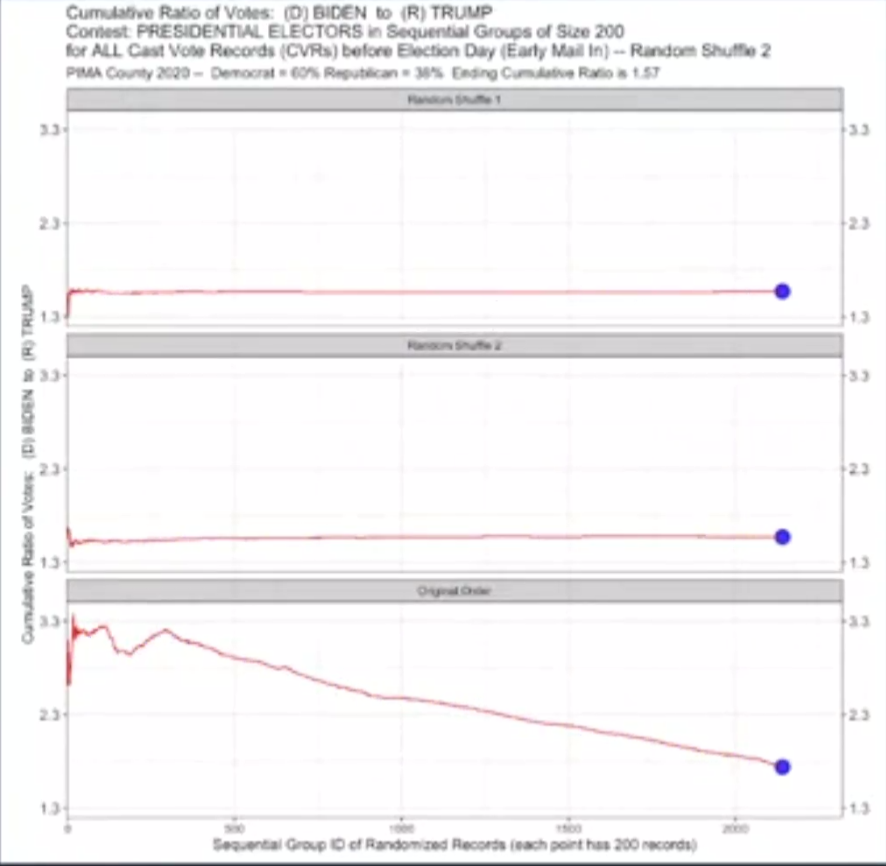
Have a look at this CVR from Pima County.
The top two graphs look good.
But the third (bottom) CVR is not realistic. The only way that could happen is if there happened to be several thousand Biden ballots show up at the same time. Then you might see that driving toward the setpoint. But this graph clearly shows a defiance of the law of large numbers.
To date no CVR reports have been shared with the public for 2020 (except Fillmore County, partials from others) despite numerous public data requests to county election officials and their offices throughout the state. (In 2022, Chisago County shared its August 9, primary election report, not ballot images.)
Here’s just one response from the Todd County Attorney:

But ES&S’s own manuals describe the availability of this functionality.
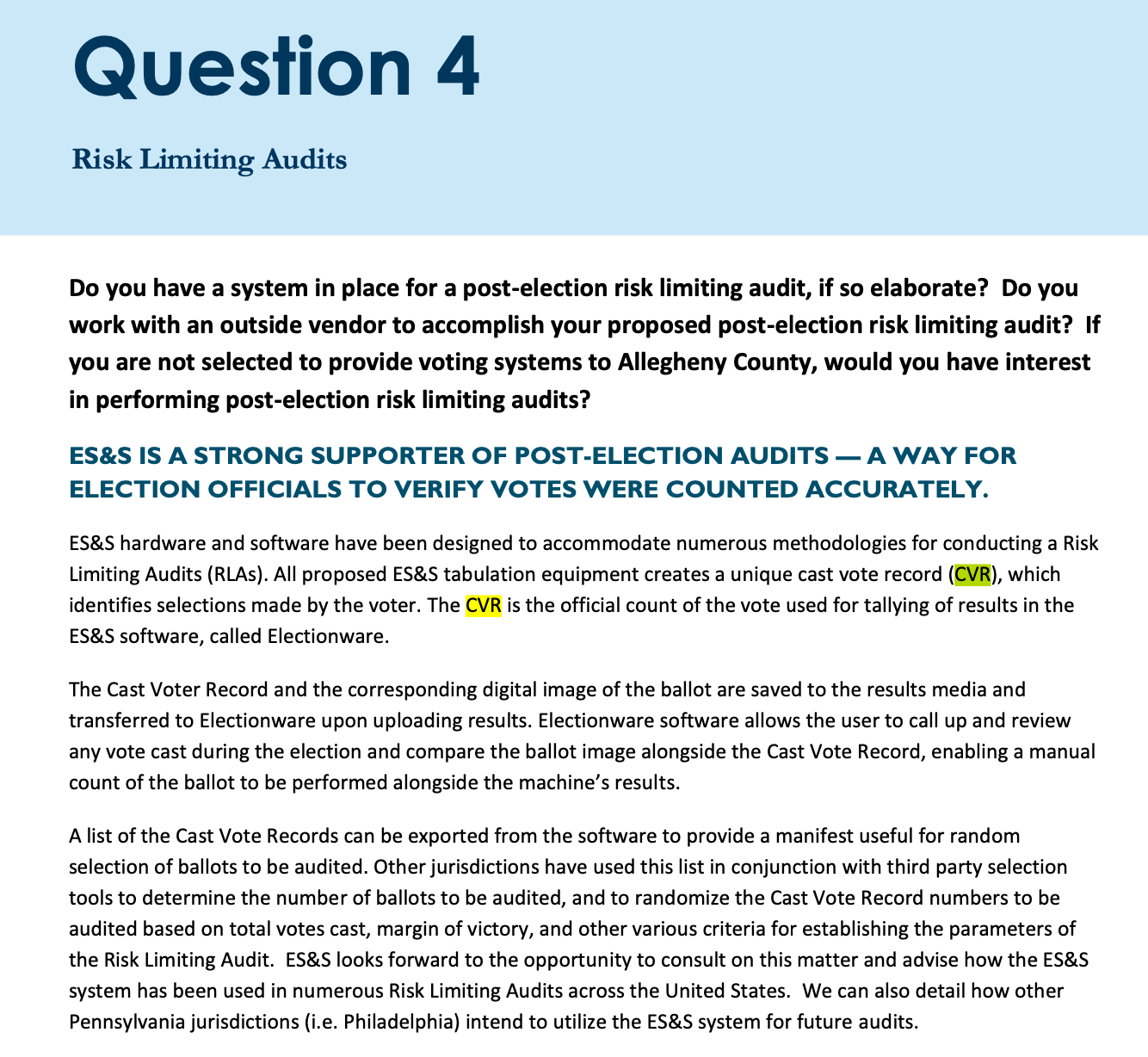
I even sent the Todd County election officials a PDF of how to extract the CVRs, which are page 42 of the ES&S Electionware Volume V: Results User’s Guide.

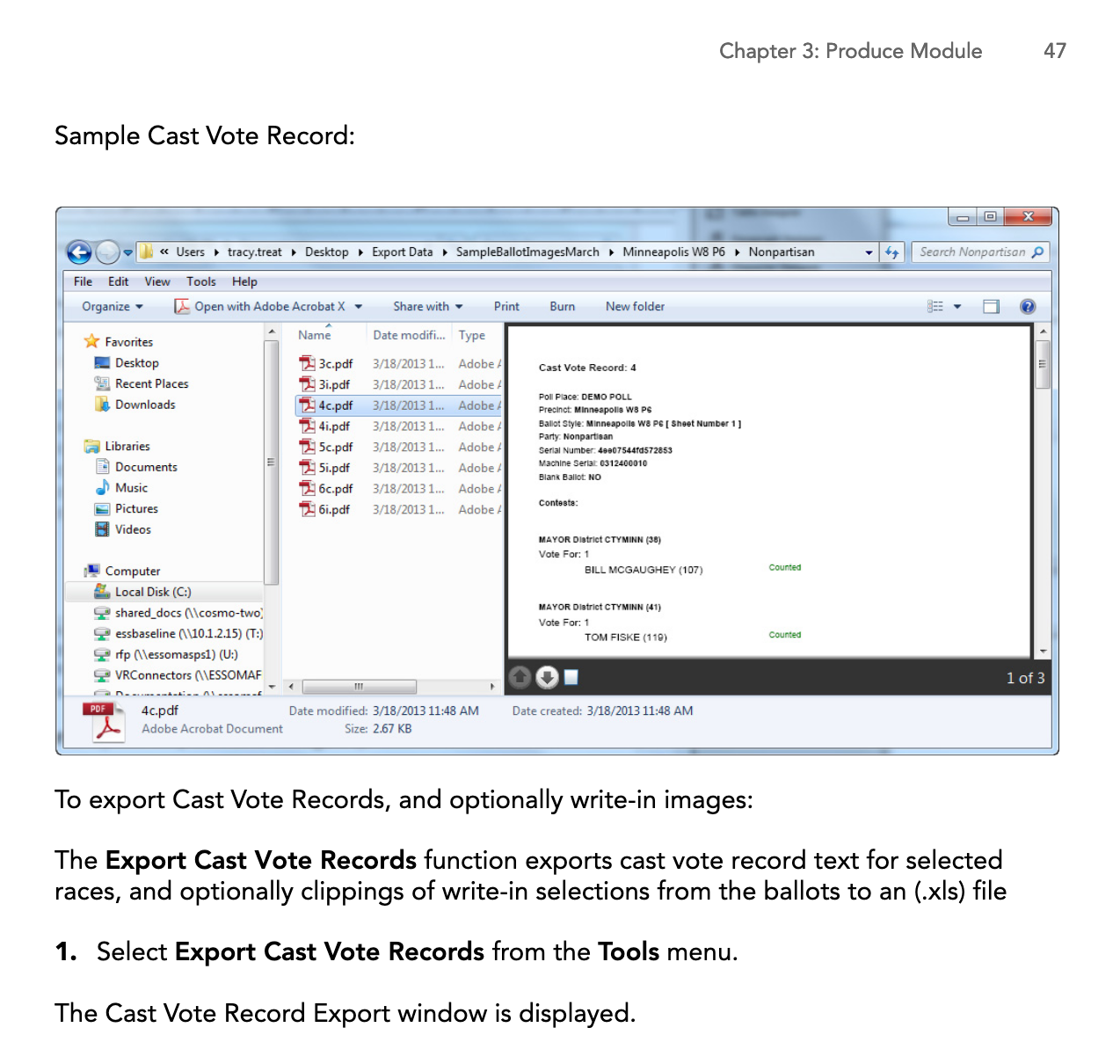
No response was given to the following email since I sent it on April 29, 2022.
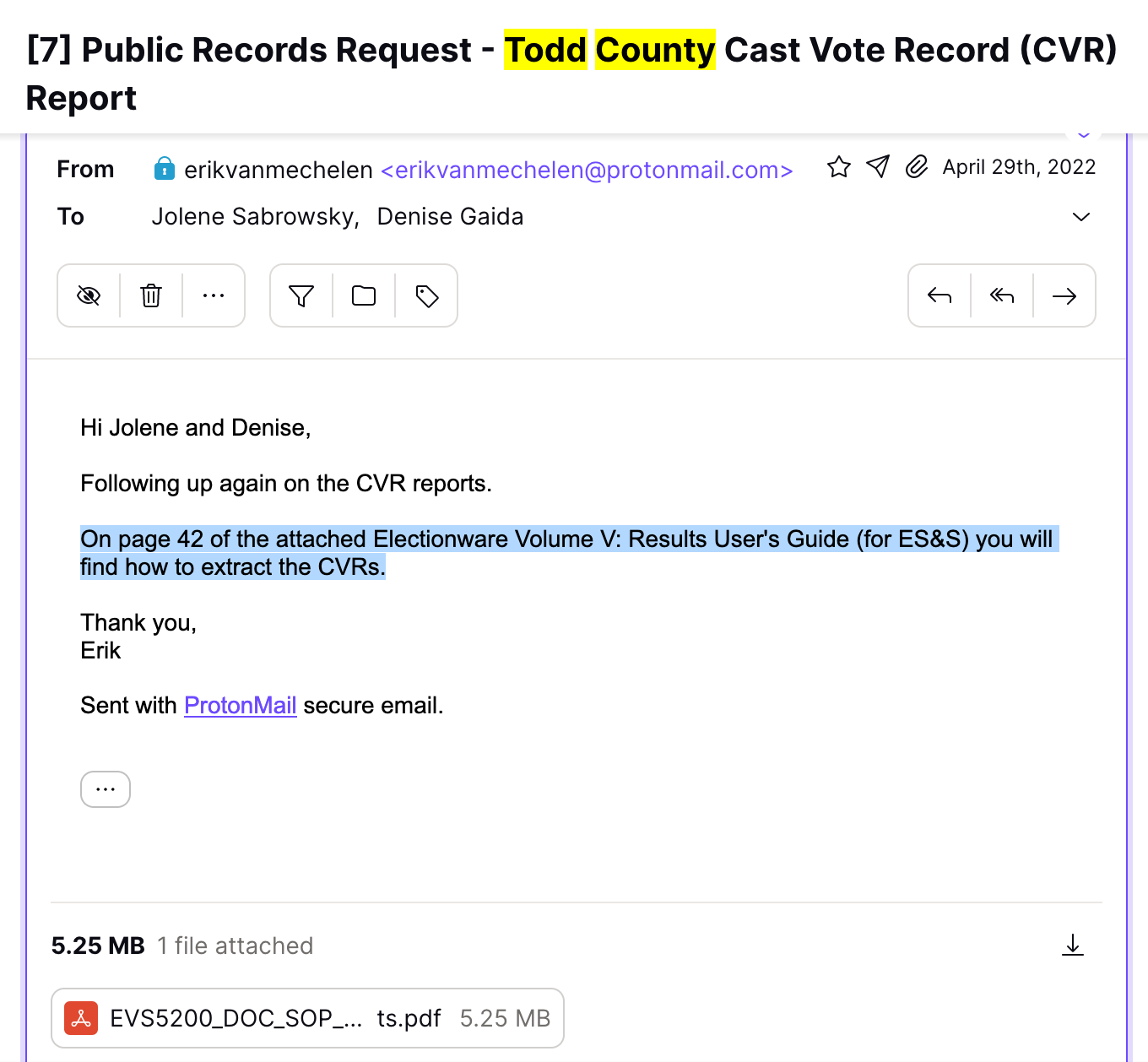
I have tried to sort out how CVRs might have been turned off (they cannot be, otherwise the machines cannot be used according to their certification), or if there is a language game being played, or if the CVRs might be stored somewhere else or called something else. Minnesota Statute 206.845 Subdivision 3. Cast Vote Records does clarify this for us by stipulating that the ballot image portion of the cast vote records are not to be made public in Minnesota. Why not?
From a document titled “Ballot Image Information on ES&S Systems issued November 1, 2018, it appears that the EVS Electionware user can specify which ballot images are to be saved on the DS200 and Central Scanners (DS450/DS850): 1) All images, 2) Write-In Images Only, 3) No images. Could these configurations at all be related to whether the CVRs are saved?
The technical details may not be clear, but the truth is states like Rhode Island and select counties in other states have received their CVRs which exposed the machine problem. Minnesota is using the same hardware and software from the same vendors as these other states, primarily DS200 tabulators from Election Systems & Software (ES&S) and Electionware, or Dominion’s or Hart’s equivalents.
But in Minnesota the people were told they didn’t exist, at least according to the responses Minnesotans have so far received from their county officials. Could the Office of the Secretary of State or the vendors have been guiding the counties on how to respond to these requests?
On June 24, 2022 I spoke on the phone with the county auditor in Chisago County to learn more about why they don’t have the CVRs. In this phone call, the county auditor shared that Hart had done an onsite software upgrade about a month prior (around May 2022) which archived the 2020 election. I’m not sure whether this is in violation of the 52 USC §20701 22-month election data retention records, but it sure seems like it.
On the phone call, the county auditor of Chisago County stated that she had already asked the vendor who said the CVRs could not be recovered. To her credit, the Chisago County Auditor stated that she had made a note to save that report in upcoming elections, to which I expressed gratitude. The 2022 cast vote record report was produced for Chisago from their Hart systems as a PDF readout. Ballot images were not provided.
This is not the first time software vendors have put election officials in a bad position through software upgrades, with the most high profile example being in Mesa County, Colorado, where the clerk, Tina Peters, has been politically imprisoned.
Going forward, it is also important to urge counties to make the cast vote records public immediately following elections, as is done by for example, Dodge County, Wisconsin, just to our eastern border.
Dominion and Hart also produced CVRs. In Hart’s case, it produces a CVR (basic to counting ballots and their vote opportunities): Out of Idaho a Technical Reference Manual “Ballot Scanning and Review Software” Terms: Cast Vote Record (pages 10, 11, 14, and 189); CVR (pages 10, 11, 14, 18, 163, 164, 214) and 131, 133, 135) …
Pushing Back Against Tyranny
On Day 2 of the Cyber Symposium I found a chair near the front, stage left. Not far away Dr. Frank and Mark Cook continued to explore and explain the server images provided by Tina Peters (highlighted in the [S]election Code documentary). I had noticed Captain Seth Keshel come in and wanted to speak with him. Not long before this Code Monkey’s lawyer had apparently suggested they not examine the server images since they may have been acquired illegally (I belive this to be untrue, as it is the duty of county clerks to preserve election materials and data). I learned from the person who gave me a ride from Minneapolis that a few of them in the back were looking at the same server images and feeding Dr. Frank and Mark Cook information. Dr. Frank’s calming intonation, “This is better than PCAPs” still holds true today.
When Seth finished speaking with Wendy Rogers and Sunny Borrelli, I introduced myself. He said to focus on the collar counties around the Twin Cities like Wright, Scott, etc. Seth’s point was that we would face too much opposition in counties like Hennepin, Ramsey, Dakota, or St. Louis. And given the progress teams have made in places like Wright and Dakota, and more recently in Anoka, his trend and political analysis was not wrong to highlight them. But as time passed it was also clear that breakthroughs might also be achieved in more rural, lower population counties, of which there are many across our 87-county state.
Months later, my friend Nathan and I had been thinking about where to focus in Minnesota. Nathan said, Why not Todd County? David Clements had been urging folks to find rural counties where county commissioners might be more willing to put election discussions on the agenda or even pass favorable resolutions. And, after all, Dr. Frank’s refrain is “Vote Amish,” a nod to elections without unneeded technology. Todd County is one of the Amish hotspots in Minnesota. So I sent Todd County a data request for their 2020 cast vote record (CVR) report on the same day I sent a request for one from Hennepin County.
I tell this story in wrapping up the chapter on the enemy’s coverup to illustrate a lesson encapsulated by Stargate SG-1’s Season 5, Episode 5 - Red Sky, wherein the SG-1 team causes the disruption of a sun near a planet protected by the Asgard. Unbeknownst to the locals, SG-1 seeks help from the ‘Grand Council’ Asgard. In the conclusion, it is unclear whether the solution attempted by the SG-1 team and the local population was successful, or if the Asgard had helped them out after all.
In other words, it’s important to try, to take actions, which is all that can be owned—the emotional attachment to any outcome need not be.
And wouldn’t you know it? Within moments of writing the above lines (Thursday, June 16, 2022) I stumbled upon a page in the ES&S DS200 Operator’s Manual, which explained that if the ballot images are turned off, then so are the cast vote records.
Now, this is critical.
First, for emphasis, understand that the scanners cannot interpret the ovals on the ballots (the voter decisions) directly from the paper ballot itself. The ballot image file must first be created digitally, and then the interpretation is done and saved within the tabulator itself.
If the ballot image functionality were indeed turned off, then the scanner is not doing much of anything at all. It certainly isn’t counting votes or tallying votes, and should not be used in an election.
If indeed it is discovered that ballot images were turned off in any tabulators in Minnesota during the 2020 election, it calls the entire election into question immediately based on the utilization of equipment in a manner not certified.
Such a decision would resolve much of the confusion I’d had up to this point regarding cast vote records (CVR) and the seeming lack of any in Minnesota from the 2020 election. But if this function HAD been turned off, then the entire election was a scam. On this line of thinking, with ballot images turned off, the results would have had to have been generated with an algorithm, assigning results to precincts that the Secretary of State’s websites then reported. (Then the work would begin to prepare ballots to match during the post-election reviews… as has been discussed, over 60%, or more than 800 ballots, were found to be missing in just ONE of Dakota County’s randomly chosen precincts.)
Page 57 of the ES&S Operator’s Manual explains how if the ballot images are turned off, so are the cast vote records. I was so excited to find this that I immediately posted the following on my Telegram channel.
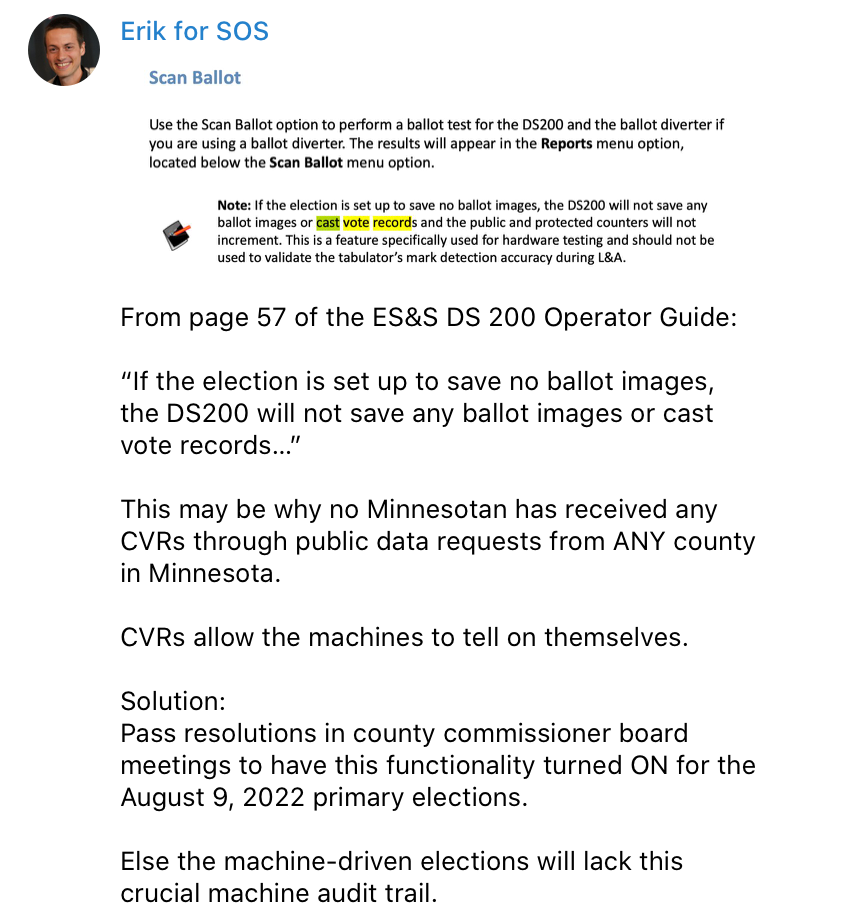
Note that even the manual says this feature should only be used for hardware testing, not for public accuracy tests, not during actual elections.
If the sole purpose of having the tabulators is turned off, then tax payers are paying for a machine that is useless and calls the integrity of election administration deeply into question.
Crow Wing County
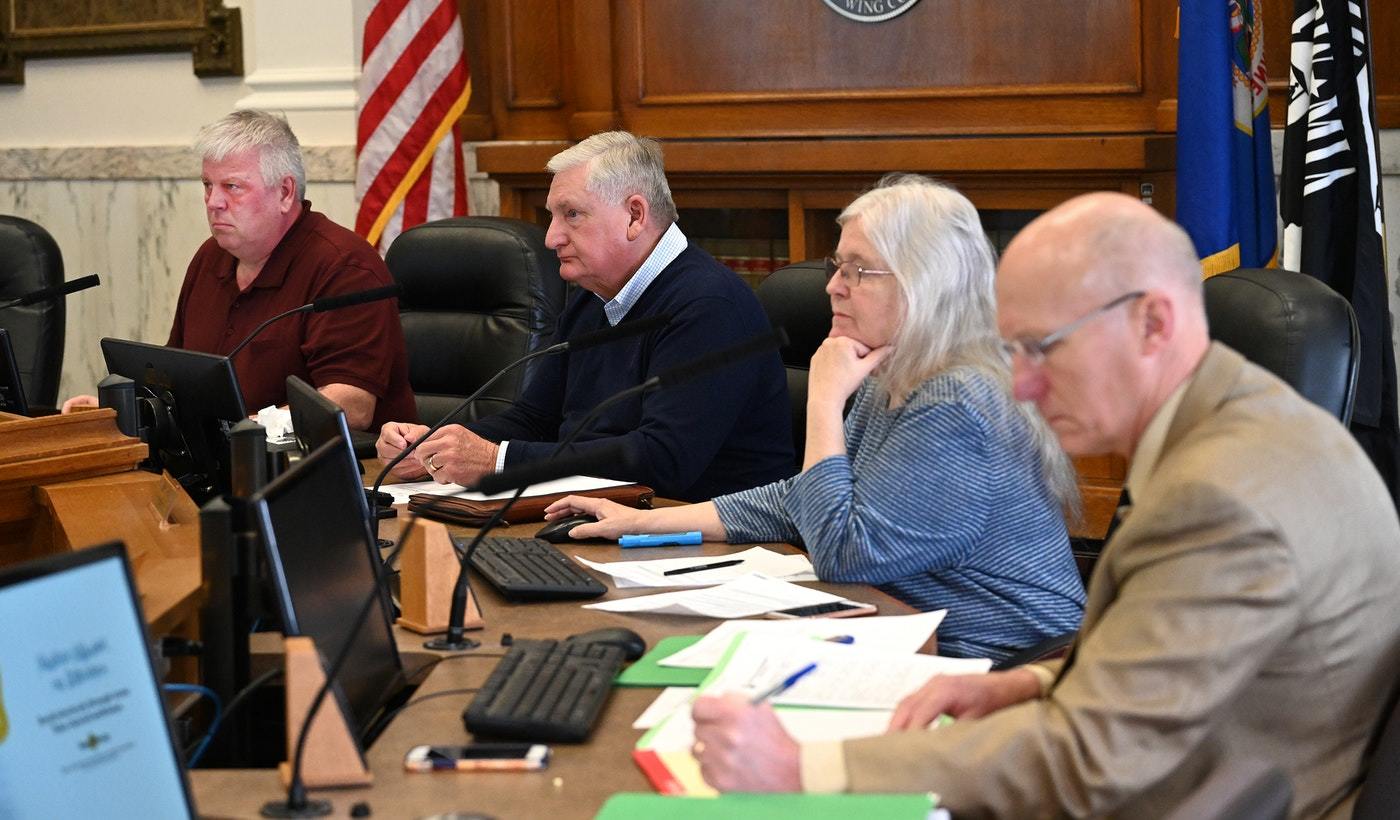
After multiple commissioner board meetings attended by dozens of Minnesotans who didn’t trust the results of the 2020 election, the commissioners were finally persuaded in late December to pass a resolution seeking an audit. Don Ryan, the County Attorney, interpreted Minnesota law and advised that the county could not unseal its own ballots, and so the request was made to Secretary of State Steve Simon, who declined to undertake a full forensic audit of all election material and data.
In their resolution, which passed 4-1, the commissioners stated that the board “continues to have faith in the 2020 election results as valid and reliable but it is equally troubling that there are citizens who still have a sincerely held belief that it was not”, suggesting they did not wholeheartedly agree with their constituents and were perhaps going ahead with the resolution as a matter of appeasement. In May 2022, at least one of the same commissioners was afraid to open an email with a link to 2000 Mules when candidate for house rep Doug Kern sent it to the Board.
All this said, Crow Wing was the only county to request such an audit from the secretary of state.
So, how did Secretary Simon respond?
“Our office will not engage in a vague and impossibly broad search for unspecified misconduct based on anyone’s gut feeling, hunch, or belief — no matter how sincerely held,” Simon said. “The 2020 general election, which took place almost 15 months ago, was fundamentally fair, accurate, honest, and secure across Minnesota.”
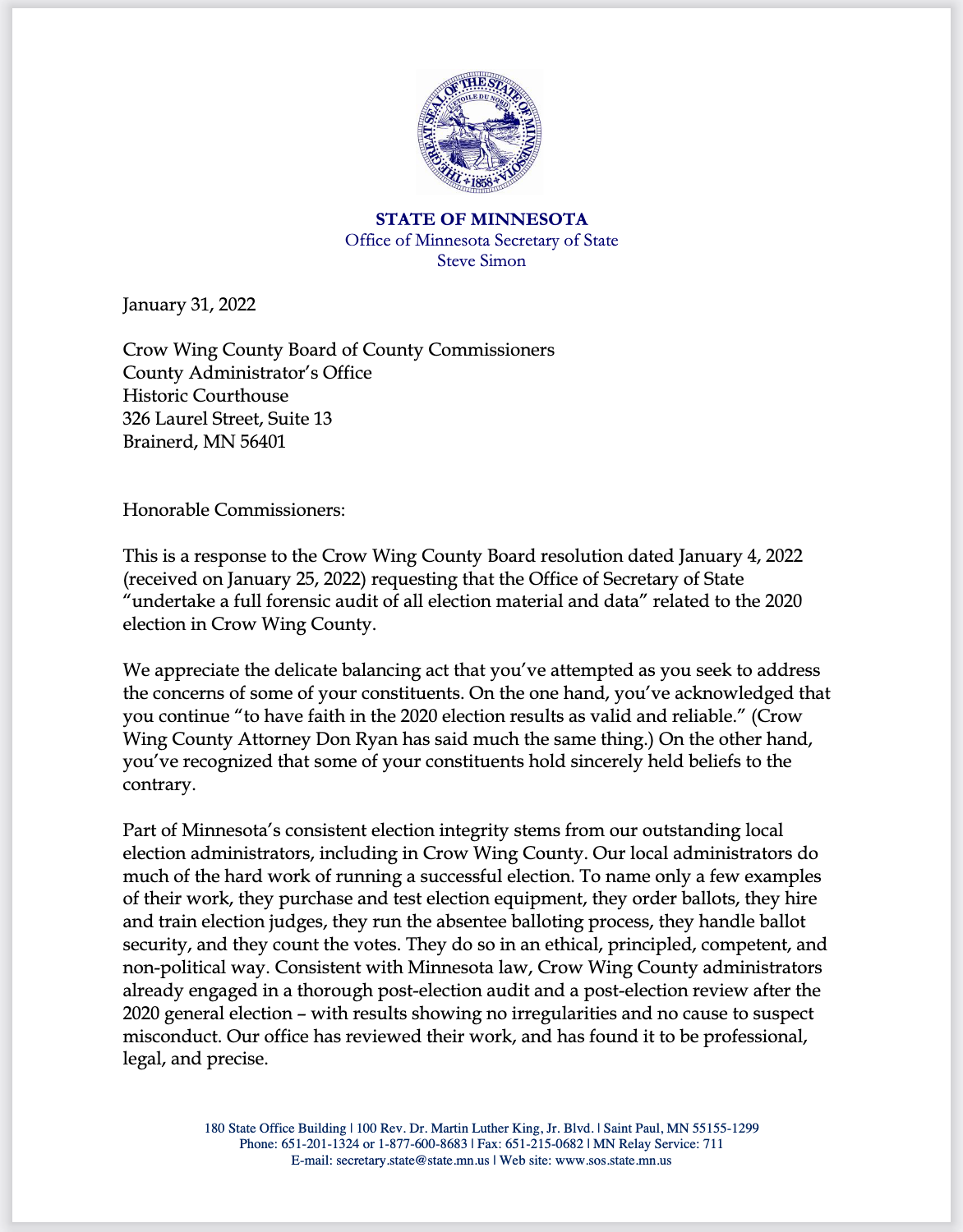

If the Secretary of State had complied with the commissioners’ request, election materials and machines may have been audited. This would have been a proper audit instead of a post-election review or a recount which simply audits the results.
Why should the machines and data be audited? Because, as was shown by Jeff Lensburg in the Antrim County, Michigan case, votes can easily be swapped which would not be identified in a canvass, postelection review, or risk-limiting audit (recount). I had also seen this for myself when Sean Smith, Mark Cook, and Draza Smith along with Patrick Colbeck created a mock election at the Cyber Symposium in 2021 where they demonstrated a similar concept.
However, if the machines and full chain of custody—of both materials and data— were to be audited, the vulnerabilities described in earlier chapters could be exposed.
Secretary of State Steve Simon made this decision in January, 2022, missing an opportunity to demonstrate transparency in Minnesota’s election process and systems.
Since then, an even faster method to verify whether the paper ballots match the machine count (as scanned through the tabulators) has been identified.
Dakota County
When the people with Rick Weible’s help found indications that the results Dakota County announced for Kim Bauer’s 2021 School Board race in ISD 196 may not have been accurate, they began requesting information from the county to try to reconcile the mismatching information.
To this day, the data in the statewide voter registration system and the reported results from the county and the reported results from the school district have not been reconciled.
In May of 2022 I sat in a closed door meeting where the county election officials tried to explain what they thought happened but were unable to satisfyingly do so. This meeting in particular gave me insight into the depth of the problem we face, since it is my opinion that some election officials simply do not understand the technical details of the software and hardware (it is complicated), whereas others may very well understand but be held back from helping us by some as yet to be discovered reason.
In that particular meeting also was the election official’s boss, who tried to steer the meeting. He previously had said I could not record the county commissioner meetings, when of course I could (and did) seeing as they are open meetings, an indication that he didn’t know the laws governing county commissioner meetings or an intent to dissaude me.
On June 7, 2022, Rick Weible spoke to Dakota County about their software, recommending they return to hand counting and hand tallying.
That day, the county commissioners voted favorably on not approving drop box voting and returning to party balance on absentee ballot boards while Andy Lokken described Minnesota’s unique situation, which is “so unique that it creates delays in getting software here.”
There is more work to do since Dakota County (and every county in Minnesota) still uses the modern electronic voting systems which are highly vulnerable to subversion.
Wright County
The teams in Wright County were successful in convincing the county commissioners there to hold a workshop dedicated to election integrity with Rick Weible as the speaker, on May 17, 2022.
At the close of this meeting, it was decided that a joint task force would be put in place involving county commissioners, election officials, and members of the public.
On August 1, 2022, I attended the counties public accuracy test (PAT) ahead of the August 9 primary election. One of the employees took a photo of me and a few others while we sat and waited for the election manager to be ready to take questions. Eventually I got to ask questions and had almost a half hour conversation with several employees, including their tech team, about the value of cast vote records. One of the IT people, who claimed to have worked on a nuclear sub, said that because of the air gap, their systems were secure.
Morrison County
After Jeremy Pekula went on the radio asking whether the county commissioners were going to take action, he received another invitation to meet.
In mid May 2022, after speaking on the radio alongside Jeremy in the morning, we met that afternoon with the County Administrator, two county commissioners, the head election official, and the deputy election official.
We shared some of the information already discussed in this book.
We asked whether they would like to have an item on the agenda in a forthcoming county commmissioners meeting.
So far they have not agreed to do so.
Stearns County
Growing up, even while living overseas in Gabon, Indonesia, or China, my family would return to Minnesota every year, usually over the summer, to visit our family. Often we would stay at my aunt and uncle’s home in St. Cloud (and sometimes in Stevens County, where my mother grew up).
Sandy Klocker and I first met outside the building at the Cyber Symposium held in Sioux Falls, South Dakota, in August 2021.
She was holding a sign with Biden wearing clown-face and made light of the fact that Biden was elected via election fraud.
Later Sandy would invite me to join her in speaking with the Stearns County Auditor and the deputy. In that meeting, I admired Sandy’s pointed questions. For instance, we learned that only a small percentage of the 80+ tabulators used in the upcoming primary elections were actually tested. (It’s not a requirement for every tabulator to be tested before the public.) On this point, furthermore, the standards for maintenance once a particular machine has been certified are quite minimal. (Here’s a great FOIA opportunity to learn how well, or not, the equipment in your area is maintained.)
Sandy went to many commissioner meetings, alongside others, and was a leading voice in putting her commissioners to task for their inaction. In an event she held mid-August 2022 I commended her for all the detailed investigation she’d done into her local government.
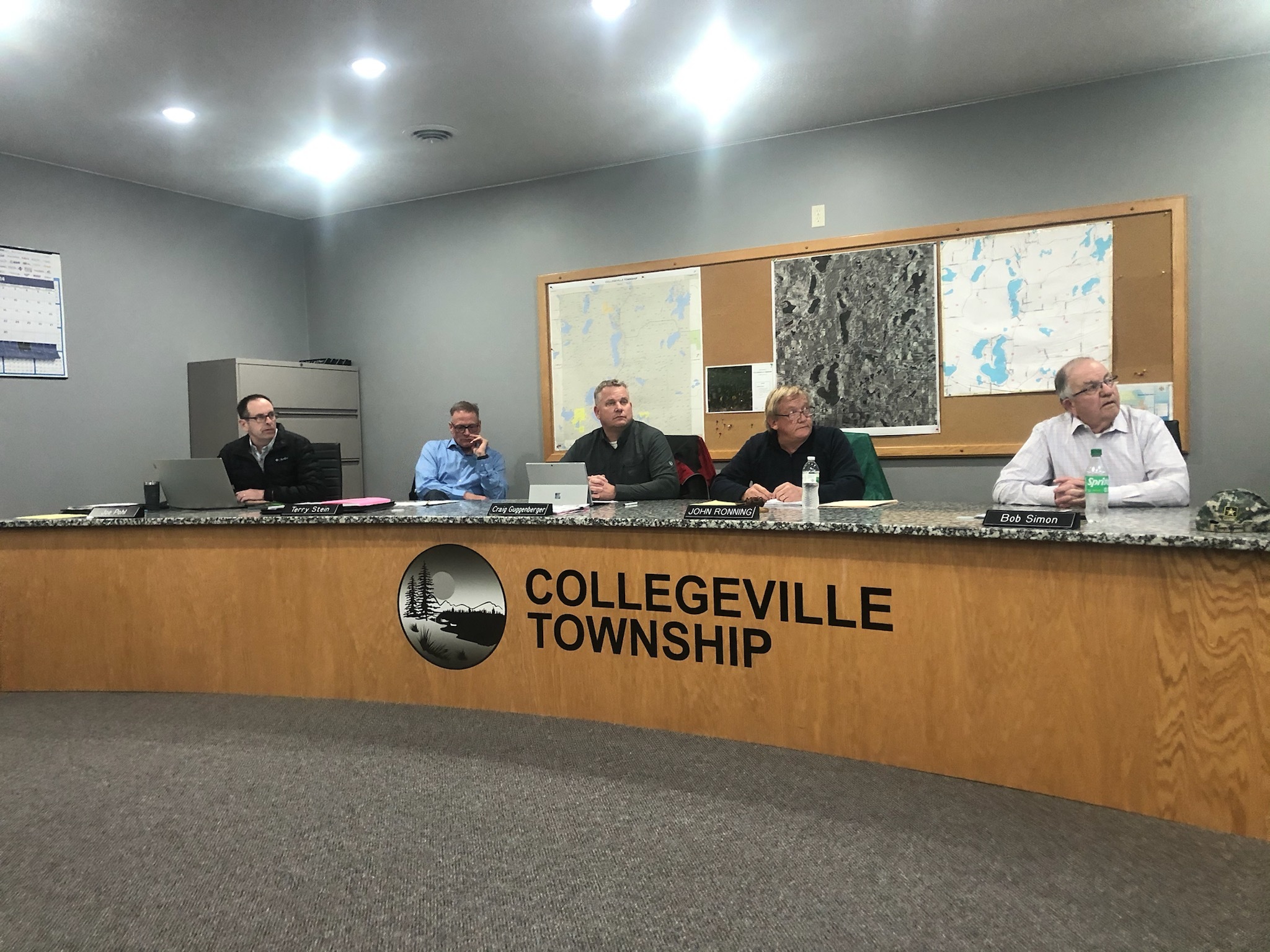
Stearns County seems to be going the wrong direction with regard to integrity, where in Collegevill in 2024 they seemed poised to move away from in-person in-precinct voting, choosing to limit voters to the mail-in only option. After making that decision, Sandy spread the word, and 150 people showed up in the pouring rain… her township reversed the decision.

Advocates like Sandy have raised awareness and continue to hold strong even when the going gets tough. The mail-in voting reversal above shows that building relationships, raising awareness, and getting decision-makers to the point of decision is all possible with diligent effort and persistent focus.
Sherburne County
Teri Dickinson was very effective in organizing people to attend county commissioner meetings in Sherburne County starting in early 2022 if not well before. She even once gave up her precious speaking slot to give me three minutes to anchor a slate of speakers including Kari Watkins, on April 19, 2022, my first time speaking in a county commissioner setting. I stressed the opportunity for the commissioners to take in all the information and find it in themselves to make history by removing the machines. Later I learned that on that day, 246 years prior, was the Battle of Lexington and Concord, if the history can be relied upon… History indeed!
The Sherburne county commissioners refused to (so far) have a public hearing or agenda item during the county commissioner board meeting despite multiple weeks of open forum comments like Rick Weible’s here sharing critical vulnerabilities with Sherburne’s modern electronic voting equipment. This inability to listen or disinterest in the facts led Kari Watkins to step up and run for county commissioner herself. She later would become a town board supervisor.
Sherburne would later take center stage in two cases.
In July, the #2 of the MN Office of the Secretary of State, David Maeda, was given a 20-minute agenda item to discuss elections. The County Auditor, who is soon retiring (as of May 2024) also spoke. Unusually, there was media there, photo and video. Maeda said he disagreed with Rick Weible that Sherburne had put a new software system in. That particular issue became the focus of a Supreme Court Petition, case no. A22-1081 which Bill Kiefer and I signed onto as petitioners. It was dismissed on laches (therefore not on the merits).
Then, in August, a first amendment violation was committed against Teri Dickenson, witness by many and caught on video. She was simply stating that the commissioners had been unhelpful, but then the chair signaled to the administrator who cut her mic and asked the bailiff to escort her out. That happened on August 2. They commissioner team would apologize formally 14 days later, perhaps to mitigate potential action against them for the violation.
Because of roadblocks at the county level, the action teams pivoted to meetings with the townships.
A Haven Township meeting on June 20, 2022 started out with the usual disappointments and interference. Instead of Rick Weible’s presentation starting the 7 p.m. meeting, as had been promised, he and those attending who had travelled to attend were made to wait until almost 9 p.m. once other items at the supervisor’s meeting had been completed. Rick was then offered 10 minutes. After negotiation, he was given around 40 minutes, with the supervisor’s interjecting with questions.
The meeting was then adjourned after the Chair said her eyes were glazing over, but three of the supervisor’s stayed around to hear more of Rick’s presentation, which went about another hour.
By the end, one of the supervisors said to me walking out of the building, “If we don’t get to hand count here, I’m not going to certify the election,” refering to the primary on August 9.
This was music to my ears.
Anoka County
I’ll not soon forget the first time commissioners actually listened to me.
A few minutes before, I’d parked near the entrance to the Anoka County Government Center on a chill day in Fall 2022. The primaries had come and gone and there was much to do.
Anoka is Minnesota’s fourth largest county by population. Its government center is located not far from where the Rum and Mississippi river meet.
After parking, I nodded to some workers cleaning up the sidewalk outside, snapped a photo for the memory book, and went inside. As I waited for the elevator across from the Elections office, I wondered how many of the employees understood the magnitude of the problem. Elections could quite easily be rigged, and they could be rigged without the staff knowing about it. Like a flawless surgery, you go under, wake up, and carry on living your life without really knowing what the surgeon did when he opened you up.
Reaching the seventh floor, Derek spotted me right away and came to shake my hand and bring me into the commissioner board room. There were just four of us: Derek, Brenda, Lisa, and myself. We walked right up to the raised desks where most of the commissioners were preparing for their upcoming meeting.
Derek said hello and introduced me.
I used the time card analogy to make my point: If there was a disagreement on the pay stub and the time card system, wouldn’t the employee and management want to look into it?
There we would be a log of activity in the time card system to double check.
Same goes for our electronic election equipment, especially the tabulators. They have audit logs, as well as cast vote records (CVR), which are produced and created automatically in these electronic scanners since 2005, when the Election Assistance Commission’s (EAC) Voluntary Voting Systems Guidelines (VVSG) 1.0 standards were put in place. Cast Vote Records are also defined by the National Institute of Science and Technology (NIST), which is part of the federal U.S. Department of Commerce, which determines standards for weights and measures. This is why cast vote records need not be defined in election codes within each state.
In simple terms, though, cast vote records or a CVR report can refer to multiple components of the records:
- For ES&S (nation’s and Minnesota’s top vendor) equipment, there is the data stored on the tabulator, which gets moved to the Electionware computer by an encrypted thumb drive
- There is a report that the Electionware computer can give in various formats
- There are also the ballot images—these are a scan of the ballot producing a digital copy on which the ovals are interpreted for candidate vote tallying
Now, interestingly, after some considerable delays from county auditors, county administrators, and others responding to valid public records or public data requests in nearly if not all counties statewide, none were shared for 2020, except from one county, Fillmore.
(There is email proof—waiting to validate this—from the secretary of state that confirms what was suspected once responses from the counties seemed eerily similar.)
With the cast vote record file, the ballot images, and the paper ballots, those three pieces of information let anyone see that elections are secure without any detriment to the security of those systems. This was ostensibly the tradeoff Americans made when ushering in the electronic voting systems in the early 2,000s. (There is whistleblower testimony from the warehouses that produced the hanging chads for Palm Beach County, Florida, that even that spectacle was planned, as discussed in Chapter 1.)
As awareness about cast vote records grew, articles appeared, such as in MinnPost, contributed to by Max Hailperin, who is close with Secretary Simon, indicating that cast vote records are not very useful. This was a pivot once Mike Lindell’s nationwide call for these records encouraged many to not merely ask for them but properly request them. In Minnesota Statutes, Chapter 13 details data practices. It could no longer be denied that they existed, as had occurred for me the first time receiving such a notice from the Todd County Attorney in early Spring 2022.
Curiously, in the 93rd Legislature, in May 2023, two things happened that were far from the only notable amendments to what is now about 536 pages of election law (much longer than all the laws in the original Minnesota law book from 1849).
- The ballot image portion of the cast vote records was made non-public data under Chapter 13
- Electronic tabulators were mandated for any precincts that had previously used them (which was nearly all, if not all of the approximately 4,000 precincts statewide)
Now, no citizen of Minnesota had come close to seeing a ballot image as a result of the coordination hinted at above, so it was interesting to see #1.
#2 was curious because, regardless of whether one trusted the security, transparency, accuracy, verifiability, and accessibility of electronic counting and tallying in the manner described above, shouldn’t towns, cities, and counties still have the option of choosing how to run their own elections? Most people just want the number of votes in to equal what comes out and to be able to see that for themselves, with their own eyes. Some towns, like Baldwin and Haven in Sherburne, had backed down from potential lawfare after receiving communications from Sherburne County Auditor and Attorney about the towns’ resolutions to hand count their 2022 midterm elections in parallel with the machine count.
This discussion so far hasn’t touched on absentee, early, or mail-in ballots. This method of voting category comprised 60% of all certified votes for Minnesota’s 2020 presidential race. It just so happened that the man currently sitting in the secretary’s seat for Minnesota had helped to make elections far less secure in 2020 by participating in the scheme whereby he was sued by the NAACP and LaRose leading to the consent decrees which waived the witness signature requirements for absentee mail-in ballots and extended the deadline for receiving them.
The floodgates had been opened. All told, almost 60 percent of Minnesota’s ballots being absentee or mail-in, which helped “Biden” receive 1,717,077 votes, according to the certified totals, improving upon Clinton by 349,252 votes, a record, despite Trump picking up votes. Secretary Simon, who was the Vice Chair of the Democratic Association of Secretaries of State, and who would in October appear on the cover of Time Magazine, declared the 80 percent voter turnout a resounding success. Since, he’d declined to audit Crow Wing County after the people showed up in five or six consecutive county commissioner meetings demanding one be done to the point that the commissioners passed a resolution to that effect, if the Secretary of State would help them… In early January of 2022, surprising no one, he said that he would not.
That day in Anoka, I wish I had had time to properly share what I’d learned with the commissioners. Previous to that, I’d spoken at Sherburne County and several other counties, some north of the metro, some south. Like almost everyone else, whenever I spoke it was limited to about 3 minutes or less. There was one Sherburne County commissioner who said it was good practice to limit ones thoughts to two minutes. I don’t disagree with her even though I disagreed with her decision to call the bailiff to remove my friend from the podium, violating her 1st amendment rights, on August 2, 2022. (I have more videos from that day.)
After speaking with the commissioners, Derek said we had their attention. I felt it too. They had actually listened. Whether they would do anything with the information remained to be seen.
The team in Anoka County grew.
They meet weekly, on Mondays. Emails go out, which I’m cc’d on, before and after the meeting, with agenda topics, and follow-ups. They work in small groups between meetings, on the six main topics they are focusing on, including hand counts.
One of their team, Lisa, invited me to a town board meeting in Linwood in 2022 where I learned the clerk knew about cast vote records and was in my opinion in favor of hand counts.
The group is a steady 15-20 people now, as of 2025, including from nearby counties.
What groups do you know about that meet every week, face to face, spending hours before and after these meetings, and between meetings, preparing and following up on to-dos, open questions, and activities to educate the public, their local political parties, and elected officials?
I don’t know many with such commitment.
One day, the commissioners decided to put in a public comment period, at the end of the commissioner board meeting. Anyone could speak on any topic, but it was a good opportunity to help them learn and get on the public record about election integrity. I spoke two or three times more alongside the team before the commissioners and we started putting recordings of these speeches online because the county turned off the live recording during this public comment period, strangely.
The team gave about 80 speeches to the Anoka County commissioner board before shifting focus to cities.
Not without its flaws, I venture this group is far more organized than some government groups, but that is beside the point.
What is relevant is how much knowledge they’ve accrued about the election and voting process, systems, and codes (laws). They know more than most elected officials, including those who vote on election code amendments in St. Paul. This is just a fact that could be proven by putting any randomly chosen team member side by side with any randomly chosen legislator.
What is also relevant is this team’s experience in presenting such information concisely to the county board and now in slightly longer formats (30-60 minutes) on invitation to norther cities in Anoka County.
The fact that they are being invited speaks volumes about their credibility, the value they bring, and the public and local government-level interest. At the Oak Grove presentation in late January 2024, attendees were provided thumb drives with the presentation materials and, importantly, templates to about 11 resolutions that they could pass locally to improve election integrity.
Relevant too are the two election integrity resolutions which have been passed in multiple counties at the precinct caucus and basic political organizing unit (BPOU) level, including in the Minneapolis BPOU where the party still advocates openly for misplaced ideas like early voting, which actually help those with access to those systems cheat, if they want to.
Finally, in Anoka, what is further relevant is I predict the southern cities will one day soon take interest as well.
On April 29, 2024, one of their projects bore fruit, when the Oak Grove City Council voted 5-0 in favor of expanding their post-election reviews—a hand count audit—to all four of their city’s precincts for all races with more than one candidate. I imagine this will ignite the spirit of many more city councils in Anoka County and around the state.
Oak Grove and Ramsey later canceled their electronic poll pad agreements as well. In Oak Grove’s case, it was prior to the 2024 general election, prompting a letter which included input from the county auditor, county attorney (threatening felonies if paper poll books were used instead of electronic) and input from the Minnesota Secretary of State, Steve Simon, all trying to argue that cities HAD to use electronic poll pads, even though the Minnesota Statutes say the cities can decide for themselves.
In 2025, two commissioners voted AGAINST buying new KNOWiNK poll pads, what some view as the Trojan horse of Minnesota elections.
Other Counties
I’ve had great interactions with people from many more counties beyond those just described, such as Carver, Ramsey, Hennepin, Scott, Cass, Isanti, Chisago, Washington, Lincoln, Lyon, Faribault, Olmsted, and Fillmore (where the only CVR from 2020 was produced, although without ballot images), Otter Tail, Benton, Todd, Mille Lacs, Clay, Saint Louis, and Lake, and almost certainly others that I have failed to list here. I believe there are people from every county engaged.
Some of those stories may make it into the next book, which is currently in progress, which takes a more narrative approach than this one.
Each conversation keeps me up to speed on the goings-on and helps me learn or improve how I speak or encourage those who ask for help.
Never think that your work is going unnoticed. And even if it does seem to be, remember that small actions ripple outward to affect those around you…
Even with the defense phase (cover up and destruction of evidence) of the election coup falling apart, so far no county commissions (in Minnesota) have decided to return to hand counting paper ballots as many of their constituents desire—instead, counties plan to run elections on very similar if not the same software which managed the 2020 election. This would be unwise if fair and transparent elections are desired.
I fully support the many people continuing to go to their county commissioner board meetings to inform them of available fixes and simple alternatives to voter registration, tabulation, reporting, and verification. Examples exist.
Chapter Seven - What We Can Do
“It takes very little talent or creativity to complain about problems. After all, the people directly impacted by a problem, and eventually those indirectly impacted by the problem, feel the weight and consequences stemming from it. When I speak in front of an audience, I need not complain at length about the violations of liberty underway in America, because the people know the personal toll exacted by those who corrupt the foundation of self-government. The audiences come to hear solutions and to commit to action.”
—Captain Seth Keshel, Veteran Lesson VII: Leaders Create Solutions (Ten Lessons for Every Day)
“Never tell people how to do things. Tell them what to do and they will surprise you with their ingenuity.”
—General George Patton
Let’s briefly cover what’s been done, what’s being done, and what still yet can be done right here in Minnesota.
What Recent Laws were Added or Amended?
No-excuse mail-in began in 2014 leading to large increase in absentee/mail-in ballots and votes.
- A 1987 law made it possible for precincts to switch to mail-in only
- In 2016 the thresholds from 1987 were lowered; outside metro precincts with fewer than 1,000 registered voters, metro areas with fewer than 400, could opt for mail-in only
- There are currently 1,000+ precincts (out of 4,000 statewide) whose voters may only vote by mail (mail ballots can be hand-delivered, but no in-precinct election day voting allowed)
Minnesota’s 93rd Legislature (2023):
- electronic tabulators mandatory if previously used at one or more precincts, for those precincts
- the ballot images part of cast vote records non-public records
- illegal immigrants can get a driver’s license
- 16-yr-olds are now in voter roll and ID pool
As seen in MS 206.58 AUTHORIZATION FOR USE. Subd. 1 Municipalities., ‘‘Once a municipality has adopted the use of an electronic voting system in one or more precincts, the municipality must continue to use an electronic voting system for state elections in those precincts.’’.
This statute does not address the ex post facto nature of the law: When counties chose to use electronic equipment they would not have known this law was going to be passed later, removing their choice. Additionally, it is unclear whether redrawing precinct lines would refresh the option for the county.
For ballot images MS 206.845 BALLOT RECORDING AND COUNTING SECURITY. Subd. 3 Cast vote records. shows, after the ordered list of 5 items, an additional line of text: ‘‘Data stored as images are protected nonpublic data under section 13.02. It is unclear why a sixth item with this information was not put into the numbered list, but rather listed below. Perhaps it was a late addition during drafting?
The entire subdivision on cast vote records was added in 2023 after many Minnesota county auditors, county attorneys, and even the MN Secretary of State suggested they either were turned off, did not exist, or were not accessible. Note: If cast vote records were to be somehow turned off, this action would decertify that tabulator according to the Election Assistance Commission (EAC).
For all 2023 election laws in a 536-page pdf, click here.
Additional amendments are in the works for 2024.
For instance, added to MS 204C.20 BALLOTS; NUMBER TO BE COUNTED. will be a subdivision which reads: Subd. 5. Precincts with ballot tabulators. In precincts using ballot tabulators, once the final count of ballots agrees with the number of ballots to be counted, election judges must immediately prepare the summary statement in accordance with section 204C.24 and seal the ballots in accordance with section 204C.25 for return to the county auditor. The effective date will be June 1, 2024. Read more about HF4772.
This new subdivision would seem to be aimed at preventing a parallel hand count on election day after the ballots have gone through the electronic tabulator.
What Can Towns, Cities, and Counties Do?
For an updated list, visit Project Minnesota - (https://projectminnesota.com/local)(https://projectminnesota.com/local)
Even with the Legislature and MNSOS seeming to have considerable influence, counties and municipalities (cities/towns) can do quite a bit… Consider:
- Using paper poll books (as of 2024, still have option)
- Hand counting ballots (when 2023 law was passed, it was an ex post facto law, meaning when counties chose to in past use electronic voting equipment/tabulators, they could NOT have known they would later be mandated)
- Administer and process OWN absentee/mail-in ballots instead of outsourcing to county
Further options, once completed the above:
- If have mail-in only precincts, reversing prior decision and return to in-person voting in precinct - View Sample Resolution
- Expanding the postelection review to include as many precincts as possible and as many races on the ballot as possible
- Passing a resolution to ensure that no city employees are used for absentee ballot boards, but instead only party-balanced election judges
In 2024, the 94th Legislature (2024) introduced a new subdivision in MS 204C.20 BALLOTS; NUMBER TO BE COUNTED. which seems to hinder this idea, even though hand counting is definitely allowed and prescribed in certain conditions within Minnesota law, such as for recounts and post-election reviews. So, why limit the ‘check and balance’ that trained election judges could do on election night in their precincts to verify a race or two?
The above menu is a starting point. Pursuing even just the first 3, sometimes referred to as The Oak Grove Way, would go a long way in your town, city, or county, especially if this approach is taken at scale across the state. The powers that be simply do not have enough resources to counter such an approach, which is why they resort to trying to control language, narrative, process, personnel, and legislative levers.
If pursuing any of the above and facing resistance, ask oneself: Why should anyone object if the goal is a secure, transparent, verifiable, and accessible election and these approaches are within the currently written election codes?
If the laws change in response to your efforts, then so be it, as it will at minimum help to alert your neighbors to the depth and scale of the issue of reclaiming control of our local government.
What is the Simplest Legislative Change at the State Level?
An amendment to the following is provided on Project Minnesota - https://projectminnesota.com/beautiful
To make elections trustworthy and verifiable to all voters at minimum cost, consider:
Cities, towns, and counties will decide how to conduct their elections, so long as:
- On election day, voters present a government ID to receive a ballot
- All voting occurs face to face, in person, in precinct, on paper ballots
- Ballots and votes are counted in the precinct by humans and reported first at the precinct level
With such an approach, it can be seen that there is:
- No need for voter lists, rolls, or databases centralized at the state level, as currently exists within the Statewide Voter Registration System (SVRS)
- No need for absentee, early, or mail-in voting, which aligns with many countries and removes chain of custody problems
- No need for electronic equipment, computers, or networks of any kind
Instead, the will of the people, through decision-making at the city, town, and county level, determines how best to carry out their elections, so long as it is in keeping with the principles of integrity, security, transparency, verifiability, acessibility, and accuracy.
Instead of 536 pages of laws, why not try the above?
To be solution-oriented, a 3-page bill which included much of the above was presented to every Minnesota senator and every member of the house of representatives in 2024, all 201 of them. The collective interest was zero as measured by email responses. In 2023, one well respected (for the moment) senator said he didn’t think an election bill which included hand counting would get through committee, but also did not offer to try, even if I authored the bill.
Local Action
The rest of the chapter shares a few action items to make a commitment to.
Remember, it is possible to have actual elections that are not controlled by computer software or easily exploited by other means like mass mail-in ballots without chain of custody. We know this because we did it in the not-distant past! (As seen in Chapter 1.)
The simplest way might be to return to hand counting paper ballots in small, manageable precincts. Local control and oversight. That is easy to understand, and implementable right now. There is no reason for county commissioners to wait for further data to come in.
Although I prefer the simplicity and the community involvement (imagine neighbors getting together on election day to count the votes together), but I recognize that hand counting paper is not the only way.
Rick Weible and three more authors from three other states authored a paper on Gold Standard Elections, which are secure, transparent, verifiable, and accessible. The paper looks at each stage and layer of the election process from lens of each of those four dimensions.
It is state legislatures around the country that will decide how they want to make elections fair again, and possibly to make every voter’s vote count for the first time in decades.
It’s possible. It’s happening.
While we wait for the legislators to get their act together, get started in your local town, city, and county.
Small Counties with Great Potential
22 out of 87 Minnesota counties had fewer than 5,700 votes in 2020 and could perhaps more swiftly move to hand tallying, which is already acceptable by law (it is the disaster backup plan and counties can redraw precincts to avoid using the tabulators).
These counties could be places to find county commissioners more interested in putting an election integrity item on the agenda during county commissioner board meetings, or even making a courageous decision to pass resolutions to remove electronic voting equipment as seen in Nye County, Nevada and Otero County, New Mexico.
| County | Votes |
|---|---|
| Big Stone | 2916 |
| Clearwater | 4632 |
| Cook | 3699 |
| Grant | 3569 |
| Jackson | 5693 |
| Kittson | 2552 |
| Lac Qui Parle | 3974 |
| Lake of the Woods | 2375 |
| Lincoln | 3058 |
| Mahnomen | 2254 |
| Marshall | 5016 |
| Murray | 4812 |
| Norman | 3357 |
| Pipestone | 4859 |
| Red Lake | 2145 |
| Rock | 5139 |
| Stevens | 4966 |
| Swift | 5100 |
| Traverse | 1833 |
| Watonwan | 5090 |
| Wilkin | 3354 |
| Yellow Medicine | 5422 |
Skeptics might rightly point out that having fair and transparent elections in such small counties wouldn’t change the outcomes of larger statewide elections. But we have to start somewhere to inspire change and to say No to tyranny.
Meanwhile, at least you who may live in a smaller area (by population) can feel better about the school board member, commissioner, or representative you elect given the extra measures taken to secure those elections.
Objections to Hand Counting
Time and money.
The good news is that hand counting is cheaper, more reliable, and saves a lot of money in the short and long run.
What is often left out of these discussions are three simple facts:
- Many will volunteer their time to be trained on hand counting and then help to hand count on election day - this is proven by the countless hours spent by hundreds of thousands (if not millions) nationwide who have researched the facts, learned about local government processes, and joined in advocacy for more trustworthy elections… the majority of this work for almost all people has been completely volunteer-based.
- The amount of staff and vendor time (and the dollars budgeted or spent for that time) dedicated to training on electronic equipment, whether tabulators or epollbooks or the associated software and modules, would all disappear when the equipment is put in the recycling bin. The expensive contracts to purchase and maintain all of this would also be saved.
- Even if a manual human hand count somehow were to take more time and cost more, it would still be worth it to know that the will of voters equaled the certified outcomes.
Time
In a meeting with election officials and commissioners in Morrison County in 2022, one objection that was raised was the effort involved in hand tallying.
If additional man power is needed to hand count paper ballots in precinct polling places on election day, 204B.195 TIME OFF FROM WORK TO SERVE AS ELECTION JUDGE allows for absence without penalty.
Also, I have met many people who have said they would count the votes for no compensation just so that everyone can regain confidence that the election was conducted fairly and transparently in their precinct and county.
Minnesota Statute 204C.04 EMPLOYEES; TIME OFF TO VOTE in subdivision 1 already provides the Right to be Absent in order to “appear at the employee’s polling place, cast a ballot, and return to work on the day of that election, without penalty or deduction from salary or wages because of the absence.”
This statute makes mass absentee and mail-in ballots moot.
Money
In the same Morrison County meeting, there was concern that the county was already locked into a rather large contract with the software and hardware vendor. That was a sunk cost if they were to switch to hand tallying. Jeremy Pekula made the point that over time hand counting would be much cheaper and welcomed by the community.
*In 2024, the ACEIT team in Anoka, whose work can be seen at Project Minnesota - https://projectminnesota.com/anoka - documented the cost and effort of hand counts, showing they are affordable and effective, by reviewing local recently held recounts.
How Much Do Machine Elections Cost?
In earlier chapters we discussed the problems inherent to the ES&S DS200 tabulators that were in use in 65 of 87 Minnesota counties during the 2020 election.
But this was not the only ES&S equipment in play. In 2020, some counties began upgrading to DS450s and DS850s.
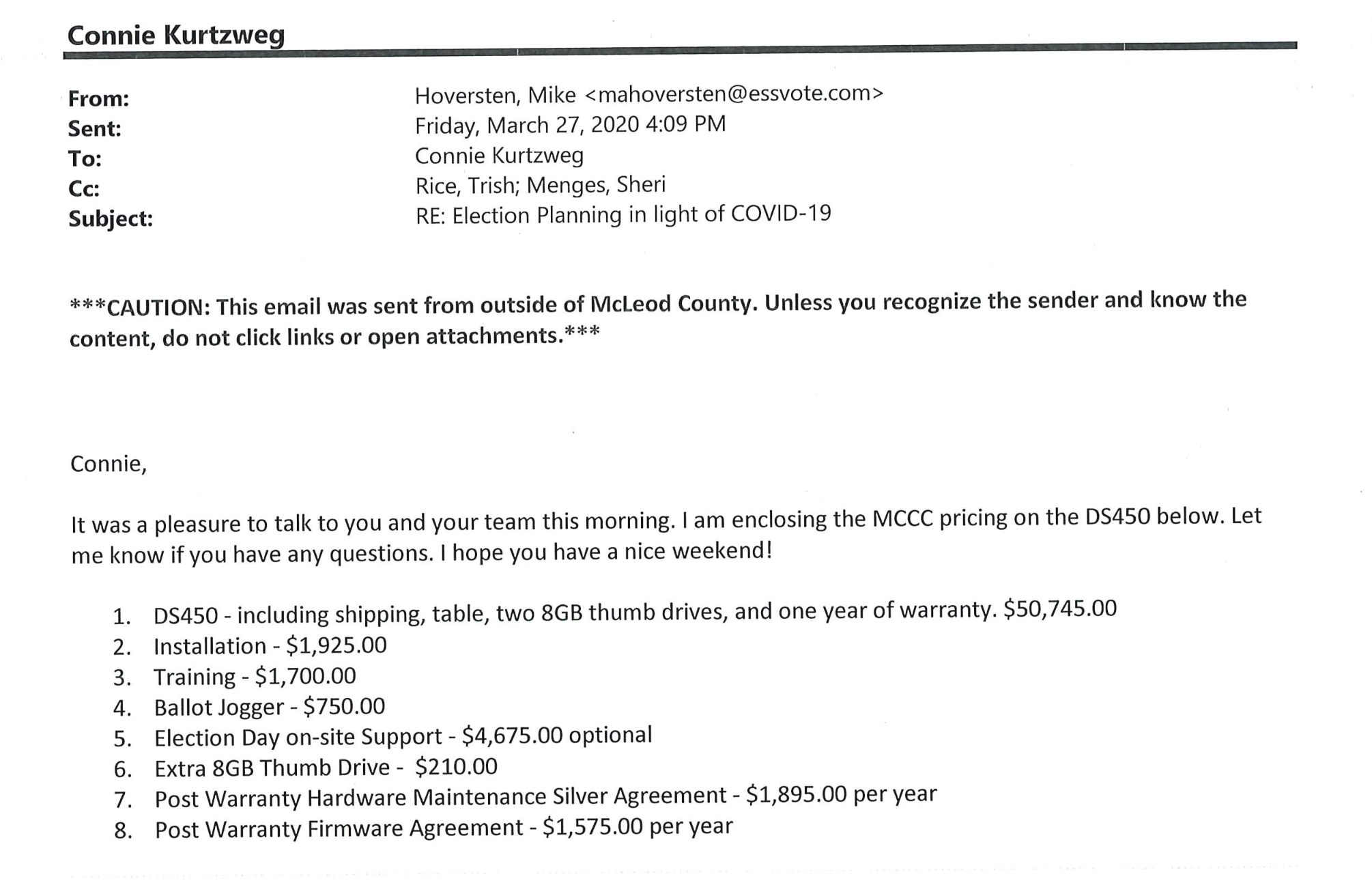
While county commissioners in other states have described these machines as being built in Omaha, Nebraska, both the DS450 and DS850 are made in Germany.
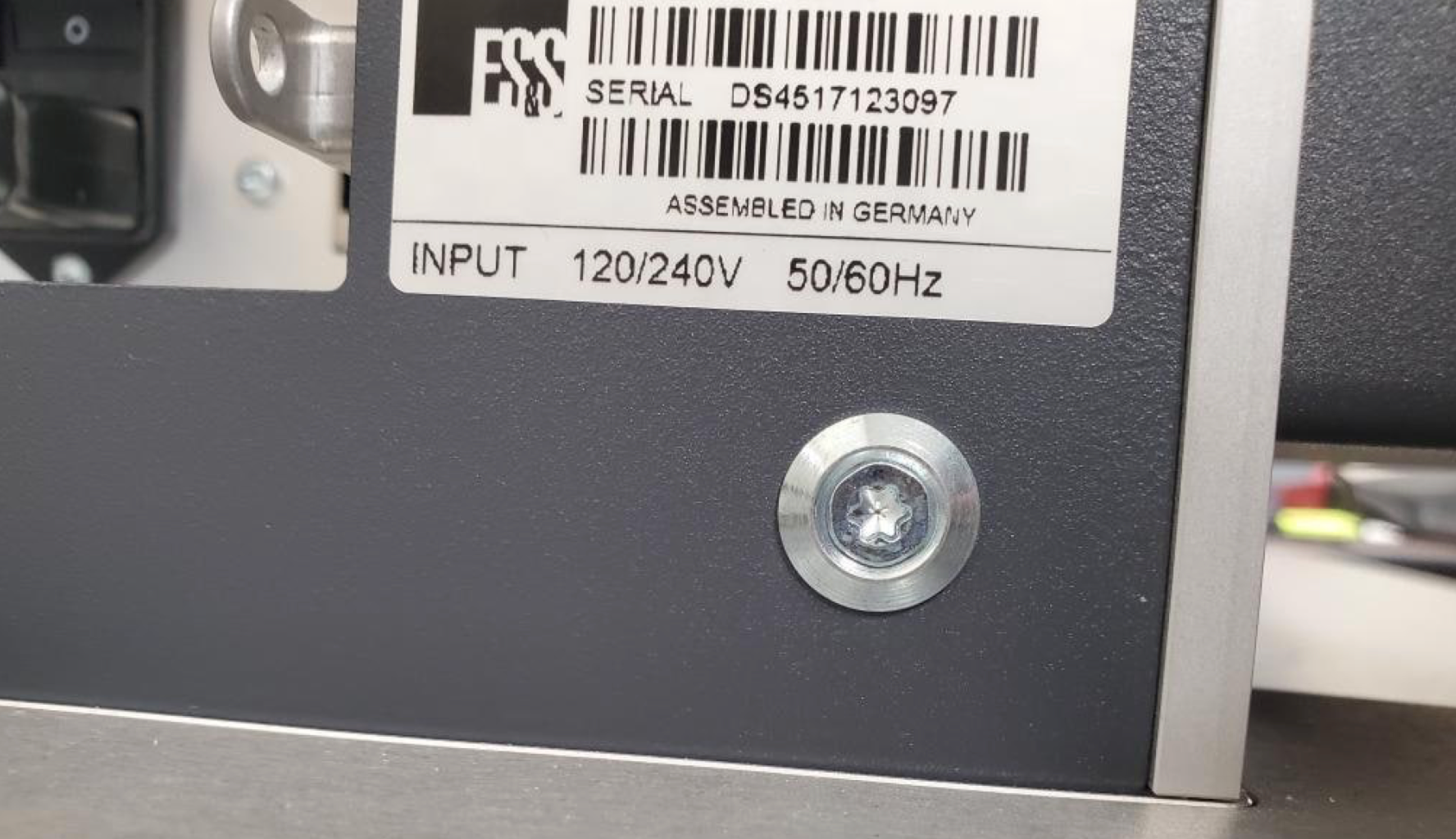
These newer models are quite expensive.
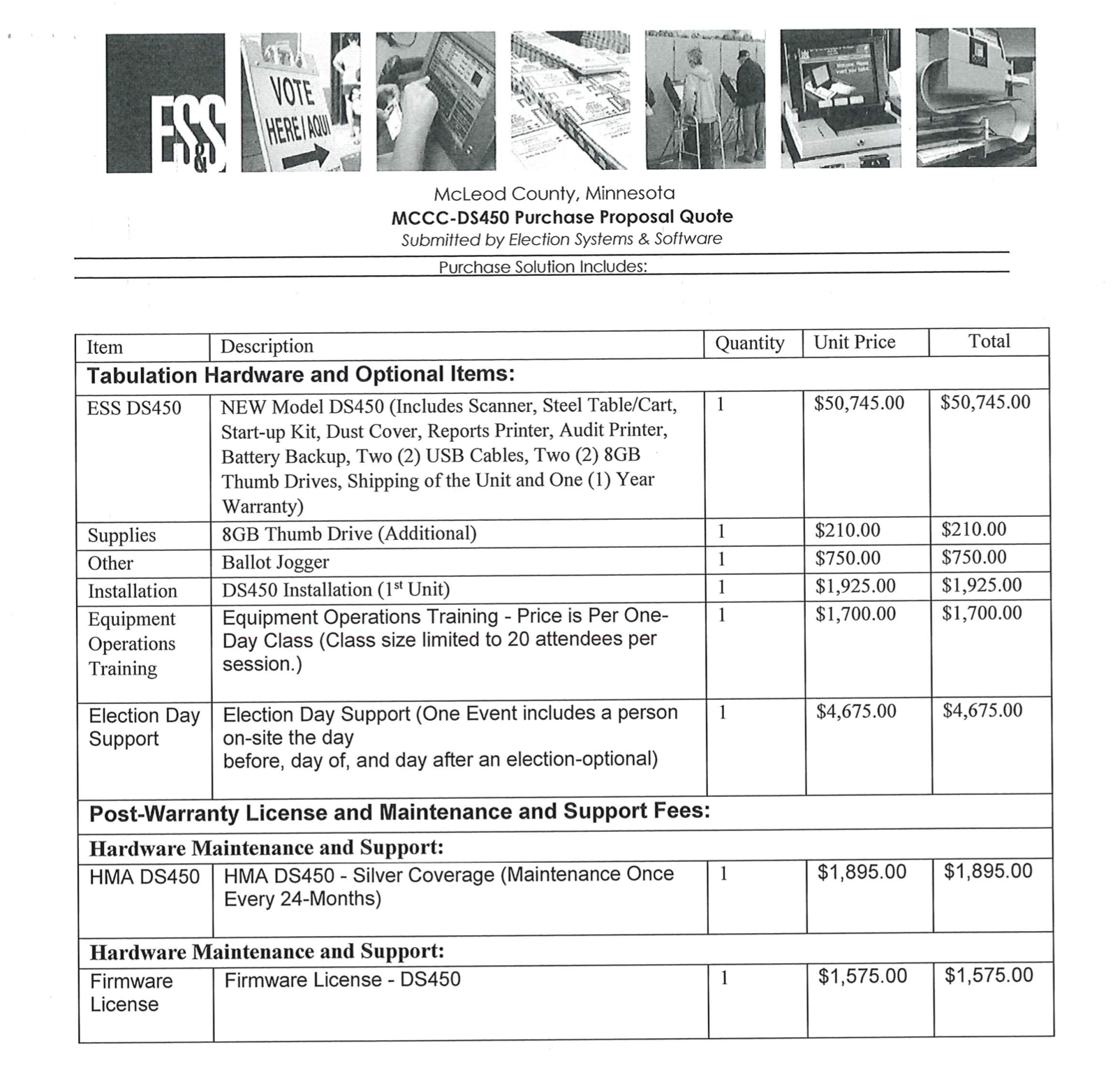
Even the Site Support at $4,250 alone could be repurposed toward 20 election judges at $20 an hour for 10 hours. Many more election judges could be hired with the $50,000 spent on the DS450 tabulator. Furthermore, if we legislatively removed or dramatically shortened the absentee and early voting periods, absentee ballot board work would be reduced and the election process further simplified.
Meanwhile, Saint Louis County recently purchased the DS950, one of the newest electronic voting machines on the market, likely costing about $250,000.
It’s one thing to spend a lot of tax-payer money on vulnerable machines, but another to actually use them correctly. For instance, the DS200 Operator Guide is 222 pages long.
The following two emails between staff at ES&S and the County Elections Administrator in McLeod County demonstrate that there is much vendor hand-holding to maintain and operate these machines.
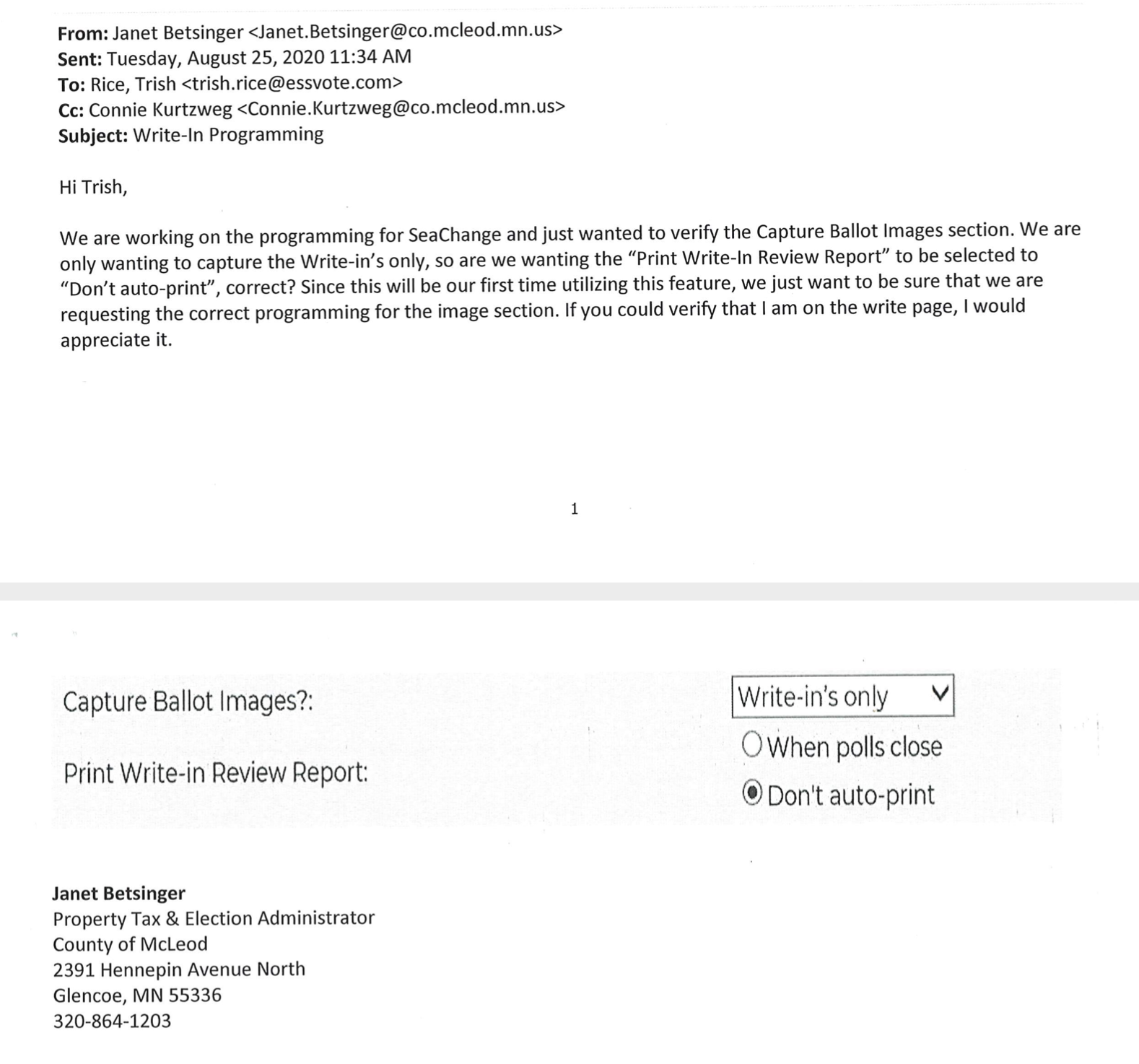
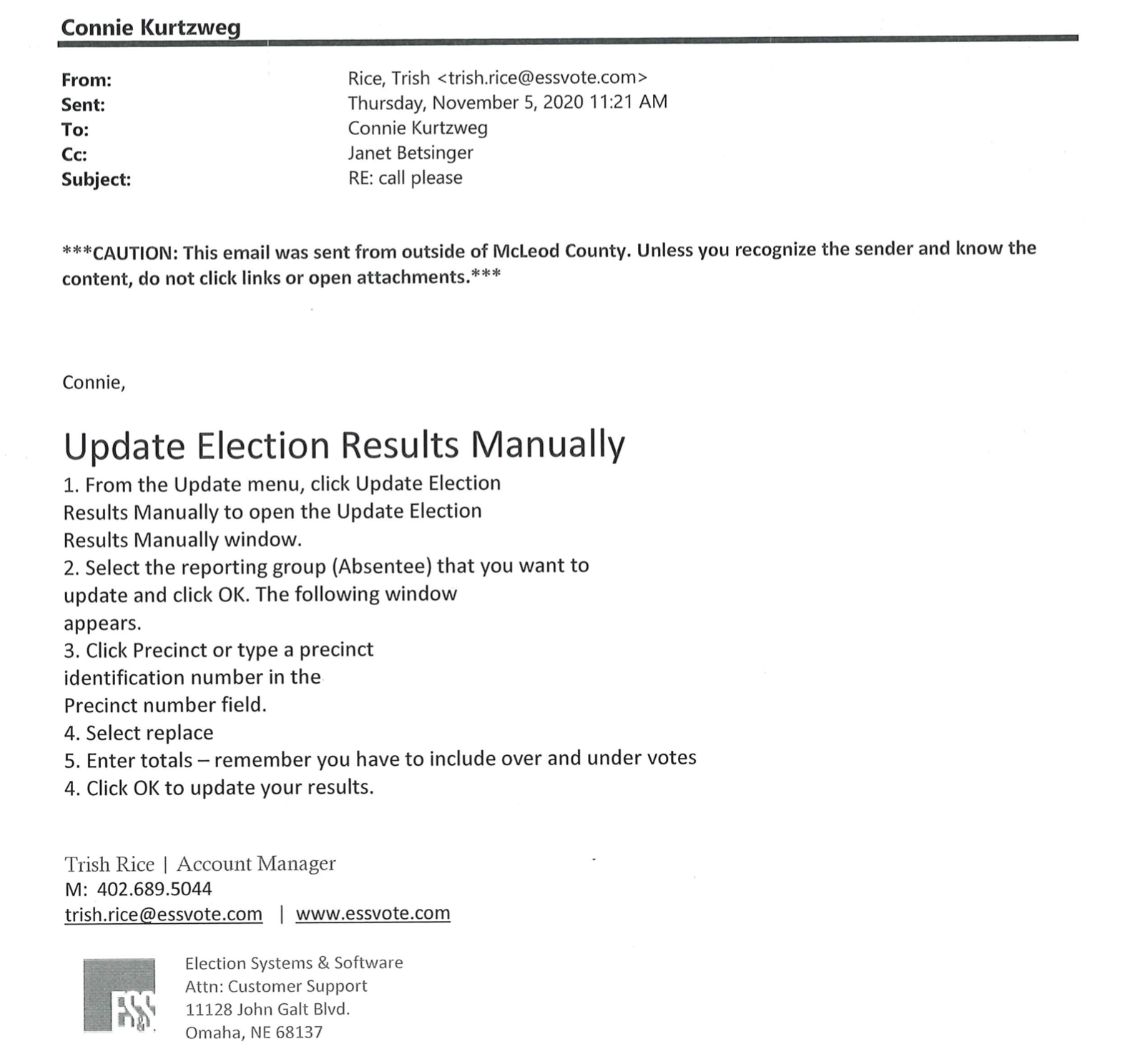
Are we asking too much of our election officials at the county level to not only maintain and operate but also mitigate cyber threats to these machines?
Or is it more likely that case that election officials are outsourcing our elections to the private NGOs, themselves not subject to FOIA requests?
The County Commission Strategy
How can these changes actually happen?
County commissioners have concurrent jurisdiction to govern the overall conduct of elections. Ultimately they must decide whether to use electronic voting equipment (such as tabulators and electronic poll pads) to begin with and, if they do, whether to certify local elections run on insecure hardware and software. For the time being, only hand counting paper ballots minimizes fraud to the fullest extent.
In this video, David Clements, speaking in Rochester on the first night of the 2022 MNGOP state convention (at a separate location), describes the county commissioner strategy. Here’s my take on the same.
Does it make sense to use the same machines in 2020 again in 2022, and again in 2024??
You too can stand in the gap.
Election Judges Don’t Have Much Control
Unfortunately, the responsibilities of election judges—who are not judges, but administrators, or workers—in Minnesota are setup so as not to oversee the key areas where cheating occurs, such as in processing (accepting or rejecting) absentee ballots as part of the ballot board (which lasts 46 days), and in verifying that voter rolls are accurate, and in validating the tallies for each candidate of the tabulators which scan every ballot. In fact, in 2024, even in rural counties like Benton, at least one judge was blocked from certain activities because she was known to pay careful attention.
Election judges are asked to sign oaths and then sign up on the summary tapes that are printed out of the tabulators, however there is no way to verify the accuracy of the vote totals for each candidate. This led some in 2022 to amend what they were signing, refuse to sign, or suggest hand counting to check that the tabulator tallies (not merely the total number of ballots) matched the total tallies for each candidate on the paper ballots. They were often met with stern resistance.
Some even asked in advance, such as three election judges in Anoka County. They were told that hand counting was illegal. When one pushed back, he was fired. The other two resigned in protest.
Meanwhile, I’ve heard a number of stories of people having to take extra steps to be included as either a head election judge or an election judge, even though supposedly there is a great need for them. In 2024, Hennepin County, and many other counties, did not use balanced absentee boards, a violation of the law, although only Hennepin was called to account, and received a slap on the wrist.
As described in the section about hand counting, I believe people will turn out in very large numbers as volunteers to assist in hand counting because they believe in the openness and accuracy of hand counting the votes themselves versus leaving it up to the black box electronics which they are denied access to.
Use Your Platform
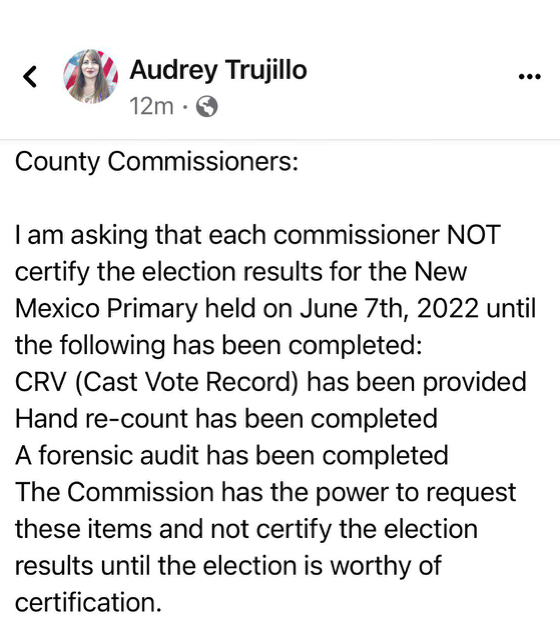
If you know a commissioner, please let them know about the option of refusing to certify the election, even though they will be threatened or told they actually don’t have a choice, that these certifications are in fact ministerial (Black’s Law definition: without discernment). If commissioners don’t certify their counties, then the state cannot certify until remediation is made, perhaps through a detailed micro-audit, to give the commissioners of that county confidence to then go ahead and certify.
If you are commissioner reading this, thank you. You are not alone in reading this as several commissioners already had copies in 2022.
We are already in territory (in other states, like New Mexico) where county commissioners are being put to the test. Are you going to certify your county’s primary election or general election if it is run on machines that have been shown to faciliate fraud?
I am also calling for all America First Candidates to make speaking about the election machines a priority. If you don’t think machines can alter elections, look at Kandiss Taylor’s gubernatorial result in the Georgia primaries. She had 60,000 volunteers but somehow only received 40,000 votes. That could be the power of an algorithm to swap votes.
When you’re evaluating candidates, consider: If candidates are not speaking about issues with our elections, and not answering what they have done or are doing about it, maybe ask yourself, Why aren’t they?
Do You Have A Few Minutes Per Day?
Connect with local groups or reach out to Cause of America Minnesota by inputting your contact info on Cause of America or simply subscribe for free to the newsletter at Project Minnesota - https://projectminnesota.com
Your skills will be put to use in areas such as:
- research
- data analysis
- communications
- media
- outreach (to new members)
- relationship building with towns, cities, counties
- attending local meetings with decision-makers
- meeting other focused on reforming our elections with integrity
When I was just getting into all this I had to learn the basics, such as how to put in a data request, part of our state-level FOIA.

Now, I’m learning that I have specific skills, talents, and working style preferences that can be put to use.
To uncover what yours are, simply ask:
- What are my strengths?
- How do I perform best?
- What do I value?
- What do I believe I can contribute to this project or movement?
Vote in Person
It is important that anyone planning to vote for America First candidates votes in person on election day, as late in the day as possible.
Even if you join the queue five minutes before polls closed, you are legally allowed to vote, even if the line is very long. The polling place will post someone in the line marking the end of the line at the deadline. Everyone in front of that person already at the polling location in their precinct should be allowed to vote.
Why vote in person late in the day?
Because we now have reason to believe that there are centralized mechanisms that through a combination of the statewide voter registration system, the electronic poll pad centralized software, and the scanned barcode when absentee ballots are delivered which allow the powers that be to see the full landscape of who has voted and who has not.
If the vast majority of let’s say republican voters vote very late in the day, say at 5pm or later, then it becomes increasingly difficult to cheat using illegitimate absentee ballots. (I use the word illegitimate because by statute once a ballot enters the system it is by definition legal.)
Therefore, until significant changes occur legislately to limit or ban mail-in voting (absentee could still exist only perhaps for edge cases), I am urging voters not to take the convenient option and vote through absentee or early voting.
If you are in a mail-in ballot precinct, you have the option to deliver your mail-in ballot directly to the county clerk up until 3pm on election day (according to Minnesota Statute 203B.08).
Of course, voting in person doesn’t prevent tabulator vote-swapping or server-based tampering, but it does force those attempting to subvert our elections to resort to electronic methods at greater scale, which is risky.
Finally, considering sharing this book with your elected officials, candidates, county commissioners, city councilmembers, town supervisors, and election clerks to provide context on the depth of the problem we’re facing, and what they can do about it. They can read this book here for free.
Conclusion
“They have a narrative problem.”
— Derek Lind
Most elections in America are able to be rigged and likely have been rigged for a long time. In recent years, with a fully integrated electronic system, the cheater’s toolbox has expanded beyond mere ballot stuffing to more sophisticated approaches. Now, every one of the four components of the election ecosystem, from voter registration, to voter validation, to tabulation, to reporting, can be controlled and fine-tuned to engineer an outcome. Any election can be undermined subtly not only with a high level of precision but also without the knowledge of most voters and most election officials, as we have seen.
Newly [s]elected officials may go on to pass laws which further corrupt an already corrupted process, such as the mandating of electronic voting equipment that have modems inside (which can facilitate fraud) and making the cast vote record ballot images non-public data (removing the public’s ability to audit the tabulation component of the ecosystem): both of these were passed in Minnesota’s 93rd legislative session concluded in May, 2023.
It is possible that manual hand counting, which is part of a transparent solution to a host of present issues with tabulation and reporting, could be banned—indeed, the Minnesota Legislature in 2024 did everything they could except to ban it, probably more deceptive than outright doing so, ordering election workers to “immediately seal” ballots at the close of polls, preventing spot checks or quick hand counts by election judges.
Elections, which were once locally controlled at the county or precinct level, are now in the hands of the state or non-governmental entities, often private corporations. Instead of adhering to stricter cybersecurity standards and rigorous transparent audits, the contracts that counties or collections of counties have with the corporations that effectively determine the outcomes of elections continue to favor secrecy instead of transparency, further eroding trust with the public.
On October 13, 2016, Trump said: “This is not simply another 4-year election. This is a crossroads in the history of our civilization that will determine whether or not We The People reclaim control over our government.”
I do not like everything that the Trump administration did or has done even so far in 2025, but that statement implied that we were heading into uncharted territory. Not a crossroads in America’s history but a “crossroads in the history of our civilization”. Human civilization on Earth. (Because the conflict is likely not limited to the surface of this realm.) “Reclaiming” perhaps because a telling event occurred in 1963 when America’s own intelligence agencies signed off on the assassination of a president who on June 10, 1963 spoke powerfully about peace. “Whether or not” because We the People do have a choice: We can reclaim our rightful and righteous position as a check and balance against the first three branches of government, or we can continue to allow the intelligence agencies and non-state actors to control the flow of information and much else. That would be to act like slaves and be treated that way.
Those who see themselves as the slave owners-those who look down on you who are reading this book—they perhaps do not understand your motivation. Patient persistence towards peace is an everlasting fountain. From that enduring source we are constantly renewed. Unfortunately, all this may not be entirely peaceful, as has been shown especially in recent years where people who have no problem harming children have done so overtly.
This short book has been an update to [S]elections in Minnesota. The original was written briskly across three weeks and published in late June, 2022, with again brief edits made in the summer of 2024. Finally, for now, these edits have been made in a single day, March 9, 2025, as other fictional projects have taken precedence to more attractively draw the public into the depths of the control that has been put on them in the election domain.
The good news is, that as Derek Lind of Ramsey has said, “They have a narrative problem.” Most of those defending the electronically-controlled, mail-in heavy system tend to omit inconvenient facts or outright lie about the dangers of the status quo. Even Secretary of State Steve Simon has had to answer questions in multiple counties about reports of advocates advising going to paper poll books instead of the centrally-accessible electronic poll pads from KNOWiNK. It’s only a matter of time before more cities follow in the footsteps of Oak Grove and Ramsey in Anoka County, who have cancelled their leasing agreements with the county. Indeed, even the commissioner level education and courage is increasing, with 2 Anoka County commissioners voting on February 25, 2025 NOT to buy the KNOWiNK poll pads, one citing the possibility of scalable fraud and the other prefering the cities had a choice.
These stories and more are likely to be found on Project Minnesota or in the aforementioned fictional books to come.
For an example of these fictional approaches to rediscovering the truth, see the last chapter in this book, where Susan is called to a hearing in April of 2021, anticipated as an excerpt in an upcoming book detailing judicial and legal interference with public oversight of elections.
Thank you for reading [S]elections in Minnesota. The digital versions, both written and audio, will remain free forever. If you enjoyed it, please share it with a friend, even a brand new friend.
Appendix - A Year in Beijing
As the two buses converged from the left and right into our lane I wondered whether this road was safe for bicycles. When we’d agreed to tea fifteen minutes prior my family wasn’t expecting to navigate a minor highway on two wheels. Our tour guide slipped through the gap, not far behind were Mom and Dad who decided to go for it. My brothers and I were forced to brake and cars behind us honked, not in solidarity, but at least they didn’t hit us. Losing sight of Mom and Dad as the buses zipped the lane shut, I briefly imagined them being crushed. Moments later, materializing out of the cloud of exhaust on that hazy winter morning were Mom and Dad and the guide, each still in their saddle. It was 2005 and there were far fewer bikes in Beijing than I’d recalled in our 1998 visit. Just before the people’s uprising in Jakarta prompted Suharto to step aside from the Presidency after a thirty-two-year reign, on one day’s notice we flew into Singapore; after receiving word that school was canceled for the year, we decided to visit China for the first time.
Seven years later, we were residents on a bike tour. Now off the main road, we navigated tight alleys connecting traditional courtyard residences in Old Beijing, some dating back to the thirteenth century. Parking next to a red door beneath a slanting tiled roof, our guide knocked and announced us. A smiling, elderly woman answered and soon we stepped over the threshold into a quiet courtyard anchored beautifully by a gently swaying tree. We were shown to a small room a few steps further along. We did not take off our coats, as there was no heating (or insulation) but here at least the walls sheltered us from the wind’s bite. We were all keen for the hot tea soon set before us but especially thankful was my older brother whose frozen hands around the cup were eventually thawed, albeit painfully. We sat around a low stone table and sipped our tea while our guide translated our host’s words, including her family’s history, and what life was like in her community. I don’t remember the details, only the feeling. Having expended considerable physical effort and survived both the elements and the attempted bus squeeze, we were as travelers taking temporary refuge from a storm, content for simple pleasures. My Chinese was the best it has been, but only hai keyi, not good enough to verify everything our guide translated. Even so, we were soon transported through time by our host’s tale.
After receiving my high school diploma from the International School of Beijing in 2006, I soon returned to the United States to attend college in Minnesota. In short order however I learned that back in the Chinese capital several thousand traditional homes just like the one we’d visited, along with their more than seven hundred years of history, were bulldozed. Officially this was done to make room for sports venues and other infrastructure for the 2008 Olympic Games, but word on the street was that the Party was embarrassed by the hutong, which were viewed as downtrodden and often occupied by the poor. (Not unlike the opinion voiced by Hillary toward ‘deplorables’ on the campaign trail, a metaphor attempting to degrade not only Middle America, the heartland, but also We the People everywhere.) I learned that the residents, at the time of their evictions, were not compensated appropriately to the point that they couldn’t easily find other places to live.
We lived in Shunyi District, a rural area east of Beijing. The street between our school and the local villages was still covered in fall by corn kernels laid to dry by farmers. In their neighborhoods my new school friends once treated me to a plentiful noon meal for about a dollar a person.

It was not clear how long these rural areas would last as the city expanded eastward toward us. I remember large clusters of residential apartment buildings rising quickly from the landscape, one day webbed by bamboo scaffolding, completed the next. To this day I wonder how many of the workers who toiled all day and through the night were not Chinese but North Korean workers on surreptitious loan. The pace of building in the last decade contributed to the ghost city phenomenon; the sociological manifestation of a “one child” policy the Chinese ruling class boasted of—as the rest of the world shrugged its shoulders. While my two brothers and I sat in a tea shop near the Terra Cotta warriors museum in Xi’an, a plate of melon arrived without our request, the server murmuring “san ge, san ge” (three) as she stepped away. While China’s one-child policy destroyed families and removed the ability to create generational wealth, policies in America undermined families from a different angle, incentivizing single-mom families and attacking the very idea of man and woman.
Prior to our arrival I knew little about China. When I shared my family was moving to Beijing, my history teacher in Houston remarked, That’s interesting. You know, China is a Communist country! Actually, I didn’t really know. I thought the term merely referred to an economic system. At age seventeen without the context of Communist disasters throughout history, I was going in blind.
It would take years for my eyes to be truly opened. But my first glimpses of understanding came in the usual ways: exploring my surroundings, conversations, books. With my adventurous mother I hiked the wild sections of the Great Wall and glimpsed how the people lived in the villages nestled against the ancient divider visible from space.
I’ve since learned that the Great Wall was likely built quite recently, perhaps in 1950, by the Communists, and then said to have been built much earlier, as a result of reading the foreward to AT Fomenko’s Chronology 2, highly recommended.
On my return in 2008, I chatted with migrant workers outside the gates of East China Normal University in Shanghai while they cooked dumplings or slapped dough on the inside of a metal barrel. The bread man travelled daily from outside the sprawling city, here standing all day in the cold and frequent drizzle to sell portions for a quarter a piece. I bought a decent amount but in my defense, he was competing with other food sellers. I came to learn through my classmate Deanna’s research that he was one of approximately 300 million migrant workers throughout the country, at the time equivalent to the entire population of the United States. The international press lauded the country’s economic growth but there was a tragic number of people yet to rise out of poverty. China’s economic growth, of course, came at the detriment of America’s economy and the overall quality of goods. At Christmas in recent years, my dad opened a small metal tin to reveal wooden toys, still beautifully preserved, which had entertained him for many hours during his childhood.
Present day China was rough on the people, but their near-term past was arguably tougher. Mao’s policies devastated the country and as a result tens of millions of lives were lost. The chaperone of a 2008 trip, an economics professor who grew up during the Cultural Revolution, shared with me how she and her grandmother hid in the kitchen stove when Mao’s Red Guards showed up unannounced and took her father away; he was never to be seen again. In Ji Xianlin’s The Cowshed: Memories of the Chinese Cultural Revolution, I learned how a once-respected professor was interrogated by his own students and made to build a holding cell for he and fellow intellectual colleagues labeled class enemies. These were commonplace experiences, normalizing total control of the mind and body for what no one in their right mind (not even Mao) would truly suffer. The total control of the Chinese population was first instantiated in fear, then through elections, establishing a uniparty governance model since the foundation of the Chinese Communist Party (CCP) in 1949.
While I didn’t have a robust understanding of the comparative political models in question, I knew that Beijing wasn’t a place I would ever want to live for very long. Evenings walking our neighborhood I wondered whether the guards were there for our safety or as our monitors. In our living room, below two fire alarms, the purpose of the second my family never did surmise, the television regularly went static at any mention of China. Our church services were held in a conference room inside the neighborhood since there were no Christian churches; Chinese nationals were forbidden from attending.
When I moved back to the United States of America, though my understanding of this country’s founding was still murky, I had a deeper appreciation for the spirit of freedom, central to our founding and identity. It must be said that this yearning not to be a slave is alive and well in many places I’ve traveled, including China, where I’d just moved from.
Excerpt: Susan Called to Hearing
The courtroom in St. Paul smelled of polished wood and stale air, a faint whiff of lemon cleaner clinging to the benches as Susan Shogren-Smith stepped inside. It was April 9, 2021, and the morning light slanted through the tall windows, catching dust motes in a lazy dance above the gallery. She adjusted her blazer, smoothing the fabric over her arms, and took a seat at the counsel table, her legal pads and folders stacked neatly in front of her. The room was quieter than she’d expected—no buzzing crowd, just a handful of lawyers and court staff murmuring in low tones. The Zoom feed hummed faintly from a monitor in the corner, a concession to the lingering shadow of COVID that still shaped how justice was dispensed.
Susan’s stomach churned as she glanced at the judge’s bench, empty for now. Judge Castro would be here soon, and she still couldn’t shake the question gnawing at her: Why this? Why now? She’d filed the election contests back in December, racing against a seven-day deadline after the Minnesota State Canvassing Board certified the 2020 results. She’d poured everything into them—affidavits from sixty counties, evidence of missing ballots, violations of election law—all to get the Supreme Court to stop the certification. But they’d dropped it without a whisper of a hearing, no evidence considered, no questions asked. So why was this hearing happening, months later, over a single contestant’s complaint? And why was Corinne Braun—Nick Brown now, she reminded herself—making such a fuss about it?
She flipped open a folder, her eyes skimming the affidavit from Corinne, or Nick, dated February 21. “I was unaware of my involvement,” it claimed, a line that stung like a slap. Susan had trusted Jose Jimenez to handle contestant communications, just as they’d agreed—he’d founded the Minnesota Election Integrity Team, recruited the volunteers, promised to sign onto every contest she drafted. She’d built the cases on his assurances and the affidavits he’d sent her, each one signed under penalty of perjury. Corinne’s signature was right there, clear as day, contesting Ilhan Omar’s election. So why the amnesia now? Was this retaliation for daring to challenge the system? Susan’s petition to the Supreme Court had rattled cages—maybe too many.
The bailiff’s voice cut through her thoughts. “All rise!” Susan stood, her knees stiff, as Judge Castro swept in, his black robe billowing slightly. He was a wiry man, mid-fifties, with sharp eyes and a jaw set like he’d already made up his mind. He settled behind the bench, nodding curtly. “Be seated. We’re here on a Rule 60.02 motion, case 62-CV-20-5602. Let’s get started.”
Susan took a breath, glancing at Jose Jimenez, who sat a few rows back, his suit crisp but his expression tense. She’d asked him to be here, hoping his testimony could untangle this mess. He knew the MNEIT’s inner workings, knew she’d acted on his direction. If Castro would just let him speak, they could clear this up—prove she hadn’t fabricated anything, hadn’t “bamboozled” anyone. But as the judge shuffled his papers, her hope felt brittle.
Erick Kaardal, Corinne’s attorney, rose first, his voice smooth and clipped. “Your Honor, my client, Ms. Braun—Mr. Brown now—seeks relief under Rule 60.02. They were listed as a contestant without consent, a clear fraud on the court. We ask to proceed strictly on this motion to remove them from the case.”
Castro nodded, his gaze flicking to Susan. “Ms. Shogren-Smith, you’ve seen the order for this hearing. Response?”
Susan stood, her notes trembling slightly in her hand. “Your Honor, I filed a motion for a continuance earlier this week. Mr. Brown submitted a 49-page document just an hour ago—12:56 p.m., to be exact. It’s new evidence, and I haven’t had time to review it. I’d ask for a postponement so all parties can respond fairly.”
Kaardal cut in, his tone sharp. “We object, Your Honor. This is a simple 60.02 motion. My client wants off this lawsuit—nothing more. Delaying it raises jurisdictional issues we’d rather avoid.”
Castro leaned back, tapping a pen against his desk. “I haven’t reviewed your motion, Ms. Shogren-Smith, but based on what you’re saying here, I’m denying it. We’re moving forward. Mr. Kaardal, your client’s position?”
Kaardal gestured to the Zoom screen, where Corinne—or Nick—appeared, their face framed by a plain background. “Mr. Brown will testify, Your Honor.”
Susan’s pulse quickened. She’d wanted this—to question Corinne, to get to the truth—but Castro’s next words stopped her cold. “I need to understand Mr. Brown’s position better,” he said, peering at the screen. “And I’d like advice from the lawyers present. But let’s keep this focused. Proceed.”
Corinne’s voice came through, steady but clipped. “I just want to be removed from the contest, Your Honor. I got an email from the MNEIT saying if I wanted to contest the election, I should sign the affidavit. I read it, filled it out, signed it—said I was contesting Ilhan Omar’s election. I emailed it back. But I didn’t know it meant all this.”
Susan’s breath hitched. That was it—Corinne had signed it, knowingly. She opened her mouth to speak, but Castro raised a hand. “Hold on, Ms. Shogren-Smith. We’re on the 60.02 motion. I need to establish if all three named plaintiffs—Mr. Brown, Ms. WH, Ms. SS—were properly included.”
He turned to Susan, his eyes narrowing. “My concern is whether a fraud was perpetrated on this court by adding plaintiffs without an attorney-client relationship. Ms. Shogren-Smith, did you discuss filing this lawsuit in their names?”
Susan straightened, her voice firm. “Your Honor, I relied on Jose Jimenez, the lead attorney for the MNEIT. He provided me with signed affidavits from each contestant, including Mr. Brown. I—”
“Did you discuss it with them?” Castro interrupted, his tone biting. “Do you know what a discussion means?”
“Yes, I know what a discussion is,” Susan replied, heat rising in her cheeks. “I—”
“Did you discuss it with them?” he pressed again, cutting her off. “Yes or no?”
Susan hesitated, her mind racing. She hadn’t spoken to them directly—that was Jose’s role, per their agreement. “No, Your Honor, but—”
“No further explanation,” Castro snapped. “Yes or no questions. Did you have their consent to file?”
“I believed I had their consent through Mr. Jimenez,” she said, her voice steady but tight. “The affidavits—”
“Do you understand what it means to be an officer of the court?” Castro interjected, his voice rising. “Answer me.”
“Yes, Your Honor,” Susan said, her throat dry. “I—”
“Then why didn’t you verify this yourself?” he demanded. “If you refuse to answer, I’ll hold you in contempt. Do you know what that means?”
“I do,” she said, forcing calm into her tone. “I’d like to state for the record that these questions are being asked to pigeonhole me, misrepresenting what actually happened. I acted on Mr. Jimenez’s direction, as lead counsel. He’s here—he can testify to that.”
Castro’s eyes flicked to Jose, then back to her. “I’m not hearing from Mr. Jimenez right now. I’m hearing from you. Did you personally contact these plaintiffs?”
“No,” Susan admitted, her hands clenching the edge of the table. “But the affidavits—”
“I don’t care what you believed,” Castro said, his voice cold. “Is this how you typically pick up clients, Ms. Shogren-Smith? Sending emails through someone else, filing complaints without speaking to them? Have you done this before? Or was your cause greater than your duty as a lawyer?”
Susan opened her mouth, but he waved her off. “You don’t need to answer that.” He turned to the other attorneys—Kaardal, Zoll, Hartshorn—his tone shifting. “What should I do with this case?”
Zoll, representing the state, shrugged. “It’s a nullity, Your Honor. No plaintiffs, no case.”
Castro frowned. “If it’s a nullity, does that wipe the record? My administrator knows more about that than I do.”
Hartshorn, from the Secretary of State’s office, chimed in. “We’d prefer the record stay, Your Honor. Legal issues were raised. The cost judgments should stand too.”
Zoll nodded. “Agreed.”
Castro leaned back, his gaze settling on Susan. “My prime concern today is protecting these three plaintiffs who were—well, I’m not sure what word fits—bamboozled, perhaps. And I’ll note for the record how quickly those judgments were paid after my 60.02 motion.” He paused, his voice hardening. “Based on what I’ve heard, I have no choice but to conclude Ms. Susan Shogren-Smith perpetrated a fraud on this court. Under my inherent authority, I’m sanctioning her $10,000.”
Susan’s breath caught, the word bamboozled echoing in her skull. She glanced at Jose, his face pale, but Castro wasn’t done. “We’re adjourned,” he said, banging the gavel. The room erupted into murmurs as he swept out, leaving Susan rooted to the spot.
She gathered her papers, her hands shaking. Targeted, she thought. They’re punishing me for the Supreme Court petition. Corinne’s flip-flop, Castro’s refusal to hear Jose—it all felt orchestrated. She’d fought for transparency, and this was the cost. As she stepped into the hallway, the weight of it settled on her shoulders, but her resolve hardened. They could call her a bamboozler, fine her, threaten her license—but she wouldn’t stop.
